We are celebrating the end of the decade through lists, essays, and mixes. Join us as we explore the music that helped define the decade for us. More from this series
“I can hear everything. It’s everything time.”
Here we are, floundering at the tail end of the decade, grasping to make sense of the last 10 years, when that ancient quote (actually from Gang Gang Dance in 2011) had already provided this decade’s temporal framework for what feeling and existing might look like this decade. This quote, this foundational assumption, presaged this decade’s perceptual and material eruptions of sounds, of images, of ideas, of bodies; reducing our grandiose theories into beautiful yet fairytale simulations of purity and vanity — into rain and glitter. It was a statement, but also a warning, heralding — perhaps even willing into existence — what was to come: a decade both explosive and incomprehensible. It was everything time, and we could barely handle it.
Time, this decade, figured as much into our writing as words themselves — even when we didn’t realize it — and the same could be said of its music. Many of our early favorites this decade, from James Ferraro to Ariel Pink to Oneohtrix Point Never, would effectively swap traditional notions of musicality and engage directly with phenomena like nostalgia, cultural memory, and the corresponding junk left behind. No longer just a simple, comprehensible repository for things that happened, the past became part of the exclusive present, because distinguishing between the two increasingly felt like what time eventually does to the differences between 3rd and 4th grade, or what increased distance does to rocks and pebbles. Our past was not just aestheticized for apolitical nostalgia, ironic indulgence, or mindless repetition; the past was restaged, reperceptualized as a disruption in our listening, calling into question our entrenched, vestigial expectations concerning “originality” and taste. The results were sensually provocative and perverse, sometimes even confoundingly rote, but it infected the entire decade, offering dynamic, multilayered ways to not only subvert our temporal orientation, but also explore how affect itself could challenge our assumptions about resistance under capitalism.
And indeed, most of our favorites this decade didn’t hinge on signaling their politics. (Didn’t need them to either. We have plenty of ways to know when we’re getting fucked.) From vaporwave’s radical appropriations and Kanye’s destructive provocations to PC Music’s wild HD pop experimentation and Dean Blunt’s drifting, ephemeral gestures, this decade’s most controversial musics — at least the ones we cared most about here — were not marked by political upheaval or rupture, but by ambivalence and ambiguity, even uncertainty. This decade, it was OK to not know whether you “liked” something or understood what was “meant.” It was OK to not be able to envision a future because our depictions were always-already anachronistically displaced. It was OK to not force yourself to choose between celebration or rejection, because our art’s value was in perpetual oscillation. Music, here, was quickly dematerialized, reterritorialized, and re-coded for algorithmic consumption (18+), collapsing and folding into itself (E+E), stumbling into bizarre juxtapositions (DJ Rashad), calling attention to the medium itself (D/P/I), and vomiting brilliant recombinations (Klein). This restaging of aesthetics happened almost instantaneously (Lil B), sometimes accidentally (Farrah Abraham), and oftentimes originating from and rapidly reproduced by quick-witted, meme-savvy teens who had no reason or incentive to explain themselves.
So, yes, sometimes it was about having faith in the creative output. But other times, it was about having faith in selves. In this decade, it was okay to cry, to embrace our E•MO•TIONS, to vamp on our mercuriality. In this decade, death was real. Representational and symbolic exchange is always subservient to material transformations, and some of our favorites offered quite devastating ways to mourn, from Carrie & Lowell to A Crow Looked At Me. Still others deepened how we relate to our bodies, uncovering new materialities and new compositions (Elysia Crampton), exploding our “normative biopolitical imperatives” (SOPHIE) and “demanding transmutation” (Arca). We witnessed this shift in many of the artists on this list, and some of us underwent (and are currently undergoing) this shift ourselves. And yet we were constantly reminded that our bodies, while forever expressive, were also forever exploited. They were trapped in “corrupted relations that exist between postcodes” (Babyfather), hopelessly tethered to the “elaborate wretchedness of humankind” (Scott Walker). Who-we-are was in conflict with what-we-do, and the ambient technologies that enabled much of our communication this decade provided exactly the kinds of platforms that would encourage not civic participation, but data generation. Before we knew it, “taking a chance” meant adding a new brand of deodorant to our shopping cart. Welcome to the future?
If the correlate of a past that’s endlessly reproduced is a future that never manifests, perhaps imagined futures simply lost their critical role and had become junk themselves. Perhaps they were simply cultural artifacts rendered meaningless through a technological materialism that offered both sensory replenishment and heightened temporal awareness. The future, just as with the past, was not immune to the aestheticization process, as shown in our decade’s obsession with futurity. But sometimes all it is is scope — rocks and pebbles. Because if we zoom out — from the days to the months to the years, to the decade and beyond — what we find in the chase for that elusive wholeness, that unifying element, is that the thing that gets you to the thing has always been another thing. Music, for us, was one of those things. We often framed it with theory, but we felt it as desire, and it dripped from our ears, like nectar. A sweet, sticky, golden everything. While music articulated the complexity of our feelings this decade, changing us from the inside until our insides were inside-out, it also reminded us of a simple yet paralyzing tragedy of personhood: the moment we’re always waiting for is likely a replica of one we’ve already felt — and may never feel again.
This is what time does. It eventually renders even our most obsessive desires moot, as we move from crisis (financial) to crisis (ecological) to crisis (individual). Everything is fleeting. But unlike the first decade of TMT’s existence, in which it was often marked by privileged discernment, “intellectual” curation, and faith in the noisy subversion of capital (look how that turned out), this decade we strove for disunity, telepresence, and multiple perspectives: how our lack of consensus made room for possibility; how we embraced trends and transition in a time of sensory abundance; how fluid identities could emerge through syncretism, hybridization, and bottom-up subacculturation; how we practiced embodiment to tell cute stories about affect, movement, and sensation; how nuance offered passageways to our own materiality; how our music provided counternarratives and problematized notions of truth; how noise was no longer our noise (but was actually our noise all along); how we found in our music semblances of healing and palliative care in response to some exhausting, though not unprecedented, years.
We all know how those later years felt at home, under the covers, anxiety draining our souls, but those very same years felt different while clicking around on the web. Time plays differently here. In virtual worlds like Second Life, time has no immediate aesthetic effect: nothing crumbles, nothing washes away with time. Even if all of the avatars staged a mass exodus, it remains preserved forever in its eerily pristine, uncanny state until intervention, whether it’s a code update, through technological obsolescence, or actual physical disconnection of its servers. In our world, here at Tiny Mix Tapes, time shows itself in our digital ruins, manifesting as technological breakdown and incompatibility: broken images and incorrectly rendered text, conflicting coding languages and unreadable characters, dilapidated streaming embeds and exhausted hyperlinks pointing to a musician who may or may not have ever existed. It’s long since happened to early versions of the site, going back to our Geocities days in 2001, and we can already witness this process happening even in the posts we published this decade. The digital deterioration is real, and it’s both haunting and beautiful: the former because our identities become threatened by a past that eats away at itself, and the latter because the deterioration will eventually create space (physical, emotional, virtual) for something new and different.
This is something to celebrate. This is what we want (even if it’s fake). TMT wasn’t made to be projected into the future, nor was it made to be a forever lasting anything anywhere. That’s what plastic’s for, and there is beauty in letting go. Who knows what the next decade will bring, but as this one comes to its anticlimactic close, bringing us no closer to truly understanding our world but perhaps closer to accepting and embracing our eventual deterioration, the truth is, we don’t even have to think about music anymore. Words are just words that you soon forget (Laurel Halo), and while we all do stuff, sometimes stuff does itself (PC Music). If our most prolific artists (Lil B, Dean Blunt) taught us anything about excess in a supposed age of specialized, niche-driven taste — a marketer’s paradise, by the way — it was that we’re all really just amateurs, winging it. We love theory and criticism, but they alone won’t save us from anything. All we can say with confidence is that, past the cultural explosion and incoherency of this decade, through the blurriness of everything-time and its spectral hold on how we perceive the world, we here at TMT feel overwhelming gratitude: for the time we spent together as a scrappy yet passionate family of “writers,” and for the time we spent sharing with you, “the readers.”
Sincere thanks to all of you out there. We are eternally grateful that anyone anywhere was willing to join us in this experiment in criticism and music writing. <3
To close out the year, we are sharing our Favorite 100 Music Releases of the Decade. It was compiled from individual lists by current writers and some former, with minimal intervention. To prevent every single Dean Blunt release from occupying a spot on the list, we imposed a limit of two releases per moniker. So, yes, this means that many favorites are missing (find some of those here, here, and here). We apologize for any inconvenience this may have caused.
100
John Maus
We Must Become the Pitiless Censors of Ourselves
[Ribbon/Upset The Rhythm; 2011]
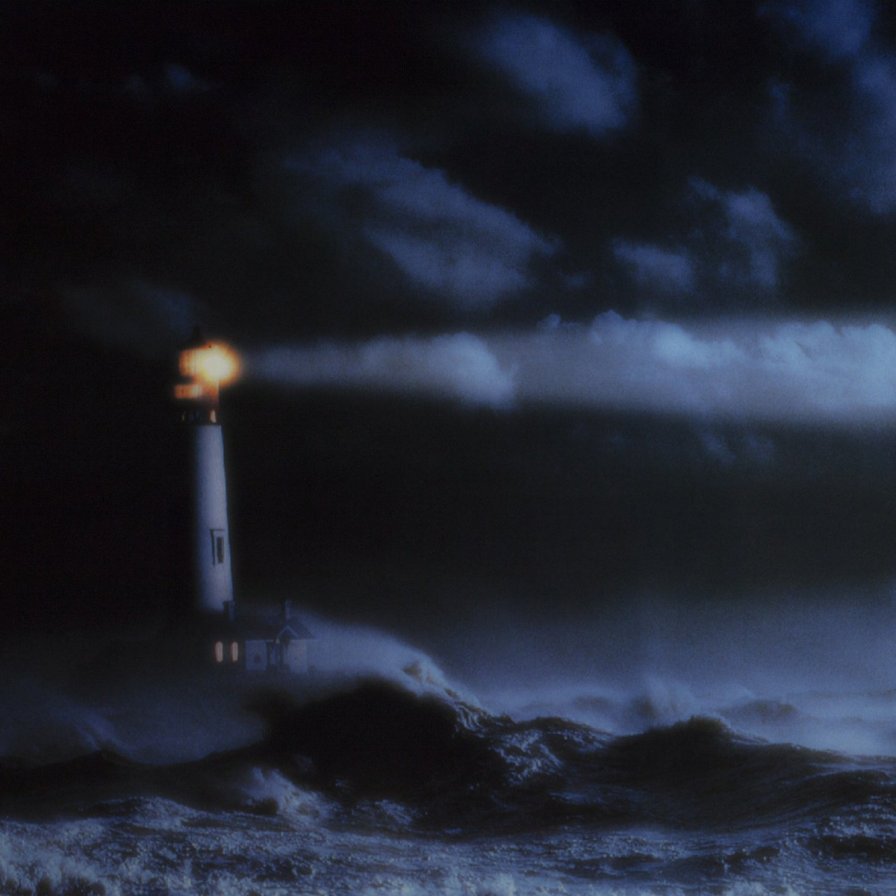
Find a free text-to-speech. Copy this blurb into it, pick the homie “Charles” (he has the best voice), and press play. Now, close your eyes and listen. Envision a Lazy River that would top a Travel Channel “best of.” Now immerse yourself in it. The water temperature sits in that sweet spot between “little more than lukewarm” and “first step into the shower” — the Maus Zone. Can you feel it? Let the river flow through you in its unique, tantalizing ways — it has an innate fluidity that could both kickstart a party with friends and cause you to cry driving alone on the Florida Turnpike. Now imagine nearby innertubes playing analogue synth and spoken word tapes of Alain Badiou until slightly deflated, and then listen for a piercing guitar lick here and a synth wail there. This is the music of the Maus Zone, and at the turn of the millennium, this completely ecstatic, life-affirming sound expressed itself as We Must Become the Pitiless Censors of Ourselves. It was, and still is, worth every moment.
99
Kara-Lis Coverdale
Grafts
[Boomkat Editions; 2017]

In recorded music, there is always an end. We’re keenly aware of it, and that expectation of a conclusion, of a piece ending, is integral to how we experience music. But on Grafts, Kara Lis-Coverdale used some type of magic that we couldn’t quite explain. Every time we listened, it was as if we had entered a timeless vacuum. There was nothing around, except a moving, glittering display of heavenly lights splayed all around, lapsing over each other like waves. It was like the packaging was gone. Rather than feeling anxiety over its impending end, we felt in control, as if we could stay in “2c,” “Flutter,” and “Moments In Love” forever. But, despite the poignancy of Coverdale’s spell, the music didn’t go on forever. We could always go back and stare at the lights as long as we were around — and we often did — but there was indeed an end. There is always an end.
98
Pusha T
DAYTONA
[G.O.O.D. Music/Def Jam; 2018]

Pusha T’s DAYTONA served a perfect course and deserved a star from the tire people. What was not to like? Pusha’s calligraphic, unmistakable flow; a chef with a savory cut in rare supply. Kanye’s taste in suppliers, his attention to detail on every beat. The love for the material, the proportions; it all mattered. Every bite worth taking. Each piece a scrap of soul worth more than its weight in gold. A life told in layers — the tarnish, the beauty, the new material between. Hold still and sense his history. Organic poetry. Hot sauce and tennis balls. Life baked in. Ye rang out. Reduced, condensed. Perfect timing, perfect amount of heat. Stopping just short of too spicy. Haute suite. Look, there’s obviously still gonna be some things that only T gets to know. But it went deeper than that. You can’t teach it, you know? DAYTONA, this little thing. Can I have some more?
97
Deerhunter
Halcyon Digest
[4AD; 2010]

Here we are, nearly a decade down the road from the release of Halcyon Digest, and the album has littered my personal memory databank with traces of its 11 marvelous tracks. Miming along to the saxophone parts on “Coronado” while standing on the lawn of my decrepit college house. Soaking in the isolated stillness of “Sailing” to accompany feeling like my heart had been punted across New England. Closing my eyes in Webster Hall and being lifted to the sky as “Helicopter” folded over itself and exploded in inevitable breathtaking fashion. Honestly, it feels quite fitting, as Halcyon Digest was itself an album of memories, hazy recollections of past lives both real and imaginary. It was pictures and words and designs, cut out of old magazines and rearranged into something new. Cover versions of Golden Oldies that never existed. It was hearing “Desire Lines” for the 60th-odd time and wondering yet again if one day it would be physically possible for humans to live inside of a song. Something fleeting and ephemeral etching itself into permanence.
96
Bill Orcutt
A History of Every One
[Editions Mego; 2013]
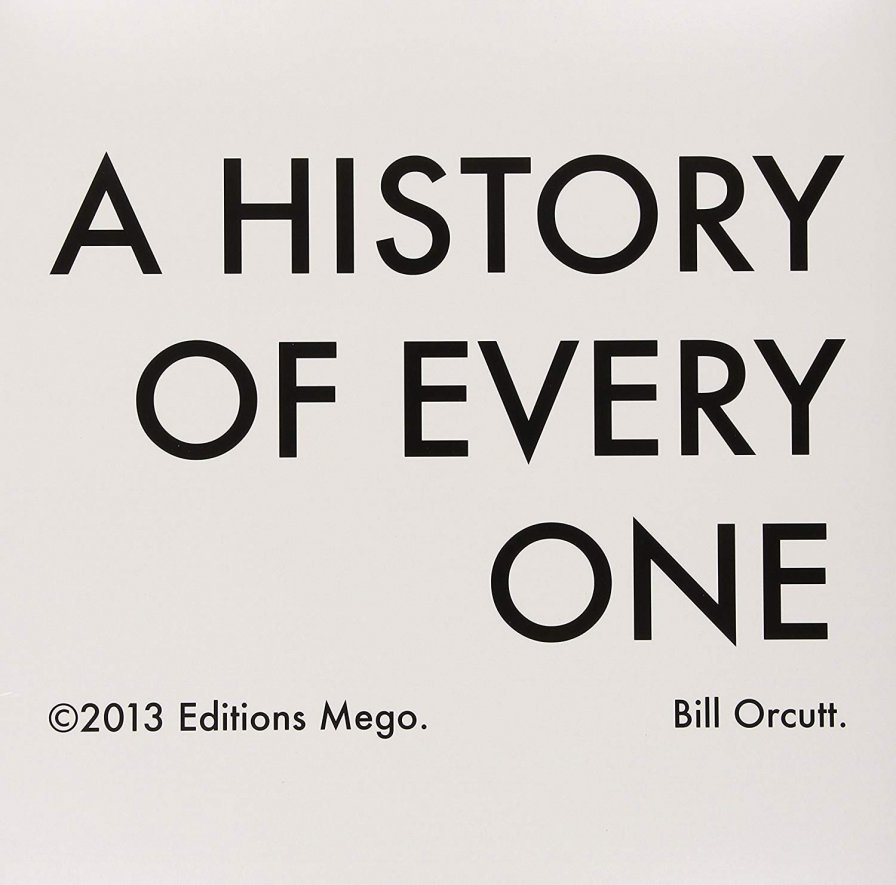
Guitarists will sometimes warm up by hitting their strings a little before starting to play. For composer and interpreter extraordinaire Bill Orcutt, sometimes hitting is playing. Indeed, there were sequences on A History of Every One that were downright barbaric on first listen. As soon as Orcutt’s treatment of the trade union morale-booster “Solidarity Forever” started, it was obvious that we were in for a one-of-a-kind slab of magic. But with traditional spirituals standing next to festive fretworkouts and minstrel and work songs marching alongside two Oscar-winning Disney ditties, there was a different sort of fairytale glitter going on here. A History of Every One was still a lovely piece of lunacy, however, and despite many moments of extreme strain and disorder, the album had a sweeping, strange beauty that has been making our heads swim since its release in 2013. Far from being a time capsule, the album pointed a way forward in free expression, and everything worked. Containing a dozen tours de force, each one indistinguishable from its most common — or most deformed — version, A History of Every One was a let-it-bleed collision of energies that is still one of the more “alive” guitar experiments you’ll likely ever hear.
95
Beyoncé
Lemonade
[Parkwood/Columbia; 2016]
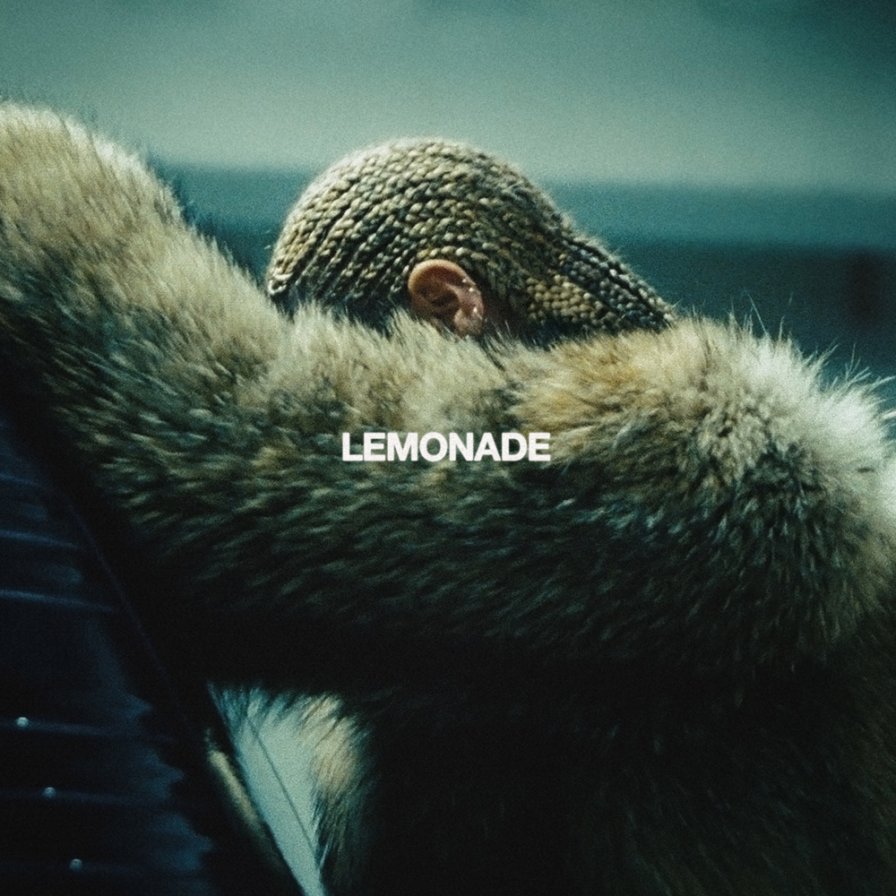
Where Beyoncé established Beyoncé as a brand, Lemonade positioned said brand as a mode of performance art. Knowles-Carter had already turned her releases into unannounced audio-visual events with her self-titled 2013 album, but with Lemonade, the pop icon’s not-so-private personal life and changing relationship to American and global media consumption seemed inextricable from the project’s genesis, distribution, and reception. Released exclusively on the artist’s own streaming service, accompanied by a 65-minute film on HBO, the album’s tracks played like 2016’s feminist response to Here, My Dear, preceding the #MeToo movement just as Beyoncé’s Super Bowl performance of “Formation” (the album’s lead single turned bonus cut) preceded the NFL’s identity crisis, the latest terms of which are now being negotiated by none other than Beyoncé’s husband. Considered alongside 2017’s 4:44 and 2018’s Everything Is Love, the album also kicked off a trilogy of brilliantly transcendent, if also tellingly misunderstood, sociopolitical treatises from the Knowles-Carter family. Perhaps most importantly, though, Lemonade was the decade’s most ambitious break-up-to-make-up album, one for life partners to argue over and embrace together like no other. Who knows? If C Monster saw it premiere with Savannah, maybe it’d be his favorite Beyoncé album, too.
94
Zs
New Slaves
[The Social Registry; 2010]
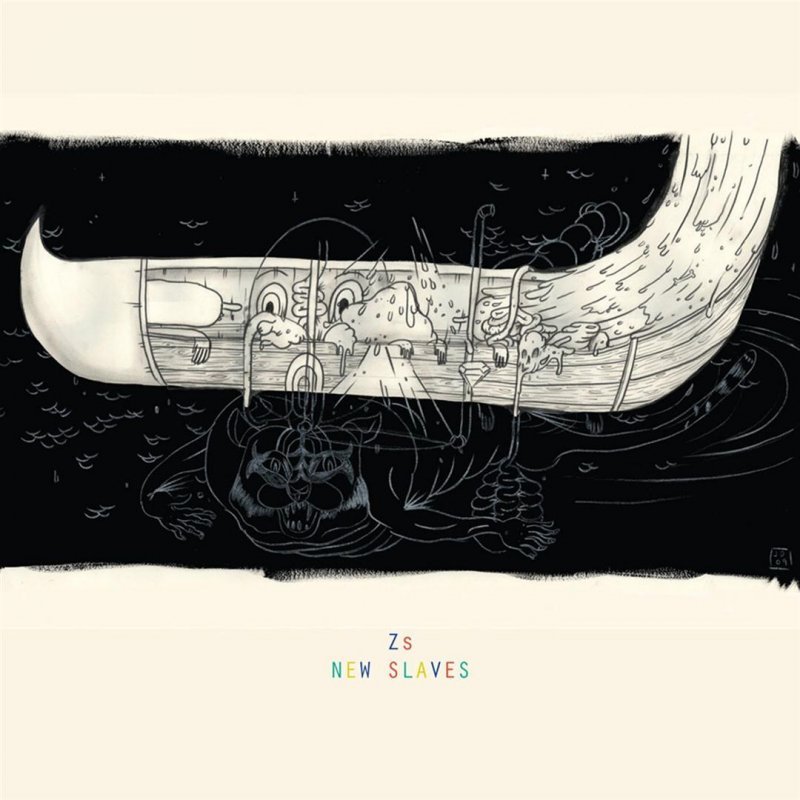
New Slaves hit me hard in the chest and never left. Every song was a law, a sculpture of raw energy, a spectacular commodity. Twisted and beautiful, wrought from astounding performances and inspired studio magic, New Slaves is still revelatory 10 years on. It was in 2010, at my (and Jonathan Dean’s) beloved campus station, when I first heard “Gentleman Amateur,” which instantly hooked me on the group. And it was also in 2010 when Tiny Mix Tapes ruptured itself and gave New Slaves the #1 slot in its year-end rankings, which is also the moment I realized that this site knew what the fuck was up and I needed to write here. But 10 years on, I still can’t adequately explain how amazing this record is. I can barely even explain how it sounds. “Unique chamber music compositions using rock instruments, microtonalities, and extreme textures that never underestimate their audience or compromise on execution.” “Noisy, raw, gorgeous, difficult, caustic, cleansing, numbing; a slowly exploding beautiful art bomb.” Something along those lines, but better. I would want to assign a specific turn of phrase to it, to coin something unique to describe this stunning record’s idiosyncratic noise vision. But the best music is always hard to explain. That’s what makes it so: the impossible things it conveys that can’t be captured in language. The things it fantasizes aloud, the new fantasies it creates in turn. There’s proof of something here, something we haven’t figured out yet, buried deep in the chaos. Some new model for living, adapting, and surviving. With it comes this strange optimism, that the harsh rigors of the reality you find yourself in can be worn, like armor — the proud decorum of a future corpse.
93
Bill Callahan
Apocalypse
[Drag City; 2011]
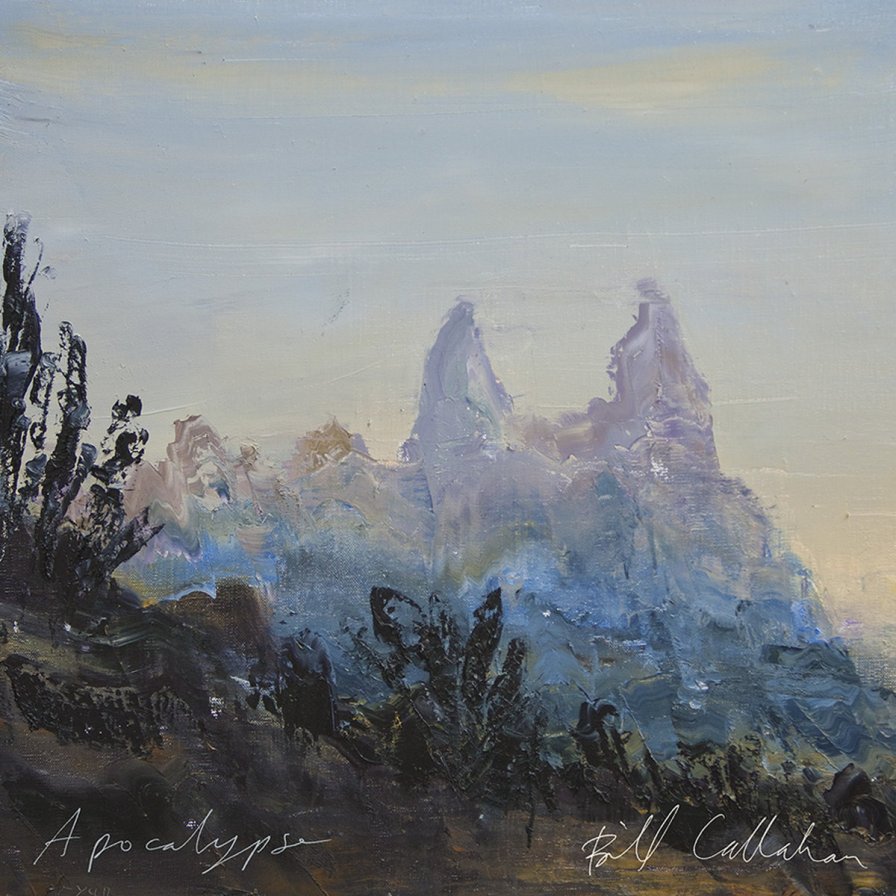
I share a space with Bill Callahan. It’s not a small space, it’s a city. We see the same sights over and over again — violet-drenched sunsets, eternal grids of highway chrome, the crystalline owl peering above the Austin skyline. The same grocery stores and gas stations and the DMV. Existing day-to-day in a space like this, the wondrous and the mundane begin melting together, smearing like the mountain landscape of Apocalypse’s cover. Bill Callahan’s masterpiece resides within that smear, coming across as both grounded and unknowable. Our home country, which contains our home city, which contains our home structures (physical, social, interpersonal), is viewed bleary-eyed from Australia, its avatars a legendary talk show host, four legendary country singers, and a small sampling of our atrocities, not legendary but sickeningly real. By the record’s end, Callahan has denounced the life that so consumed him a half hour of album-time prior, settling into a gentle ride and ultimately becoming the road itself. Has he finally become something so ethereal and beyond himself that he exists only as part of the landscape itself? Absolutely not. His final words on Apocalypse: “DC 450.” It’s the album’s catalog number, reminding you that this is an album, a finite work of art that, brilliant as it may be, simply exists.
92
Actress
R.I.P
[Honest Jon’s; 2012]

In a time when time ran backwards (2012, to be precise), rising soccer star turned archeologist Darren Cunningham excavated fragments of recordings from a time after human extinction. Caked with lime, richly warped and discolored by mold and decay, haunted by chrominance signal ghosting effects as well as actual ghosts, these artifacts had nonetheless survived, on the whole, in an acceptable state of preservation. It was determined they were/will be created by AI military think tanks in a style that exhibited vestiges of 21st-century rap and house and suggested a corollary interest in the by-then obsolete concept of “Dance.” The think tanks were/will be specifically mandated to reverse-engineer and weaponize the concept of “emotion,” and their inability to grasp anything but its surface manifestations, combined with the organic processes of reverse time and reverse soil and a software-driven sense of intellectual longing, created its own unique textural poignancy that found its way into unexplored human neuro-pathways, arousing actual emotion amongst the final generations (in forward time) of homo sapiens to survive on planet Earth.
91
David Bowie
Blackstar
[Columbia; 2016]

Blackstar was recorded in secret and released two days before David Bowie died from liver cancer. Bowie knew this was going to happen, but we didn’t. I’m interested in those two days. Now, we can’t separate these events from one another, Blackstar and David Bowie’s death, but there were 48 hours where the album was just another new project from an aging rocker. As we look back on Blackstar, there’s a strange way in which Bowie lives beyond his death more than some others who die, because he’s rooted so deeply in this object. He affects us from it, and so he doesn’t seem truly gone. A highlight of the 2010s and one of Bowie’s most powerful records, this album continues to remind us that the things that unfold in this world change the way we see artworks. The dark grooves of the prescient “Lazarus,” the devastating new meaning of “I Can’t Give Everything Away,” the frenetic cadence and the mysterious sci-fi frame of the title track. What were those two days like for people who were listening, before this album became what it is now?
90
Jenny Hval
Blood Bitch
[Sacred Bones; 2016]
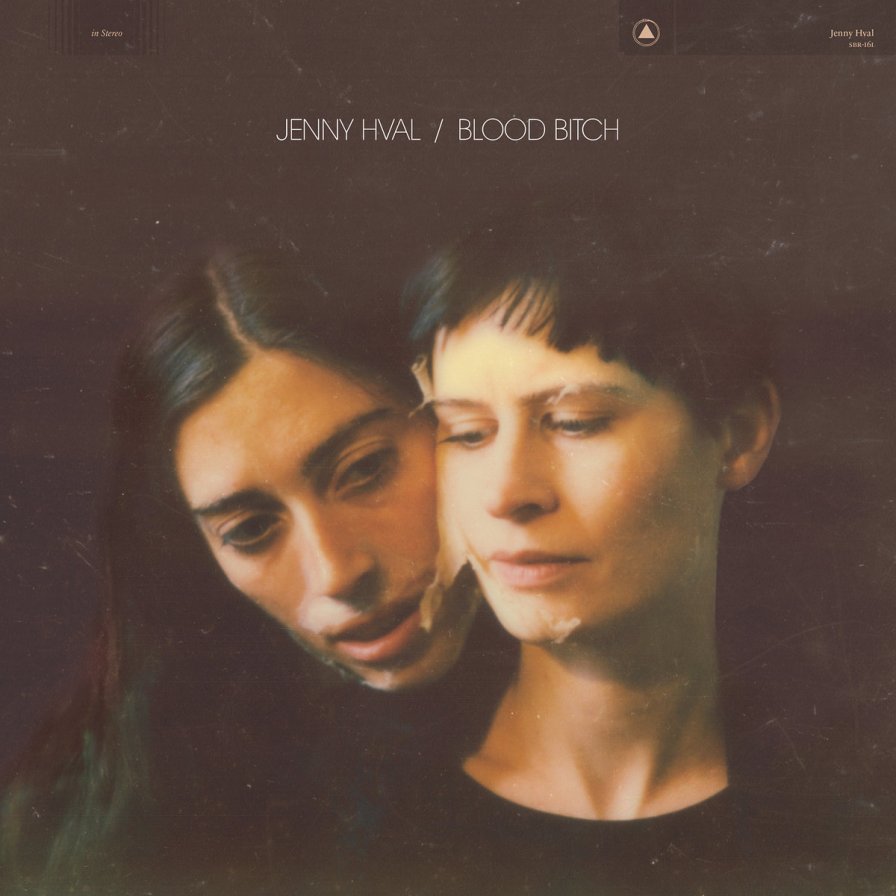
Jenny Hval spent the first half of the decade putting words under a microscope with lyrics that were at once blunt and razor sharp, where music (or sometimes just sound) grew organically from her confident yet deadpan delivery. While Blood Bitch was a culmination of that process, it was also a turning point. Hval’s self-examination expanded to an exploration of identity stretching time, space, gender, and myth, delivered with a newfound sonic warmth (“Female Vampire”), vocal tenderness (“Period Piece”), and lyrical vulnerability (“Conceptual Romance”). But in a decade where heel-turns to pop music came to feel like a cynically predictable career strategy for experimental artists, few on either end of that spectrum took the kind of risks Hval threw herself into. The gasping, out-of-breath pulse running through “In The Red,” the screamed panic of “The Plague,” the whispered dream diary of “Untamed Region,” and even the candid question “What’s this album about Jenny!?” blurted out right in the middle revealed an artist able to make her music more challenging and spiritually probing than ever, all while embracing pop music on her terms. Blood Bitch was one of the most open-hearted albums of its era, even — or especially — when it was dripping with blood.
89
infinite body
carve out the face of my god
[Post Present Medium; 2010]

At the turn of the decade, harsh noise expat Kyle Parker sighed ambient tracks of relief more suitable for avoidance than integration, going away than getting along. As the self receded into absence, “Dive’s” slow fade in of granular chordal melds resonated with coarse serenity inside the curved bowl of an empty skull. Moving his carapace through symphonic mandala (“A Fool Persists”), trailing expoflora (“Drive Dreams Away”), and marine life (the title track), Los Angeles-based Parker looped and steered his exhausted orchestra-of-one in an aftermath of fraught nerves. Embedded in the collection of post-escapist sustainments, beacon track “Sunshine” blinked ChipCorder-esque throbs across an overcast outstretch of dull haze and polymeric shimmer. Spatial and substantial, linear and circular, Carve Out The Face Of My God die-cut hollowed-out residue from hallowed music into flatlines that reflected the nihilism in the divine, and vice versa.
88
The Knife
Shaking the Habitual
[Mute; 2013]
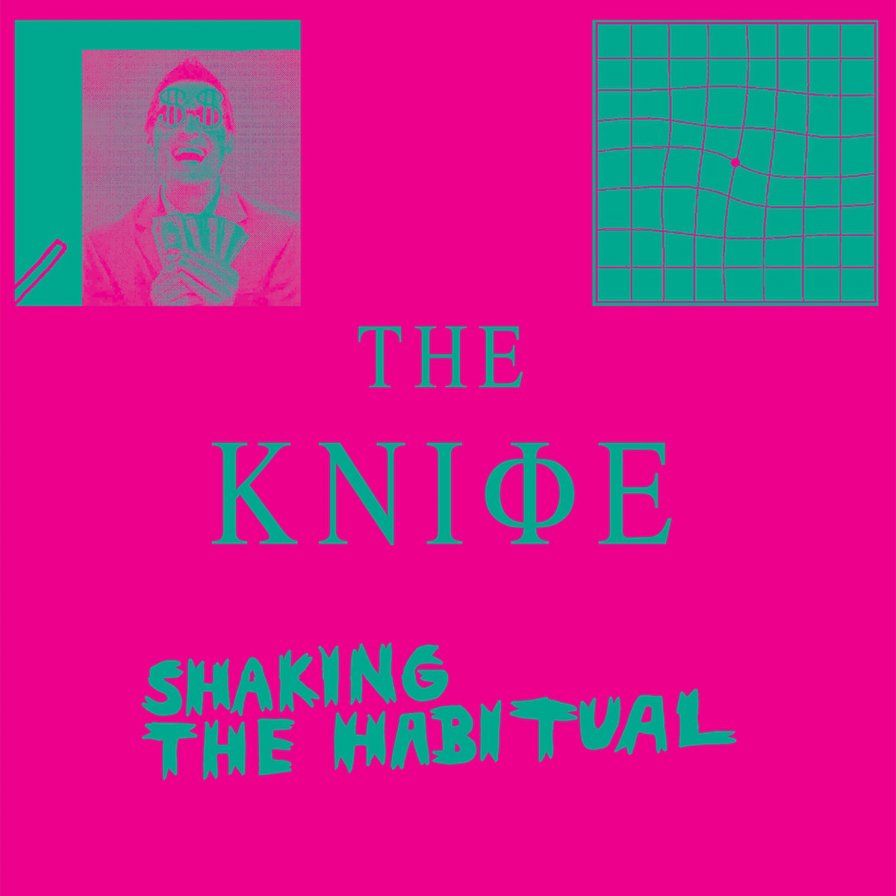
Before we get too deep into this, I feel this obvious detail deserves recognition: Shaking the Habitual, as a title, was dead-on. I mean, even beyond its cheeky referencing of Foucault. Sure, Karin Dreijer Andersson and Olof Dreijer were committed to “[shaking] up habitual ways of working and thinking… [of re-evaluating] rules and institutions,” all that good post-structuralist shit, but what really made it resonate like The Concern for Truth never could was how truly SHOOK it left us all. This thing was so fucking monsterous, it famously broke our scoring system. I once listened to it very loudly and in its entirety on a plane; somewhere around “Crake,” I thought there was a real possibility that we were going down (what with all that clanking), but I vividly remember being way too unconcerned about it. Shaking the Habitual’s genius was that it riled you up — about gender stereotypes or fracking or boring sex or whatever — but it never killed your mood. There was a dreadful irony here that music like this could, through its physicality alone, relinquish our grip on our privileges, our violent habits, our possessions, that these sick beats and synth squelches could “end succession” if only more people would hear it. The Knife were bent on “failing more” though, but not before they succeeded in completely dismantling everyone’s expectations. Maybe this is where it starts though: with a flurry of wooden clicks and breathy chirps and rapturous screeches, like cracks in a dam holding back hoarded wealth, like an unshakeable urge in the left foot of a billionaire who’s never danced. In all honesty though, thinking about kicking capitalist habits is hard, but when this shit is on, I’m ready to lose. Bring it on.
87
Amen Dunes
Through Donkey Jaw
[Sacred Bones; 2011]

For Damon McMahon, the transformation from Mark Tucker to T. Storm Hunter occurred sometime during recording “Jill.” The manic, fragmented psy-fi of its locus: a discombobulating melody that bounced across every surface, sounding like a stalled Bataszew. It was the beginning of a disconnect from D.I.A., but it was also the mutagen that further separated himself from an outsized beginning. McMahon once lamented that he hoped Through Donkey Jaw would be hated, because he thought it wasn’t quite as sincere as his future recording output would be. But here we stand, and Through Donkey Jaw might be McMahon’s most sincere output. The range of emotions were uncontrollable. McMahon ripped his old formula to shreds, disassembling it one song at a time until the record ended in a scrapheap of teary-eyed confessionals. The road McMahon has taken since has been lengthy, but each subsequent release has recalled Through Donkey Jaw’s imitable spirit in some way. And as he’s polished his ride to a fine sheen, he hasn’t buffed out the well-worn scratches or picked at the rust. McMahon has never been able to shake his confessional tune, never abandoning his own version of Tucker’s 1964 Cadillac. In fact, unlike his predecessor, he’s come to own it as the reliable, if beat up, mode of transport is was built to be.
86
Rich Gang
Tha Tour Pt. 1
[Cash Money; 2014]
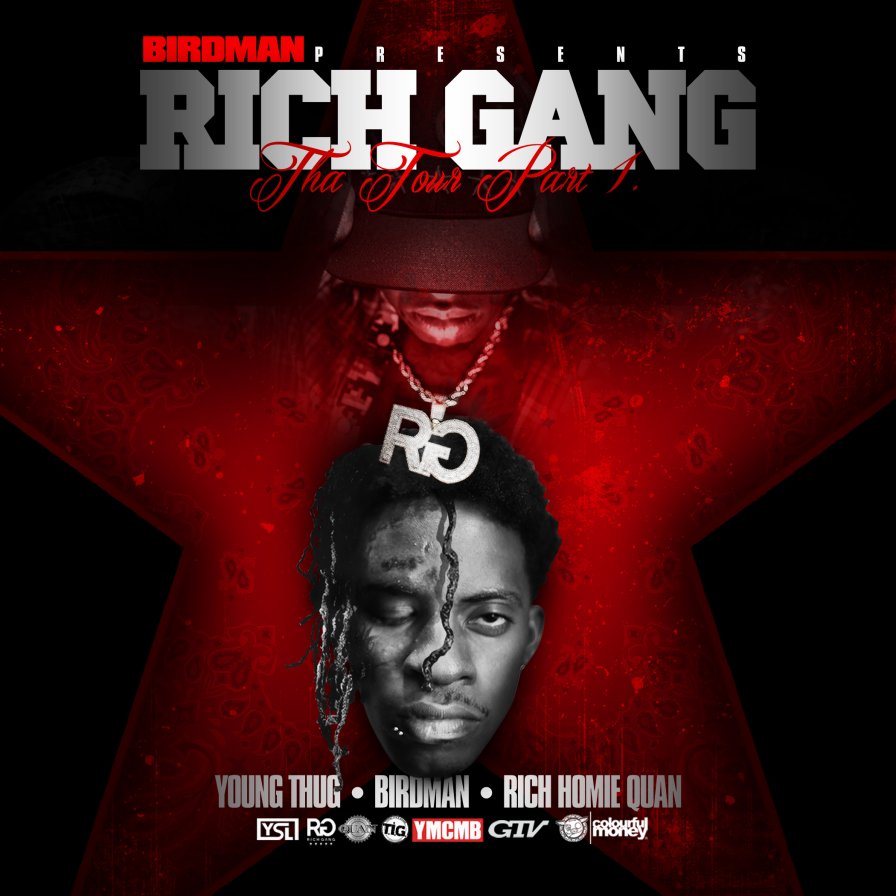
Obviously, we don’t accept the term “mumble rap” as a meaningful genre descriptor: Listening to this towering mixtape collaboration between Atlanta innovators Young Thug and Rich Homie Quan does not entail any of the strain implied by perceiving spoken words beneath the friction of mumbling. It’s instead a pure thrill to revisit Young Thug’s exuberant leaps in pitch, his tangled, unpredictable flows, his syllables flung like Jackson Pollock drips. And though less influential, Rich Homie Quan is a gripping stylist, too, his drawl smeared, dipping in volume, marked by inventive dynamics and repetition. The mixtape was a lexicon of ear-worms. Every song was memorable, and yet our ears were able to pinpoint new phrases with each spin. We listened while availing ourselves of the crowdsourced transcriptions on Genius, comparing what we heard with the majority opinion. We listened by firing up old hard drives of leaked MP3s or prying open the browser window of DatPiff. (This mixtape is still not available on major streaming services.) Even though the term “mumble rap” still sucks, listening to Tha Tour Pt. 1 made us reconsider the term as a reminder of the way Young Thug and Rich Homie Quan helped us hear, in all audible language, the eruption of melody out of speech.
85
Helen
The Original Faces
[Kranky; 2015]
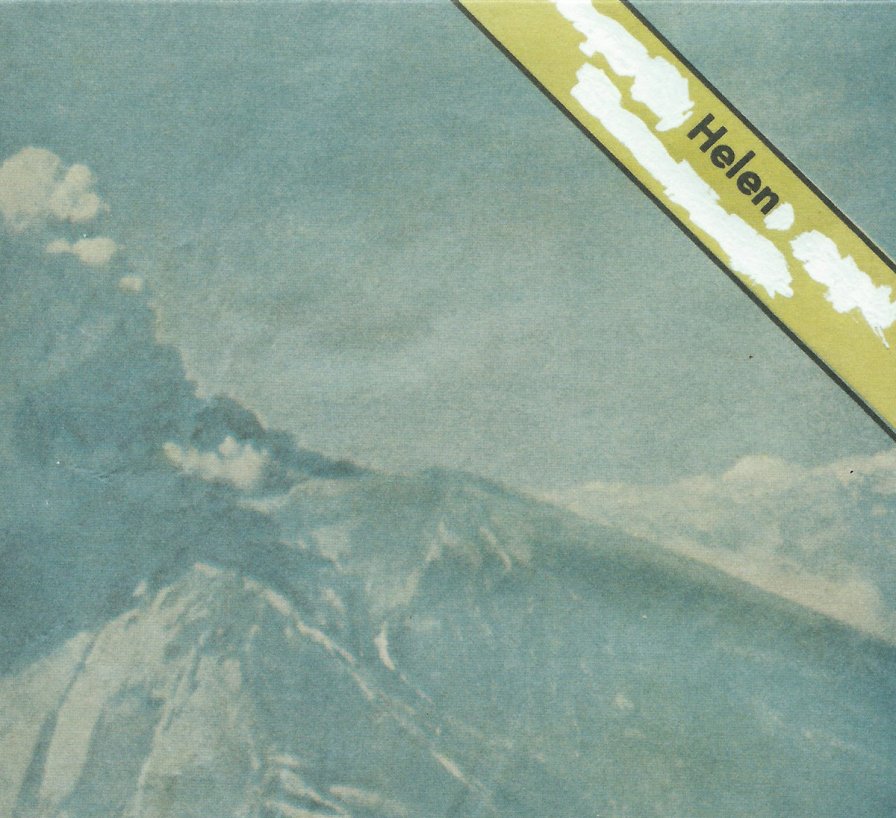
There’s a scene early in the 1989 film Weekend at Bernie’s in which star Andrew McCarthy attempts to extract his boom box from an impressive amount of tar built up on a steamy NYC rooftop. This imagery — a boom box encased in muck — is an apt metaphor for the sounds produced on Helen’s 2015 album, The Original Faces. Liz Harris (Grouper, Nivhek) was joined here by pals Jed Bindeman and Scott Simmons (with backing vocals by the mysterious “Helen”) for a 12-song missive of what might be referred to as “surf noise,” if classifying such things is important to you. Beginning with the pleasantly noodling “Ryder” and ending with the short-but-sweet title track, the group burned through 33 minutes’ worth of sonic downer bliss; even the songs lasting south of two minutes left an indelible mark. But despite its relative brevity, the music was catchy and dense enough that you’d find yourself discovering new sounds deep in the mix, like diving through a new cereal box for the prize buried at the bottom. The Original Faces was the type of album that socked you in the stomach for your lunch money then tripped on its way out the door, a roaring yet surprisingly tender addition to Harris’s distinctly overachieving and achingly gorgeous oeuvre.
84
D/P/I
Fresh Roses
[CHANCEIMAG.es; 2013]
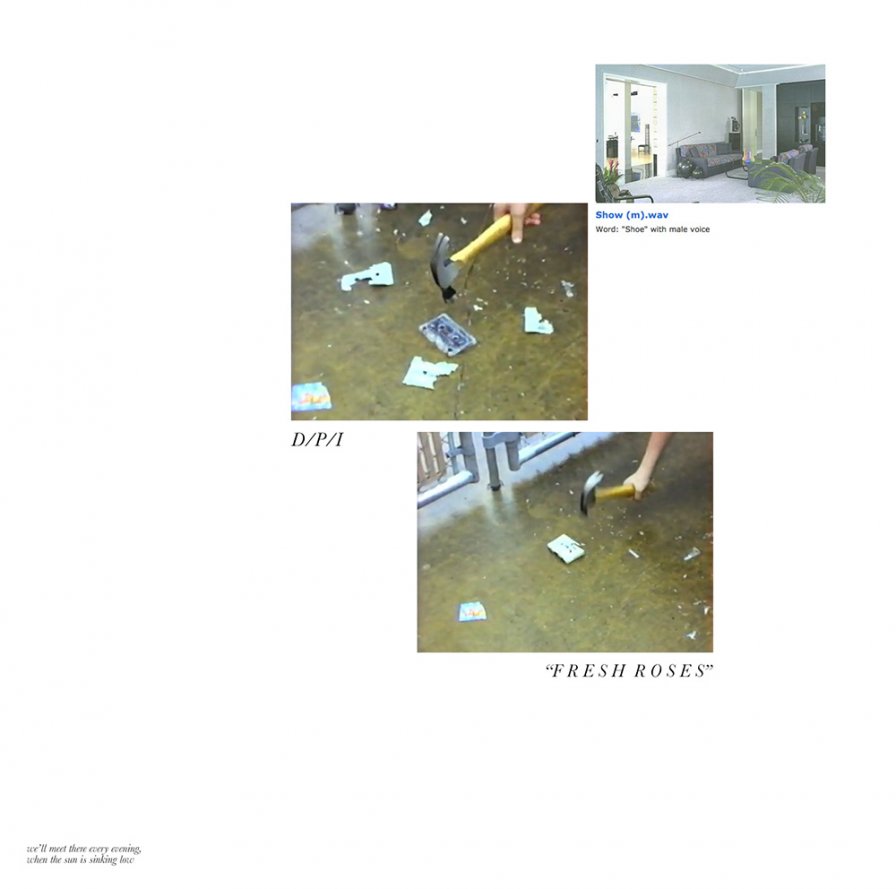
Microseconds into the opening pitch-shifted warble of “In Dreams” — wait a minute, is that Roy Orbison? — I knew there was something special about Fresh Roses. Alex Gray’s D/P/I project always had a sort of capacity for serrated incision, an ability to recombine the sonic lost & found into a thrumming beat or a collage or an open-source cave painting that pointed 13 different directions at once. But there was something so crystalline about Fresh Roses’s vision. It sprawled from the towering centerpiece of “DEPRESSION SESSION,” a piece wherein we were cast about by the (de)motivation of a TED talk’s angry older brother while hard drives went senescent in the periphery. Country songs melted, beats were cheese-grated: WAKE THE BODY BACK UP! Forgive me, but in the last 10 years, so much that was SUPPOSED TO BE SOFT went hard as rock. What stage of post-irony are we in again? Who’s in charge here? I can’t remember cuz I deleted most of the note on my phone where I was keeping track. All it says now is “Fresh Roses.”
83
Andy Stott
Luxury Problems
[Modern Love; 2012]

Andy Stott has had his finger right on the pulse this entire decade, but Luxury Problems in particular continues to hit just as hard as it did in 2012. Shortly before its release, after years of balancing his techno output with a day job at Mercedes, Stott quit the luxury car business. The change deconstructed the rhythm of his life, day bleeding into night and back into day, as if time belonged to another existence. And that was the sound of Luxury Problems — techno that lost all sense of urgency, all sense of compulsion. Techno that techno’d to techno, for no one and nothing. And yet it was so alive, like the beating of some dark, dank heart powering the underworld and, indeed, the one above ground, too. Still, the most we could do was feel its heat; we knew it was there, but we couldn’t know it in itself, separated as it was by an impenetrable and unknowable mass. To get lost in non-time was the ultimate luxury problem, and the record took us right into it, enveloping us in a peculiarly woozy sludge that we willingly got ourselves stuck in. It was a beautiful, even inviting, sludge, thanks to Stott’s old piano teacher Alison Skidmore, whose layered, decaying choral vocals were otherworldly and perfect for Stott’s compositions. The collaboration was fruitful in a way that Stott could not have imagined when he reached out to her. I mean, they hadn’t seen each other in 15 years! Go ahead and call your old piano teacher. Try to make something as good as Luxury Problems.
82
EMA
Past Life Martyred Saints
[Souterrain Transmissions; 2011]

The first song on Past Life Martyred Saints ended with Erika M. Anderson declaring “Great grandmother lived on the prairie/ Nothin and nothin and nothin and nothin/ I got the same feelin inside of me/ Nothin’ and nothing and nothing and nothing.” Was it emptiness that Anderson felt? A lack of agency in a world where her role was sharply delimited by forces outside of her? Or did we detect something productive in this emptiness, something of the pioneer spirit of her ancestor that suggested limitless possibility? The ambiguity that characterized these lines permeated the record as a whole. The imperative “Momma’s in the bedroom, don’t you stop” from “Breakfast” could have been either the breathless command of a young lover or something infinitely darker. Her lament on “Marked” that “I wish that every time he touched me left a mark” could have signified either romantic yearning or a desire for evidence of the damage inflicted upon her. It was from this muddiness, this imprecision, that the album gained its potency. What broke our hearts was Anderson’s willing recognition that you don’t stop loving the things that try to kill you, even when you know you should.
81
Freddie Gibbs & Madlib
Piñata
[Madlib Invazion; 2014]

The recording of Piñata began as an unlikely collaboration between two artists on divergent paths: Madlib had established himself as a producer of such diverse talents that he set himself the task of releasing an album a month throughout 2010 and pulled it off; meanwhile, Freddie Gibbs had garnered hype as a rising rapper, was snatched up by a major label, and just as quickly became a casualty of the game, languishing in relative obscurity during the three years it took to record the album. Gibbs’s situation was so dire that he recorded his vocals while literally living on the streets and fired them back to Madlib, who summoned his crate-digging magic to create an album that weaved thug rap braggadocio with eccentric soul samples. With guest spots from established legends (Raekwon) and artists who would go on to define the decade (Earl Sweatshirt, Danny Brown), Piñata was a classic as soon as it hit record stores (they were still a thing back in 2014, if you’ll recall). The ultimate proof of the record’s status was the ongoing trajectory of Gibbs and Madlib: by the time they reunited in 2019 for the sequel Bandana, it felt like a victory lap from two legends in their own right.
80
Graham Lambkin / Jason Lescalleet
Photographs
[Erstwhile; 2013]

For Photographs, Graham Lambkin and Jason Lescalleet traveled to their childhood homes in Folkestone, England and Worcester, Massachusetts to complete the album trilogy that began with 2008’s The Breadwinner (recorded at Lambkin’s house in NY) and 2010’s Air Supply (recorded at Lescalleet’s in MA). The result was a movie-length examination of the relationship between memory and location, providing an audio verité glimpse into the friends’ encounter with their pasts. As if listening in with a glass to the wall, we overheard discussions about Lescalleet’s tea preferences, Lambkin’s prized banjo, and the olfactory properties of Mexico City as compared to Jacksonville, Florida. In the tradition of Luc Ferrari’s Presque Rien, Photographs argued for field recording’s potential to create immersive soundworlds on the premise that the “world itself” is compelling enough to be listened to. Of course, with Lescalleet’s involvement, the field recordings didn’t go wholly untreated. “Danger of Death” featured a disorienting ear-piercing tone, while “The System” provided three minutes of digital noise. But when counterposed against the lovely choir on “Quested to Saint Hilda” or the gorgeous outro of “CT20 1PS/Rinsing Through the Shingles,” such moments only deepened the impression that this album, like a photograph, contained all the beauty and ugliness of the past.
79
Beach House
Teen Dream
[Sub Pop; 2010]

Would I have arrived without the direction that she indicated by hand. That she folded into a soft edge. Would I have followed her voice around the mirror, into the hum. I knew the sound, even though I could not place it, because it looped and guided me to a wide open field, a hell beneath the stairs. The shape of her mouth deciding whether our bodies would crystallize or recline or bend, depending on the quality of the vowel. You tell me only time can run me. I thought I understood the architecture until something round slipped and rolled into the night. I thought I understood where to coil, where to lounge, where to tear a moment from the days that carry us on forever. Where I might have drawn the curtain and organized the light, I surfaced into a kind of gold that blurred what I could remember about tracing half a circle into thin cotton, ecstatically. Teen Dream made the room warm so that mood could become texture, made the haze, the grain, a ritual. The seam of my dress, the rim of the glass, spiraling. The wing of my eye, the frame, melting into a time I could make glow.
78
Solange
A Seat at the Table
[Columbia; 2016]

A Seat at the Table succeeded and grew deeper with each listen, because it was Solange laid bare: a chunk of her humanity, with all the complexities and messy contradictions, assembled with grace and stitched with anger. On “Cranes in the Sky,” the effortless, pure beauty of her vocals wrapped themselves around laments aimed at the emptiness of her depression. It was this juxtaposition that structured the album. Even “Mad” and its message of both holding on to and letting go of emotions slid by with the ease and simplicity of clouds on a calm summer day. Yes, this album was a statement about race in modern America, highlighted as such on tracks like “Don’t Touch My Hair” and “F.U.B.U.” Yes, this album reveled in the fond memories of lessons from the past (hello, Master P) while also looking forward to a world with greater musical possibilities (hello, “Don’t Wish Me Well”). But what made this album special was never just its individual parts. This album was an encapsulation of all that Solange has been, can be, and is, but it never lost sight of the beauty, ugliness, and complexity of what it means for any human to be alive.
77
Women
Public Strain
[Jagjaguwar; 2010]
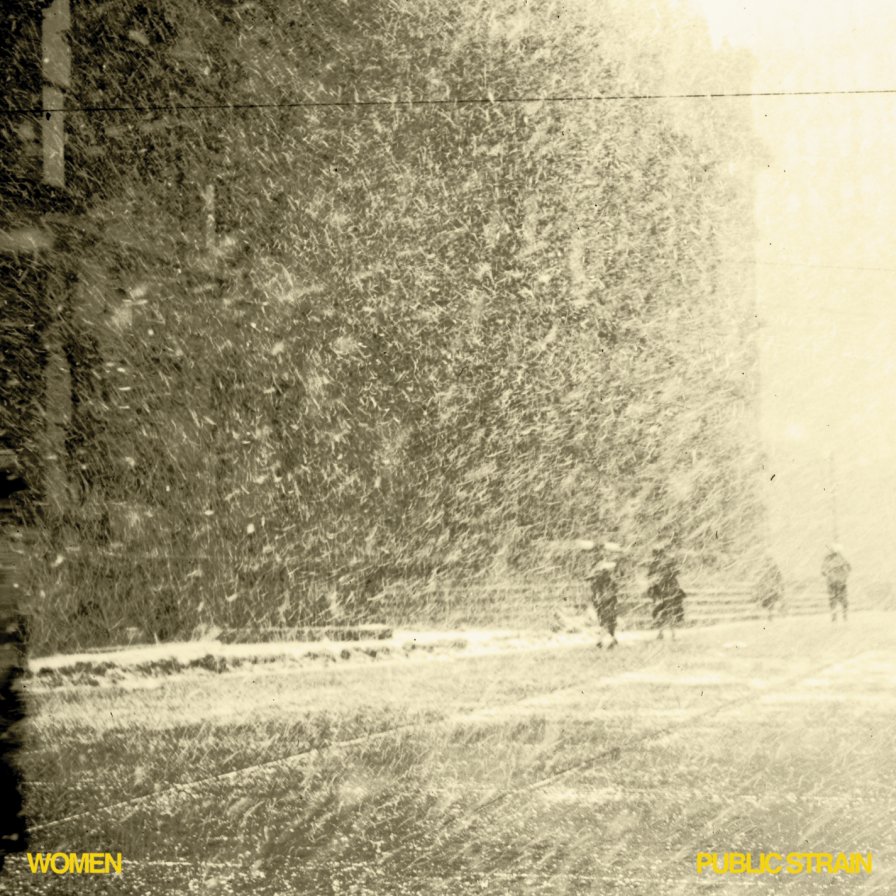
Women died an unceremonious, explosive death shortly after the release of Public Strain. It seemed to be a fitting end for a band whose genius seemed almost unsustainable, given how fully formed and peerless their final album was. But the death of Christopher Reimer in 2012 brought everything back into perspective. An unfair, untimely, shitty loss for music as a whole, it is fortunate that we have Public Strain to remember him by. The album stands as a perfect summation of his virtuosity, a true guitarist’s record, vast and expansive, grasping at new sounds and eager to explore riffs with cool curiosity. There are few rock records that can unite drone and pop so fruitfully, flitting between bold experimentation and crowd-pleasing melody, but Women straddled that line with stunning ease. Simultaneously warm and frigid, calculated and emotional, Public Strain was simply an indefinable treasure. It now sits in the annals of classic post-punk records, new and experienced listeners alike lucky to uncover its hidden secrets.
76
Chief Keef
Almighty So
[Glory Boyz Entertainment; 2013]
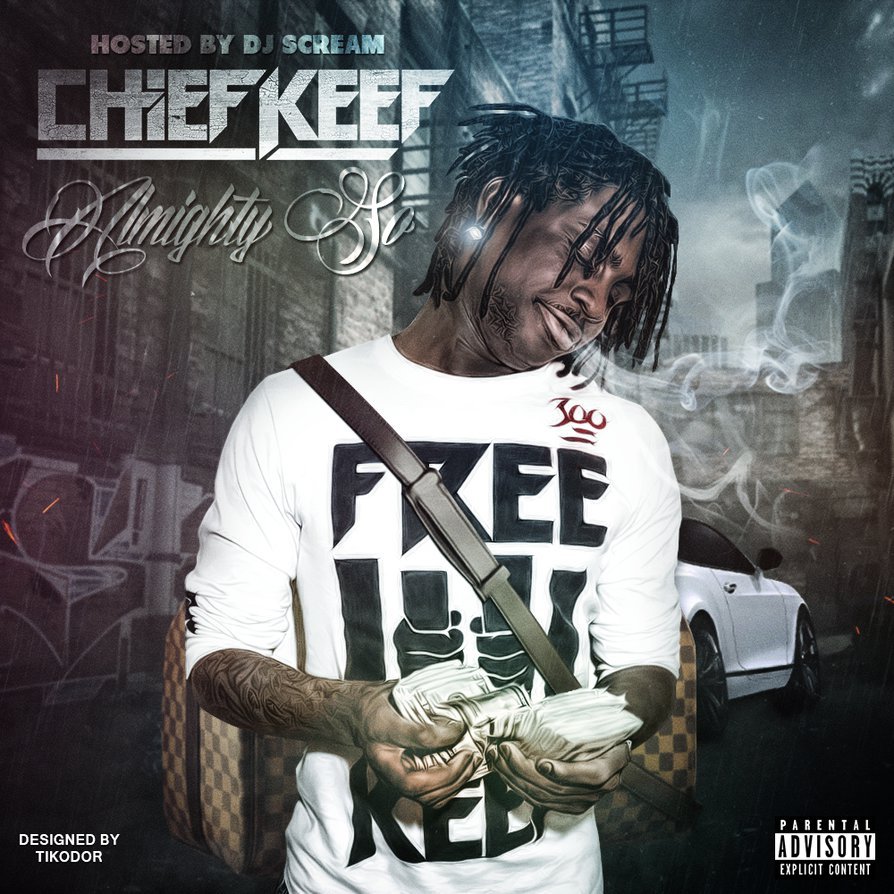
Chief Keef foils the list-maker like no other. Bang, Part Two signalled a hard left into a genre all his own, and for all the linear, phased creative development he’s undergone since, no two releases fail to resist comparison (to one another, let alone to anything else, to say nothing of the ever-shifting mass of snippets and loosies that comprises seemingly half his body of work). Almighty So isn’t a bad place to start, though. Something like a Rosetta Stone for Keef’s mid-decade output, the mixtape foreshadowed the ear for production that Sosa would soon take into his own hands, the pop predilections that would congeal into the much-delayed but once-contemporaneous Thot Breaker, and the leaned-out sensibilities that would resurface in his present “underwater” period (which, purportedly, will deliver us Almighty So 2 any day now). While the urgency of simply getting familiar with Keef dwarfs the importance of the specific point of entry, why not Almighty? As Sosa fandom has narrowed (somewhat) and deepened (near-religiously) over the course of the decade, no tape’s appellation has proven more prescient. All hail!
75
Eli Keszler
Stadium
[Shelter Press; 2018]

Eli Keszler’s musical career has been built on expanding the vocabulary of percussion, and with Stadium, the experimental drummer and sound artist crystallized his clearest vision yet. From the breakneck pace of opener “Measurement Doesn’t Change the System At All” to the cloaked ambient textures of the provocatively titled “We Live in Pathetic Temporal Urgency” to the synth-led “Fashion of Echo,” Keszler placed tendrils of jazz throughout the entire album. Was the gorgeous drone that kicked off “Was The Singing Bellowing” the work of meticulous field recordings, multiple stompboxes run in series, or a combination of both? How about the genesis of the broken beat that propelled “Simple Act Of Inverting The Episode?” You could take a guess at what the influences were (maybe if Cid Rim got together with Jon Hassell?), but the tunes resonated inside entirely uninhabited territory. Having produced several large-scale art installations outside of his music project, Keszler has understood for years the uncanny spaces that sound traverses, and nowhere was it on better display than on this outstanding record.
74
Angel Olsen
Burn Your Fire For No Witness
[Jagjaguwar; 2014]

Floating our way midway through the decade like some eerie-ass fog off some swampwater, the sophomore effort from Angel Olsen somehow rendered the heaviness of existential dread and the messiness of constant anxiety sheer and weightless. Indeed, just like a gaseous vapor, it felt like a beguilingly uniform affair: no track was a highlight, because no track was a lowlight, either. More significant to its place in history, though, is the fact that, by the time the last of this album’s ambiguous-yet-personal lamentations had ended, Olsen’s quavering, confused-but-confident howl proved we hadn’t heard NOTHIN’ YET. It’s easy to forget it here at the end of the 2010s — now that her songs have fully ascended to the heights of full-on electro-acoustic oratorios — but Burn Your Fire managed to stubbornly exist in that dizzyingly low-oxygen “Goldilocks Zone,” wherein both her vocal range and instrumental palette took ramshackle steps forward from the sparse mumble-folk of her debut but hadn’t yet reached their terrifyingly confident, pop-diva potential. Here on her debut for Jagjaguwar, Angel Olsen didn’t yet know how to tear her way into our hearts with countless elaborate and glimmering hooks. So she did it the old-fashioned way: with 11 rusty fish hooks.
73
Panda Bear
Tomboy
[Paw Tracks; 2011]

Before I was a critic, I was a chorister. Which means that I sound things out instead of pinning them down, and I know that can make me hard to follow. But let’s not pretend that the density of a call across rooms in a home you know fondly doesn’t tell you things its diction can’t. Or that the difference between silence and hush burnished and lucent isn’t a messianism of sorts. Even the imprint of a body on a bed or the contours of the palm on a handmade bowl could adumbrate the forgiving carpentry of a sacristy if the touch is tender enough.
Now I see you again
Now I feel you again
Now I know you again
Tomboy is expanse. The vastness of your uncle’s snug embrace or the last note you heard Thomas sing before you grew apart and he died in his mother’s house a couple weeks before you both were supposed to turn 21. But only one of you did, and time’s profanations elongate your distance to his rude and rapturous colophon. When I slammed my finger in the car door and moved prematurely to the alto section, Mr. Brady told me to hold my horses: I’d miss my head voice soon enough. I can’t sing like Noah Lennox anymore.
I know I know I know
I know I know I know
I know I know I know
I know I know I know
I know I know I know
I know I know I know
I know I know I know
I know I know I know
I know I know I know
I know I know I know
Conventional wisdom crumbles bitter in the mouth, but artless smiles stay, yawning broad like dad’s shoulders or the hymnal breath shared before a kiss. Everyone knows what they say, but it’s clear now how it’s what they don’t say that counts. Sometimes a voice refracts indefinitely, marking every surface it osculates in its weft of gentle intimacies. Sometimes the louder a voice is the more it amplifies the quiet gossiping of its sonic substrate: the muted bray of the congregation at evensong or the windblown howl of the benfiquistas chanting for Óscar Cardozo in his gangly prime.
Don’t break ties that hold them
Don’t break
Don’t break
Don’t break
Don’t break
Don’t break
Don’t break
Don’t break
Don’t break
Don’t break
Don’t break
After “You Can Count On Me” unfurled into so many voices, silence, properly speaking, ceased to exist. There is always and there is only chorus.
72
Matana Roberts
COIN COIN Chapter One: Gens de Couleur Libres
[Constellation; 2011]

It was her saxophone, screaming alone, that shattered the silence. This first gripping sound of Matana Roberts’s 12-chapter COIN COIN project — named after freed-slave-turned-entrepreneur Marie Therese Metoyer — threw us into one of the most conceptually ambitious, sonically captivating, emotionally raw musical odysseys of the decade. The Chicago-born saxophonist and composer, employing graphic scores and practicing a technique she called “panoramic sound quilting,” assembled a 15-piece ensemble for this introductory installment of her multi-part exploration that combines personal ancestral narrative and the broader African-American experience. In a historical moment when dwindling attention spans sparked a billion unread think pieces (and skipped podcast episodes), and the relevance of albums for many declined (once again), and even the celebrated ephemerality of pop songs started feeling like a grueling eternity (because what would the algorithm recommend next?), Roberts went unapologetically, no-fucks-left-to-give LONG. FORM. It was timely and untimely, personal and political, beautiful and violent, all at the same damn time. In 2019, to wrap the decade, Roberts delivered the magnificent COIN COIN Chapter Four: Memphis. At this pace, we can anticipate two more decades of COIN COIN. Twenty more years of inspiring, edifying, and courageously unpredictable music to look forward to.
71
Frank Ocean
channel ORANGE
[Def Jam; 2012]

Funny to think about the world when Frank Ocean was just another Odd Future affiliate. Sure, the crooning-over-others’-beats mixtape nostalgia ULTRA showed promise, but Christopher Breux did not truly become Frank Ocean for many of us until channel ORANGE’s second single “Pyramids,” a nine-minute prog’n’B banger with a filthy extended John Mayer guitar solo. Goddamn if those first synth stabs don’t still get me riled the fuck up! What’s stunning is how well channel ORANGE holds up years later, even as it’s been eclipsed by the perfect Blonde, the if-you-blinked-you-missed-it Endless, and a host of non-album singles evidencing Frank Ocean’s brilliance. But this one’s just as important to the story. It’s easy to forget how significantly the sound of R&B has changed from 2010 to now; perhaps nobody carved out the contours of that change more than Frank. Get into your time machine and maybe you can find your way back to the date Frank published his infamous “thank you’s” Tumblr letter — oh wait, thanks internet! — a landmark development in the way we discussed blurred gender and sexual identity in rap and R&B, and truthfully the world. It was also a transformative moment in our collective relationship with Frank. Now, we felt, we knew him. For real. And the music on channel ORANGE became something more, something vital for so many of us, as we explored all of the ups and downs of this crazy life. Because somehow, it seemed, Frank knew us too. So no, Frank… thank YOU.
70
Giant Claw
DARK WEB
[Orange Milk/Noumenal Loom; 2014]

We have no time for anything anymore, so we demand everything all at once. As information from all corners of the corporeal and incorporeal worlds course through the cyberculture at ever-climbing rates, any authentic aesthetic discrimination seems more and more an impossible task. Attention takes its place as the highest commodity, and algorithms work tirelessly and silently to map our psyches according to how we invest (Besetzung). Moreover, as all these signifiers, familiar and unfamiliar, fly past us too quick to catch, maybe too quick to even see, they become alien and incomplete. We have more content than we know what to do with, and it’s killing us. Released at just about halfway through the decade, Giant Claw’s DARK WEB was something of a saturation point — it signified the primacy of a cultural thinking that was too expansive to contain itself. Just look at that sphere on the cover, burst open and oozing, slathering our so-called culture with its vital pulp. However, this spilling out was not some unmoored anarchy of thought and sound, but, as Adam Devlin suggested way back when, it allowed DARK WEB to behave as a restorative for our hypercaffeinated condition, congealing its chopped and aerosolized R&B vox, trap hits, and carnivalesque MIDI pomp into some sweet, strange medicine. What Keith Rankin did here was a working-through and a making-sense of what it means to truly have the world, in all its immense teratical glory, at your fingertips. In that sense, DARK WEB was a true slice of the sublime — encounters with an ineffable internet sliced and rendered down into something we just might be able to eff with.
69
Lolina
Live in Paris
[Self-Released; 2016]

Monopoly’s first iteration was named The Landlord’s Game, a brainchild of Lizzie Magie who in 1903 set out to create an educational tool to model the ill-effects of wealth consolidation and rent exploitation. Magie lived during the height of the Progressive Era, a reactionary movement that sought to eliminate corruption and address the problems wrought by industrialization. Magie and her peers lobbied for more government regulation and more public ownership of land and other capital. Fast forward a century to the 2010s, a decade in which wealth inequality soared, political corruption and election tampering became the norm, and the world began to enter a state of economic transformation not unlike the early years of Industrialization.
It’s fitting that, over a century after Magie first postulated The Landlord’s Game, Lolina (a.k.a. Inga Copeland) would settle on Monopoly as an aesthetic referent for her politically-charged 2016 performance in Paris for RBMA. Like Magie so long ago, Lolina’s performance subtly explored the ill-effects and dangers of exploitation and wealth consolidation amidst globalization and immigration. The audience was quite literally immersed in Monopoly (projected onto larger-than-life screens), as Lolina soundtracked the board itself with a genre hodgepodge bordering on directionless, with everything from playful melodies to hammered synth loops to random soundbites to cuts from her previous albums. Most of the board’s squares contained London landmarks, but the performance’s implication(s) could have been applied to any number of major cities. As the “game” approached its climax, plastic houses sprouted across the board indiscriminately, suffocating the squares before bursting into flame.
It’s difficult to conclude there were any overt political inscriptions woven into Lolina’s performance, but whether she intended to or not, she provided an important conceptual space for us to contemplate globalization, the 2016 election, Brexit, the 2015 Paris attacks, eco-crises, and all the other seemingly insurmountable political catastrophes that the 2010s bestowed. Lolina inflected her art with ambiguity, seldom a reach for the particular, but rather a vague motioning toward the undetermined. Here, she directed our attention to the delicate precarity of our condition, and she did so with a sigh of calculated simplicity.
68
Colin Stetson
New History Warfare Vol. 2: Judges
[Constellation; 2011]
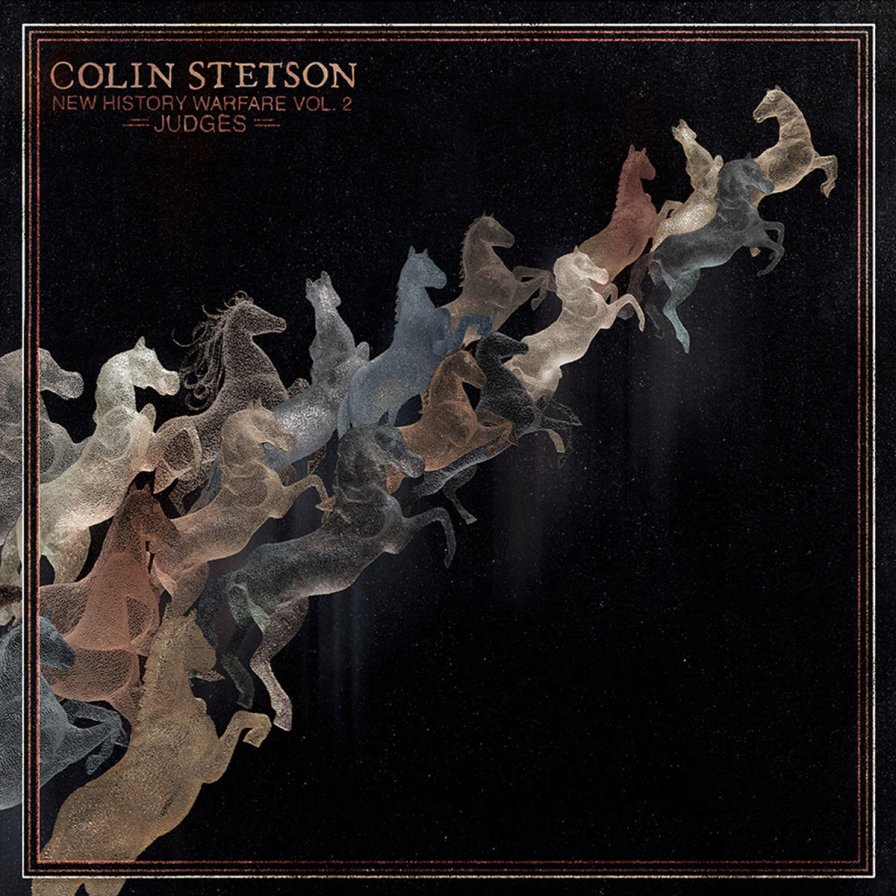
I once saw Colin Stetson play solo in a jazz club in Dortmund, Germany. I guess Jazz Time is different from Rock & Roll Time, or the Germans’s reputation for timeliness is correct, because the ticket said 8:00 and by God they started at 8:00. This was unheard of in the American rock bars that I was used to frequenting. So I got there late. Perhaps this was for the best, because the effect of opening the club doors into a wall of sound coming from a solitary man onstage couldn’t have been planned. The audience remained Germanically stoic until the last blast from Stetson’s bass sax faded away and, after a pause, someone in the back of the room said “Wow.” There’s really no other proper reaction to Stetson’s playing, which he perfected for New History Warfare Vol. 2: Judges. Stetson placed contact mics strategically on his horn and on himself, which picked up his superhuman performance to create a full band’s worth of noise. For this outing, Stetson invited Laurie Anderson and Shara Worden to perform vocals that describe the terrors of war, just in case he alone wasn’t loud enough to evoke the same. He needn’t have worried.
67
18+
MIXTAP3
[Self-Released; 2013]
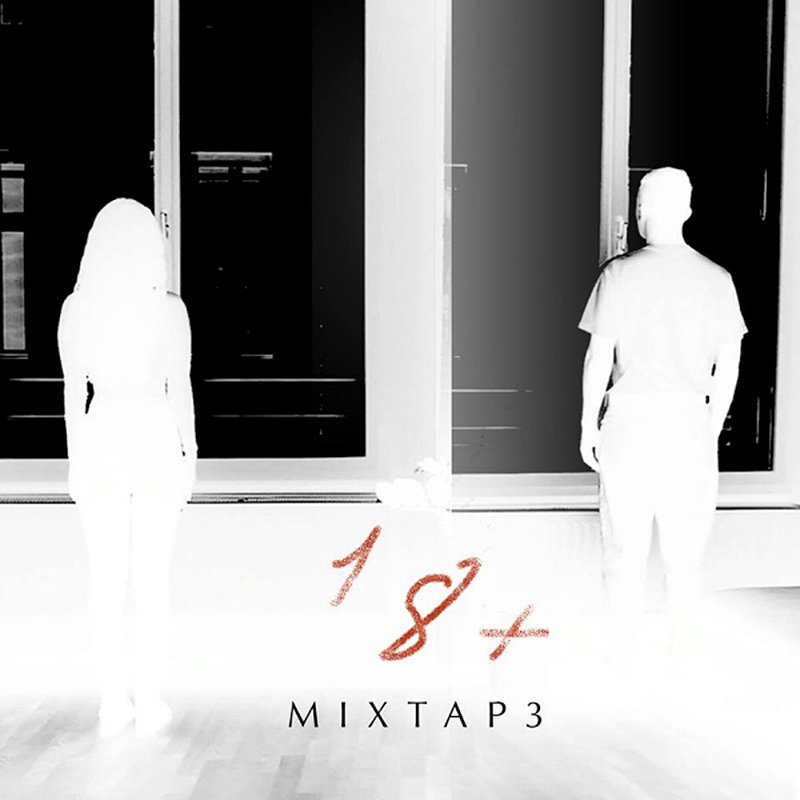
MIXTAP3 was an exoskeleton with the vulnerable innards included. Bright and dark, cold and warm. It was streaks of spit and sour breath on avatar skin. It was ringtones and heels clicking in an alleyway. Chords and notes trailed like lamplight. Boy and Sis moved with wolf smiles and soft hand, their breath percussive through unconsciously relaxed jaws. Eyes shifting. Their words were equal parts dismissive and full of longing, like a fuck-site profile come to life. It was easy to visualize the pair nodding to every beat, slowly twisting thumb rings in a corner. Alone and watched. But physicality isn’t gospel. What MIXTAP3 explored and facilitated so perfectly was the lift and tilt of persona, what could be expressed and unseen.
66
Grimes
Visions
[4AD; 2012]

It’s so easy to forget now. Especially now, when you have a bullshit job where you want to tell the boss to fuck right off and wipe that shit-eating smile off his lackey’s face. It’s easy to forget that once you could feel something with music. Feel a lot more than distraction, or mere admiration. When music was your blood, more than anything else. A good beat, a good voice…that was enough to forget about everything else and remember who you are.
I know you’re faced with something that could consume you completely…
Music has been so much to you. It’s given you life, it’s brought you closer to your friends, your family, the ones you loved. It has given you friends, for fuck’s sake. Have you forgotten that?
You could be a better friend…
But now you remember. You remember what C told you to begin it all: Shut. The. Fuck. Up. Even now, years after you played this, you still feel something greater than you understand. The dynamics have changed, with so many gone and moved on. [So many yielding to despair like it was trendy]. Don’t… no. I know you won’t give in.
I know the way (I don’t know the way…)
That’s right, remember. This. Is. Not. You.
65
Titus Andronicus
The Monitor
[XL; 2010]

Like most people of this generation, my first exposure to Titus Andronicus was, of course, when the blogs posted about them performing “A More Perfect Union” on Late Night with Jimmy Fallon. Of course, that led to seeking out The Monitor in full, which led to realizing “A More Perfect Union” was actually a seven-plus minute anthem that opened an exclusively anthemic album, followed by thoughts of “what’s all this about the Civil War now?” and then ultimately culminating in this next thought that is concise yet said with complete confidence after all this time: The Monitor is a masterful album. Set against the backdrop of one of history’s greatest internal struggles, the album dug in on all kinds of personal internal struggles that have come to, in part, define this weird decade. How can we solve any of the world’s problems when we can’t even solve ourselves? Is this still a war we can’t win? After 10,010 years, it’s still us against them, still us against them, still us against them, and they’re winning. The key to surviving, though, is to keep the fight alive, regardless. “You’ll always be a loser and that’s okay.” Scream it until you can’t anymore. Rally around the flag.
64
Jeremih
Late Nights: The Album
[Def Jam; 2015]

Sardined centrally in a crush of clubbing bodies; the Uber should be here by now; we couldn’t get out of that summer rain. Listen to me: I’ve been working on a list of situations not improved by Jeremih’s Late Nights: The Album, and the list is short. Jeremih’s salacious R&B was so effusively infectious that every second of it displaced the right now with a pulp of phased-out memory, real and imagined, warmed and cooled by effervescent bisexual lighting. Blame it on the drink, baby. As late, late night blurred into early morning, as drink flowed and intermittent trysts came and went, Late Nights slid from the crystal heights of “Planez,” to the stumbling clatter of “Give No Fuks,” to the woozy womp of “Woosah,” into the next-morning migrained clarity of “Paradise.” Don’t worry what time it is. All your friends are still here: Future, YG, Migos, Big Sean, Jhene Aiko, Juicy J, Twista. No one’s going home; no one’s running behind. On Late Nights, every hi-hat split itself into triplets, every backbeat was the flick of a lighter, and every sinuous inch of melody was so pure that it was hard to imagine a time when it didn’t exist.
63
Charli XCX
Vroom Vroom
[Vroom Vroom; 2015]

Charlotte Aitchison always had a good ear when it came to diversifying her production. But before Vroom Vroom (and despite her involvement in some absolute classics), she struggled to find a consistent sound that could match her persona. And then along came SOPHIE. While this marriage of pop powerhouses was perhaps inevitable, it was still really cool when it happened. Vroom Vroom looked like a lap dance in latex, smelled like perfume and sweat, tasted like Red Bull and vodka, and felt like grime and chrome. And it sounded like the future. SOPHIE’s production was dynamic and energized, but Charli herself is the reason we’re still talking about this EP. She flowed seamlessly from pleasure-seeker to provocateur, displaying the confidence of a pop diva at the top of her game. With a trunk full of the best beats and hooks of the decade, Vroom Vroom was Charli XCX behind the wheel of a lavender Lamborghini, parked and honking outside your house, as if to ask if you were game enough to come along for the ride.
62
Aaron Dilloway
Modern Jester
[Hanson; 2012]

Emerging from an immersive, cultural shift, Modern Jester was conceived several years after noise proliferator Aaron Dilloway left his home in the US and spent several months collecting field recordings in Nepal. The way in which that overseas experience directly impacted his approach to production here is unclear, but the very thought of tackling a creative outlet after spending a prolonged period in new environments is exciting at the best of times, let alone when left at the hands of such a staunch and expressive practitioner. Modern Jester came way after Dilloway’s impeccable Sounds of Nepal series, but the frantic and coarse approach to field recordings could be heard all over the latter release, as it drew on musically diverse and abstract themes: automation, repetition, fear, isolation, desperation, and havoc. From the 18-minute cacophony of “Look Over Your Shoulder” to the berserk frenzy of “Tremors,” Modern Jester exemplified the sheer breadth of possibility within creative composition while remaining aligned to a core aesthetic. Every listen conjured a range of emotional responses, which felt as though they were based on direct experience — from Nepal or otherwise — and even now, Dilloway’s berserk masterpiece remains utterly unparalleled in both ambition and audacity.
61
Jessy Lanza
Oh No
[Hyperdub; 2016]

Jessy Lanza rides a bicycle in the music videos for “Oh No” and “I Talk BB,” released about a year apart. In the former, she emerges from the fluorescent light of an underground parking garage to the dark streets above, where she, her reflective jacket, and the pavement below are lit by the flashing, multicolored lights woven through her shocks. There are signs of life around her — some distant traffic, a customer loading up his car with groceries — but all of the attention is on Lanza and her psychedelic ride. Eventually, her environment begins to distort and fall away, like in the moment at which the viewer becomes one of her wheels, and the world turns into a spinning void. The video for “I Talk BB” has more pathos; from close range, we study people and animals, couples and individuals caught up in their interior worlds, and other engaged in their own forms of commute, all bathed in diffuse sunlight as Lanza passes them by on her bike. We see stock images of smiling families and professionals plastered on shop windows and benches. On Oh No, Lanza’s ecstatic pop takes you on both kinds of ride: it can be chaotic, obscure, and subjective, or it can be bright and empathetic, putting you in touch with something outside yourself. Here, Oh No is not an exclamation of horror or disappointment; it’s giggled with tentative excitement, like a reaction to something thrilling and unfamiliar.
60
Klein
Tommy
[Hyperdub; 2017]

Love & hip-hop: Atlanta — that’s, like, a reality TV show, right? Yes, and it’s also electronic artist Klein’s backstory for her debut album on Hyperdub. Beyond providing a title and a source for sound samples, the show’s bad-girl guest Tommie Lee served as an archetype of obstinance: “What would Tommie do,” Klein mused in an interview, “like, she wouldn’t even care.” Likewise, three albums into her own career, Klein showed little interest in playing sweet with the powers that be. Recorded primarily in her bedroom, Tommy was as volatile as its namesake’s reputation: gaseous piano chords looped over fractured beats, blasted by noise, then smeared into opaque drones. Whether crooning or chanting, Klein sang wordless alleluias chapeled in her body, riffing across scales with gospel exuberance. Produced with an ear for entropy, Tommy thrillingly bridged two separate worlds, the musique concrète tactics of Pierre Schaeffer’s avant-garde with the vocal prowess of Billboard R&B divas. But unlike her plaque-chasing peers, Klein has better sense to save her walls for family portraits. Real gold, as Klein well appreciates, can’t be won by committee vote. It doesn’t sparkle so brightly — or so easily.
59
Low
Double Negative
[Sub Pop; 2018]

On Double Negative, Low had successfully pulled off a feat few recording artists would’ve dared entertain for a 12th album in a 16-year-long career: they’d transposed the essence of what made their music different than anything that come before into a sound both fresh and contemporary. In Low’s case, what that meant was putting the bewitching vocal harmonies of founding members Alan Sparhawk and Mimi Parker through a metamorphic treatment of heavy digital processing, chopping and twisting and then ultimately placing them against an indescribable, half-instrumental, half-synthesized backdrop that clattered around as if molded from static alone. On the one hand, listening to the album was akin to discovering a decaying Disintegration Loops-like residue of a musical past, which was somewhat cheekily making the self-deprecating point of the datedness of Low’s world; on the other, Double Negative offered a blueprint for veteran artists whose spirit had not gotten old but whose expressions could use a facelift. More than anything, though, the album belonged: to Low’s awe-inspiring legacy, to a post-genre musical landscape, and to a world that increasingly felt like a disintegration loop itself.
58
Jam City
Classical Curves
[Night Slugs; 2012]

Classical Curves was the sound of a new world in the process of creation. Released in 2012, it thought through the emerging aesthetics and politics of the post-recession: a world in which decay was made structural, where collapse was folded into “growth.” It made visible the wreck of neoliberalism, its primal scene, endlessly repeated — buildings with pools and doormen in a state of constant tumescence, accompanied by homeless people round the corner, always kept out of sight. In Jam City’s native south London, Classical Curves sounded like “regeneration,” the flattening of specificity to make way for a verticalized generic. In its jackhammer beats, we heard the demolition of shopping centers, the exile of local communities, their making way for dull flats, lifeless gyms, and bad coffee. These losses wrapped themselves around Classical Curves, making themselves heard in its vocalic synths, their sighs the echoes of lost worlds. No mere exercise in late-capitalist fetishization, then, Classical Curves wanted to move us. It wanted to make us dance, and in so doing, it wanted to make us think. In its elegantly-shaped empty spaces, in the uncanny funk of its mechanized movements, and in its provision of a shape for pop to come, Classical Curves developed a sound that helped us understand where we came from and where we were going. This was how we related to our bodies, our clubs and our cities in the deadened hyperreal zones of the 2010s.
57
U.S. Girls
Half Free
[4AD; 2015]

Eight songs and a skit was all it took. Despite its brevity, Half Free felt enormous, genreless, miragelike. Its production hit a pleasingly foggy mid-fi sweet spot, overcast, suggestive, noirish — an appropriate objective correlative to the stories its songs contained, populated by dead soldiers’ widows, familial cruelties, and strained spouses, all told first-person. These were stories, all of them, about women wronged by men, or left behind by men, or contemplating vengeance upon men. The eight songs played around with as many genres, tied together by Meg Remy’s voice and almost country-esque command of sung storytelling. The heart of Half Free, though, wasn’t really a song at all. It was “Telephone Play No. 1,” the minute-long Rorschach blot of an interlude that stopped the album after two tracks. With each listen, it could reveal a new meaning, and yet it was the hardest thing on the album to listen to, the aural equivalent of the very bright light an optometrist shines into your pupil to look at the back wall of your eyeballs.
56
Triad God
黑社會 Triad
[Presto!?; 2019]

NXB, the full-length start to the partnership between London via China via Vietnam MC Vinh Ngan and experimental electronic pop producer Palmistry, had all the markings of the unique aural aesthetic the two would decide to stamp the name Triad God squarely on. It was 黑社會 Triad, however, following after seven years of near-radio silence from Ngan, that took that aesthetic and turned it into a sublime, unprecedented sound artifact of crushing immediateness and bewildering beauty. On 黑社會 Triad, Palmistry’s minimal synth melodies and deconstructed hip-hop beats dissolved into digitized operatic yowls and towering ambient vistas, while Ngan’s lethargic, mostly-Cantonese rapping became full-on confessional poetry, delivered via fragmented, half-awake monologues. As the album progressed, the two sources of sound and substance became increasingly desynchronized, to the point of their co-existence appearing less like music and more like a field recording of a very real, very painful moment in someone’s life. Listening to vignettes such as “So Pay La” felt like having your friend suddenly pour their heart out to you in the wee hours of a Sunday morning, when you’ve had way too much to drink and can’t wait for the person working the kebab stand to call out your name. You don’t understand half of what your friend is saying, but the gravity of the moment hits you just the same. And then you listen.
55
Drake
If You’re Reading This It’s Too Late
[Cash Money/OVO; 2015]
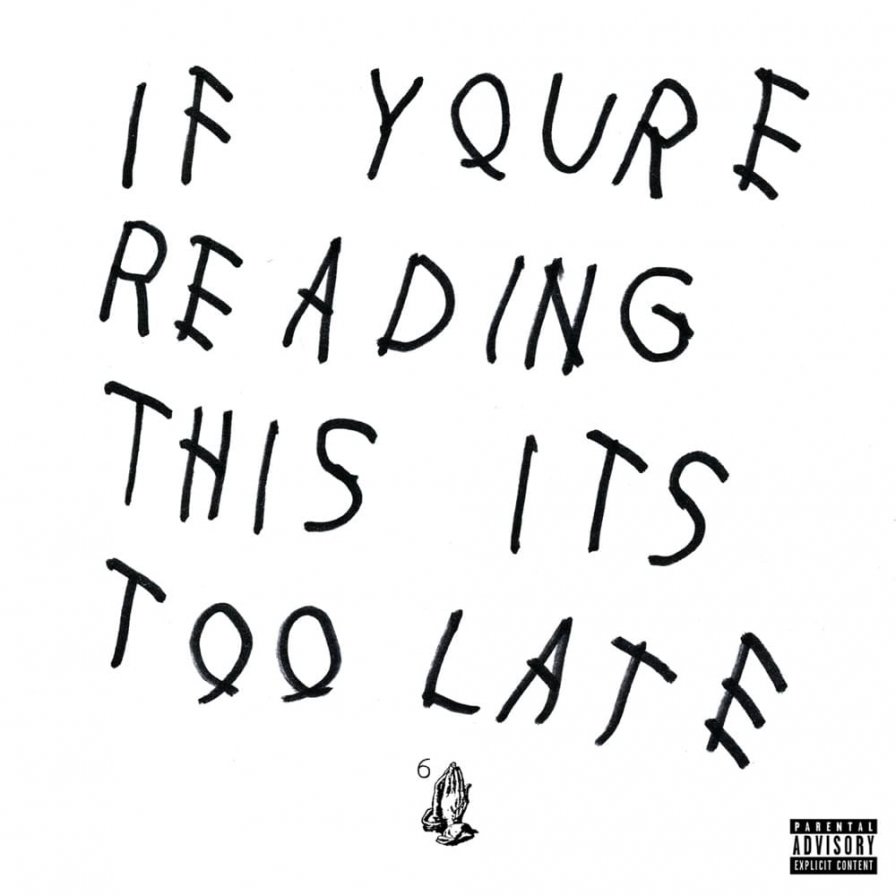
And, just like that, Napoleon crowned himself. Finally endowed with the heavy airplay (all day / with no chorus); laundry list of famous exes; and, well, bands that a young Aubrey had always flirted and fantasized and fronted about, Drake emerged on If You’re Reading This It’s Too Late as an a priori. No longer just my homie over there who think ur cute, the perpetual aspirant already unconvincingly flexing with Nickelus F on Room for Improvement, Drake could finally stop orbiting every possible influence, opportunity, and storyline and let his own tumid gravity constellate his place in the pop/rap cosmos. The self-styled (for how could it be otherwise?) 6 God looked good as a celestial body, his stardom as unassailable (though truly nothing was the same with dude after Sauce Walka ethered him — OOWEE!) as it was inaccessible. None of which is to say that Drake’s hard-won iconicity licensed empty simulation, the stuff of media studies undergrad dreams; if anything, If You’re Reading This demonstrated why Drake’s corpus of pastiche and reference, a seriously jacked body with seriously juiced organs seemingly cobbled together out of logos and other simulacra, commanded such fervent brand loyalty. On display in If You’re Reading This were Drake’s unmatched powers of curation and customer service, his perfectly calibrated sensitivity to the affective life of human capital in a rapidly and rabidly freelancing world pivoting to video. Because who else other than the internet’s busiest simp could demonstrate how performative disavowal is no match for the architectures of desire goading our most egregious and mundane fantasies? Sorry Jenny Holzer, Drake isn’t going to protect you from what you want. He is what you want. Oh, you gotta love it.
54
Jason Lescalleet
Songs About Nothing
[Erstwhile; 2012]

With its cheeky concept and punny track titles, one might be tempted to assign a type of theoretical gravity to Songs About Nothing, casting it as some high-level comedy of deconstruction. One might be impelled to hunt down traces, quaff some pharmakoi, and split the différance. And that’s all well and good. Discourses about appropriation, decontextualized sound as plastic, politics of pastiche and irony, metaphysics of presence, decay and deformation, being and not-being: each potentially generative avenues of exploration into Jason Lescalleet’s monumental work. However, we don’t need to distract ourselves with what is external — Songs About Nothing stood alone populating the void, in defiance even of its own title and network of samples, references, and appropriations. Great buzzing existential meatsaws scourged its 76 minutes and shred all stable signifiers within. Whether it was the Big Black samples stretched and savaged and smote completely; the sounds of birds, trucks, protests, and helicopters; or the low, insinuating tones encrusted with digital manipulation, the corruption, the destruktion, was total. There were no little ditties or ambient soundscapes, just obliviated airs and anti-environments. While, of course, no thing can be about nothing, it was difficult to escape a sense of vacuum here, an inert core around which Lescalleet had constructed his capital — gleaming spires of nullity and broad boulevards of implosion. It was equally difficult to visit that place without at least carrying back the faintest whiff of annihilation.
53
Lorde
Melodrama
[Republic/Lava; 2017]

What is this tape? The tape was Lorde’s album-long ode to the passion of youth and the beauty of destruction. It was a generational statement. Maybe I was a generation behind, but none of that mattered. I fell in love with this tape — its dazzling synth lines, introspective hooks, and Instagram-ready lyrics. No other pop record from this decade better captured living fast and dying young. Whether it was blowing her brains out on the radio or ending up painted on the road, Lorde (like so many singer-songwriters before her) distilled her experiences into universally relatable moments. This was what it felt like to be a 19-year-old in the 2010s. It felt like staying up late, alone in the dark, writing something. It felt like being the only person on a subway car full of strangers. It felt like something slipped under your tongue, the excitement of telling a friend that that one person texted you back. It felt like you were on fire. And this tape was worth sharing with someone you love so that your fires could feed on one another, burning brighter and fiercer. So what is this tape? This is my favorite tape.
52
Kendrick Lamar
good kid m.A.A.d city
[Top Dawg; 2012]

Are there any words that have yet to be spilled about the major label debut from one of the most popular rappers working today? Perhaps it’s worth honing in on the fact that good kid was personal and emotional, serving as an entry into a mainstay genre that isn’t frequently known for either of those things. Kendrick wasn’t immune to the characteristic bravado, but while that personality trait permeates among rappers seemingly out of career or cultural necessity, what we had on the album was a retrospective on youthful misguidedness. The machismo reflected on “Backseat Freestyle” isn’t who Kendrick is today, and similarly, the robbery described on the subsequent track, “The Art of Peer Pressure,” isn’t used as a feather in the cap by present-day K-Dot. It was clear as things progressed, and certainly by the end of the album, that the Compton native was more concerned with describing the mindset, commonly errant and adjacent to tragedy, that he had growing up in the 1990s and the 2000s. Clever flow and consistent production helped deliver self-awareness to listeners. Even most TV shows don’t have this level of character development.
51
Shabazz Palaces
Black Up
[Sub Pop; 2011]

It’s difficult for me to address Shabazz Palaces historically, because they initially struck me as an aberration. Overshadowed by a residual “O.G.” politics, their earliest EPs felt just a little too stiff, too needlessly esoteric, for me to fully enjoy, like a pre-Wu Genius close-reading Farrakhan. And aside from pulling the obvious “hipster rap”/backpacker card, calling these guys “old school” was probably the biggest diss you could lob; Ishmael Butler clearly wanted to do something different with his resume. So, hardly rejecting their posture’s awkward inconsistencies, Shabazz Palaces’ 2011 debut album Black Up pretended a subtle homage to the debased currency of youth. And it worked, all because it hinged on risk and diversion. I say risk because who, exactly, was clamoring for this kind of album in 2011? Who, exactly, was Shabazz Palaces for, aside from maybe Butler himself? Despite their continued presence and with the benefit of hindsight, I’m still not sure I know the answers to those questions, and I don’t want to pretend I do. Ultimately, it’s easier to define this album by what it wasn’t, rather than what it was — and it certainly wasn’t Take Care.
50
Julia Holter
Loud City Song
[Domino; 2013]

One of this decade’s great gifts has been the ability to hear the subtle transitions, and stunning transformations, of Julia Holter’s art. From there to here, her work stands as a discrete series of high points. Truthfully, any one of her albums, from Tragedy to Aviary, could be on this list, and no one here would question it. And still, here we are, choosing to recognize it from among the bunch. Why? I think, to begin with the lazy music-critical answer, Loud City Song was the first album of Holter’s that could qualify, if only peripherally, as pop music. People like pop music, and people like conventional narrative development in artists. (Some people even like cities and their loud songs, as well as their apparent signifiers — and how they all work back into pop music, and developmental narratives! Phew.) But listening closer, you’ll find that there is little Loud or City or Song in this album at all. Rather, the album works on its listener through an almost subliminal inversion: the loud is heard only in relation to a deeper, more pervasive quietude; the city is absorbed entirely in private rooms, in private sentences and in their words; and the songs themselves are assumed because the tightly composed drift in which they blow about suggests their shape. It is a marvelous thing to listen to that reveal itself like a secret, anew, nearly every time you listen. That this album can still play its beautiful tricks on us more than justifies its place, here.
49
Various Artists
Sounds of Sisso
[Nyege Nyege Tapes; 2017]
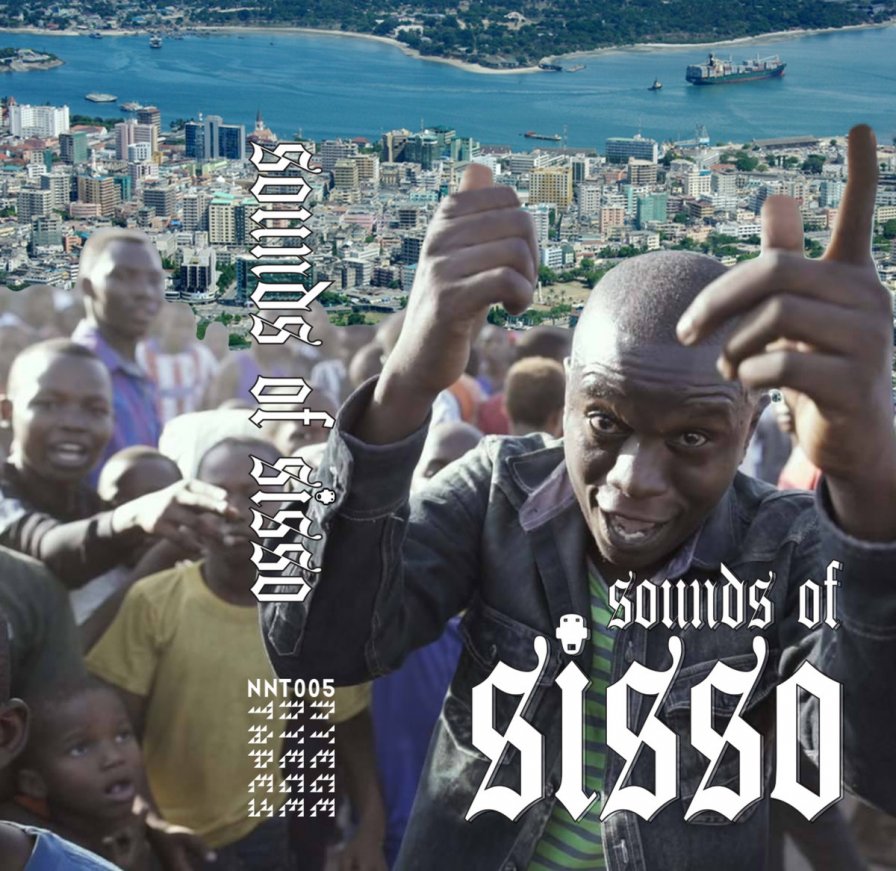
Much of the most innovative music around today emerges from hermetic scenes on the margins of the Global North centers of cultural production, & nobody can convince me otherwise. By definition, these artists are not recycling or mimicking imported tropes so much as rearticulating motifs from their own milieus in ways that elude the pigeonholing nomenclature in which “the outside” operates. What kind of music is singeli? It’s singeli — duh! Trying to communicate the aesthetic in writing (“it’s… uhh… East African gabber”) is precluded by the same futility that makes translations of foreign poems just glorified synopses; “you wouldn’t get it, so here’s the gist.” Fortunately, you don’t have to learn a foreign language to “get” singeli — just give up on that habit of expressing the marginal in terms of the hegemonic: gabber might just be European singeli. Indeed, the Dar Es Salaam scene is so insistent on commanding its own identity & future — not ignorant, but impervious & indifferent to the outside — that its spirit even seems inflected by post-colonialism. Writing from the Global South myself, I’m a sucker for that shit, keeping it on speed-dial ever since the Sounds of Sisso scene manifesto broke ground. While it’s heartening just how much love the singeli crowd has gotten in the past couple of years, we’re the ones who should be thankful; it’s an honor to have them on this list.
48
Arca
Mutant
[Mute; 2015]

Arca’s Mutant soundtracked my walks home from work in the late fall of 2015, my clothes drenched in the smell of a restaurant kitchen as I sauntered down dark sidewalks with aching feet. And for months, plugging in my headphones for the walk home, I would shrug, think “Mutant again,” and bathe in the fleeting euphoria of having finally clocked out. At that time, my life was mostly a lonely rhythm, and a monotonous, directionless one at that: waking up, going to class, going to work, walking home. Had I been more interested in what I was doing, it might have felt melodic, but it was more of a static buzz than anything orchestral. Then, quite refreshingly, Mutant came into my life offering barely any discernible pattern. Even its most serene melodies were cradled within the unpredictable and occasionally the grotesque. Ambience fluttered beneath cinematic non-sounds, unrecognizable flourishes of tonality and inflection. It was less an escape than reassurance that not everything is trapped within form and predictability, and that alternative narratives and histories can emerge quite unexpectedly and at the perfect time. Despite Arca’s fondness of unnerving sonic intensity, Mutant never wholly embraced destruction. Its core edifice seemed more concerned with occupying the space between ugly and pretty, between serenity and violence, a blur of ambiguity smeared onto the walls of whatever dared tried to contain or define it. As such, I found Mutant engrossing, almost literary for its cavernous exploration of feeling and depth, a poetics of the inexplicable. Mutant was never a way out, but a way in, a path toward something I couldn’t quite understand, and never wanted to.
47
Playboi Carti
Playboi Carti
[Interscope; 2017]

Drowned in pastels, an amniotic sluice of pillowy synths and subtly intricate drum programming, the production on Playboi Carti not only foresaw the coming decade’s hip-hop new age, but showcased exactly why Carti’s style would play an instrumental role in it. There was a numinous quality to Carti’s raps. It had something to do with the way his verses danced like light playing off a water’s surface. It had something to do with the intrinsic, lambent joy that the Atlantan rapper imparted — the way he could condense the very peak of a vibe or hype moment, stretch it, and then bottle it in song. The result being that, at any point in any given song, Playboi Carti seemed like the most alive person on the planet. Which wouldn’t mean a lot if the feeling weren’t so ridiculously infectious. But, above all else, it definitely had something to do with his deconstructed flow, a delivery that was no doubt one of the decade’s most aesthetically sublime musical objects, which the world came to know in earnest here, his first full-length effort. With a dazzling emphasis on vocal melody and mood, Carti rendered each track little more than a blank canvas for volatile ad lib improvisations. And the mixtape’s very best moments were, essentially, just that: one giant series of ad libs rushing in and out of the mix. The beats here, especially those courtesy Pi’erre Bourne, were precisely arranged to highlight the strange mechanics of Carti’s flow. If Young Thug is really the first “post-text rapper,” then Carti might be the first to transcend bars almost completely.
46
Farrah Abraham
My Teenage Dream Ended
[MTV Press; 2012]

Sometime around late 2014, I banned myself from listening to My Teenage Dream Ended. Something as simple as the filtered breakbeat on “Only Me,” the heartbeat on “Searching for Closure,” and the fade out to Hawaiian lap steel on “The Sunshine State” could easily trigger a devastating, irredeemable breakdown — the kind that leaves you twisted and inconsolable. After the cry hangover, I’d listen again. This happened for two years straight. The semi-rhythmic cadence and chilling treatment of Farrah’s voice became the narrator of these episodes, a stand-in for a permanent nervous breakdown echoing maniacally across the decade. Farrah’s accessible YouTube tutorial presence and reality TV persona would melt away into a Trecartin-esque figure, unhinged into abstraction. Producer Fredrick M. Cuevas’s heinous use of Vengeance™ sample packs — compressed into gnarled, blunt forms — supported Farrah’s haunted messages: the whispers of “don’t tell” on “After Prom,” her proclamations of “FLA Appeal to me!” over a single monophonic synth blast. For the love of American dubstep, for the love of perpetual auto-tune, for the love of all that’s evil in the world, we stanned into oblivion. In that oblivion, to quote Rowan Savage’s review, “the author’s Self itself is irrelevant, because it now encompasses the world, magnified — and in that magnification, reveals the seams.”
45
Earl Sweatshirt
Some Rap Songs
[Tan Cressida; 2018]

For an auteur, Earl Sweatshirt seems preoccupied with the understatement. Roughly the length of a Seinfeld episode, the L.A.-based emcee’s most personal work to date seeked to obfuscate itself. Its title was almost impudently self-effacing and the accidental cover art was likely culled from Earl’s camera roll or a Snapchat memories folder. He’s always been known for his reticence — his last record was called I Don’t Like Shit, I Don’t Go Outside, after all — but this effort established Earl as a hip-hop analogue to Richard D. James or Burial. Unlike Kanye, who has churned out his own his own string of comparably short releases in recent years, Earl didn’t require frantic rollouts or release parties to contextualize his work. Instead, he was an anti-persona of sorts, revealing himself solely through his verses, save for the occasional winkingly cryptic tweet.
If it were as accessible a medium as streamable album, Some Rap Songs could have conceivably found life as a poetry chapbook, its hacked-up jazz samples swapped out for a Xeroxed photo-collage or some vague film photography. Most tracks clocked in at around a minute and a half, carried by a conversational open-mic-night delivery and unvarnished instrumental loops that growled and undulated like stirring creatures. The production was swampy — beyond lo-fi, even — and it was Earl’s pen that prevented us from drowning in the murk, intentionally sending listeners to the internet to find transcribed lyrics.
On wax, Earl’s writing sounded effortless and casual. On paper, it divulged its poetic complexities. Compressed into dense chunks of meaning, stanzas bulged with subtext and tucked emotional weight into enjambment. Earl gave updates on his life like a human projector reel, eschewing lyrical scene-setting for disjointed slideshows of snapshots: picking out his father’s grave, finding new collaborators in MIKE and Medhane, bad trips. Images passed by as unpredictably (and sometimes as painfully) as calendar dates being retroactively filled in.
“Why’s it so muddy in the creek, poet?”
Earl’s at his best when he just misses the mark, carving out ghostly tableaux with the bluntest edge possible. “Imprecise words,” indeed.
44
D’Angelo
Black Messiah
[RCA; 2014]

“Who will survive in America?” How do we conceive sexual healing when bodies that bend into kisses are subject to hails of police-sanctioned bullets? How do we sing soul when we can’t breathe? Two truths: soul music, the righteous reaffirmation of the revolution as incontrovertibly bodily, is incontrovertibly America. And: the premeditated extermination of brown bodies is also (incontrovertibly) America. This is the world D’Angelo returned to; this is the world D’Angelo left. Over the squelches and heaves of Black Messiah, confusion and outrage emerged, a gospel anger over real fear. Even that falsetto, the one we’ve always quivered for, cannot balm the truth we heard articulated every day of this agonized decade: this world is killing us. And yet alongside that anxiety was a love and a joy so hot and bright we felt opened up and sated in an embrace we’d craved, still crave. Hate and love on two hands. This too, is not a contradiction. The stakes of those poles, the duality and want in D’Angelo’s voice, we heard the struggle of every body seeking the right to be alright. Black Messiah, the fire this and next time, burned like Langston: “O, yes, I say it plain/ America never was America to me/ And yet I swear this oath — America will be!”
43
Ariel Pink’s Haunted Graffiti
Before Today
[4AD; 2010]
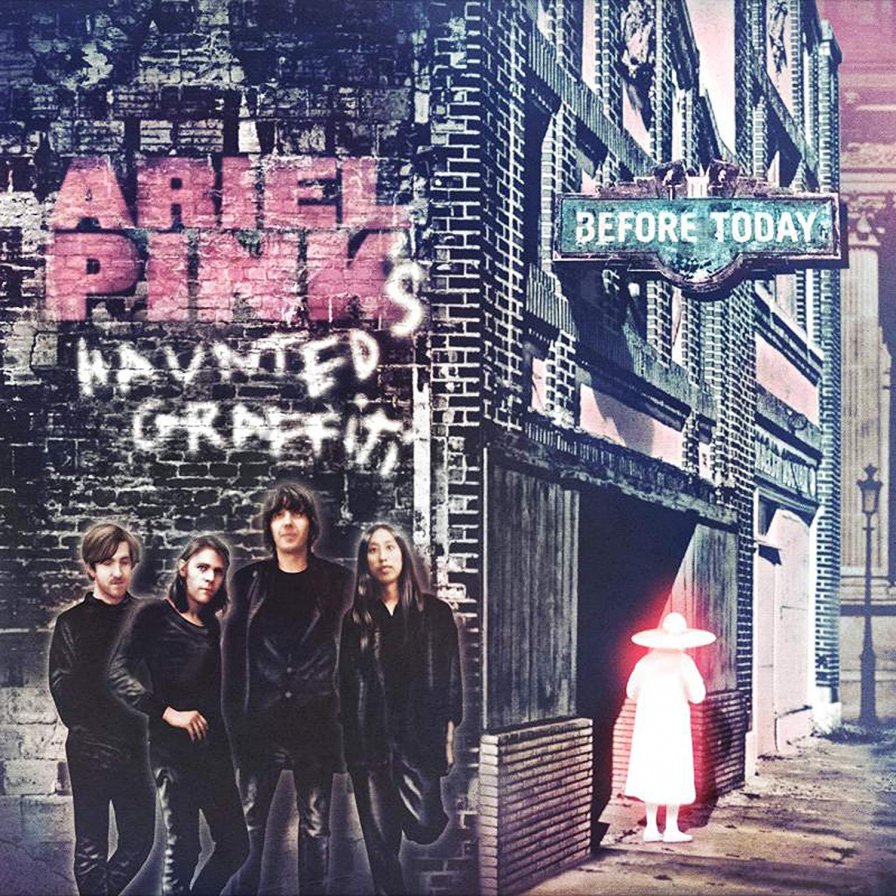
Ariel Pink spent most of the 2000s establishing himself as the new golden child of lo-fi music, recording wounded, nightmarish pop songs that carried the same torch as outsider geniuses like Tonetta and Daniel Johnston. At the height of the late-2000s indie boom, however, he leapt to the big leagues by signing with 4AD, taking his act to a new level on par with heavy hitters like Animal Collective, Deerhunter, and other groups who seemed to be proving that notions like “bands” and “albums” were still doing just fine. Then in came Pink with Before Today, a murky, dissociative haze of a pop record that slinked through a nocturnal wasteland of butt-house blondes and menopause men, all held together by yacht-rock hooks and the yelps of a man who sounded as desperate for sex as he was for fame. But there was truth in Pink’s sardonic pleas; unlike his peers, Pink saw the era of rock & roll disappearing into the rearview, dissolving like mush alongside all the tacky pop and TV jingles that we had previously ignored for so long. Before Today honored these forgotten cultural artifacts, elevating them to impressionistic heights with unbearably beautiful songs that cut through all of Pink’s raunchy pranks to capture the dying wish of a washed-up generation of wannabes. It was pop music built from the memories of a time now out of reach, a sound fading further and further into the distance, becoming more distorted and dreamy with each passing streetlight.
42
Fiona Apple
The Idler Wheel Is Wiser Than the Driver of the Screw and Whipping Cords Will Serve You More Than Ropes Will Ever Do
[Epic; 2012]

For the first three albums of Fiona Apple’s career, Jon Brion was a major factor. He played a slew of instruments on her groundbreaking 1996 debut Tidal, repeated the feat while fully producing 1999’s When the Pawn…, and had produced the original version of 2005’s Extraordinary Machine before Apple decided to re-record most of it instead with Mike Elizondo and Brian Kehew, though the results didn’t end up venturing far from Brion’s Mellotron-esque cinematic big band wheelhouse.Taking a full seven years to concoct her fourth album, 2012’s The Idler Wheel… saw Apple explore a rather minimalist aesthetic. Her lyrics were as fierce, emotional, and poetic as ever, but the sound was dramatically stripped down. Produced with touring drummer Charley Drayton, he and Apple (credited as Seedy and Feedy) played a myriad of eclectic instruments, from autoharp and celesta to bouzouki, kora, and Teisco, yet it always felt like simply hearing two talented musicians jamming in a room. Although the sound still delivered her typical orchestral lushness, the sparse rawness gave space for Apple’s vocals to connect on a visceral, primal level. It hit you right in the feels.
41
The Caretaker
Everywhere at the end of time
[History Always Favours The Winners; 2016-2019]

Borne of fascination with the haunted hotel ballroom of The Shining, Leyland Kirby’s The Caretaker project had long used manipulated and repeated phrases of early recordings to probe concepts of memory and mortality, but Everywhere at the end of time was a more systematic attempt to auralize the process of decay, disruption, and disintegration associated with a particular neurocognitive disorder, encapsulated in the premise that his Jack Torrance-channeling alter ego was stricken with dementia. Beginning in 2016 and released as 6 albums over the course of the following 3 years, these installments began with slightly altered — slowed down, reverb drenched, but fairly wistful and mellifluous — fragments of lighter-than-air ballroom pop, drifting in and out with a feeling of reverie. Smatterings of record-surface noise accented these songs in ways connoting nostalgia. By the end of the series, though, the signal-to-noise ratio completely tipped, with anything resembling more natural instrumental timbres mostly buried under layers of rumbling and crackling bass that were disorienting and ominous. This was the sonic simulation of the self dissipating into oblivion. The total experience was the deep subjective horror of losing oneself, an encounter with the abject, and the result was one of the most ambitious conceptual sound works of the 2010s.
40
DJ Rashad
Double Cup
[Teklife; 2013]
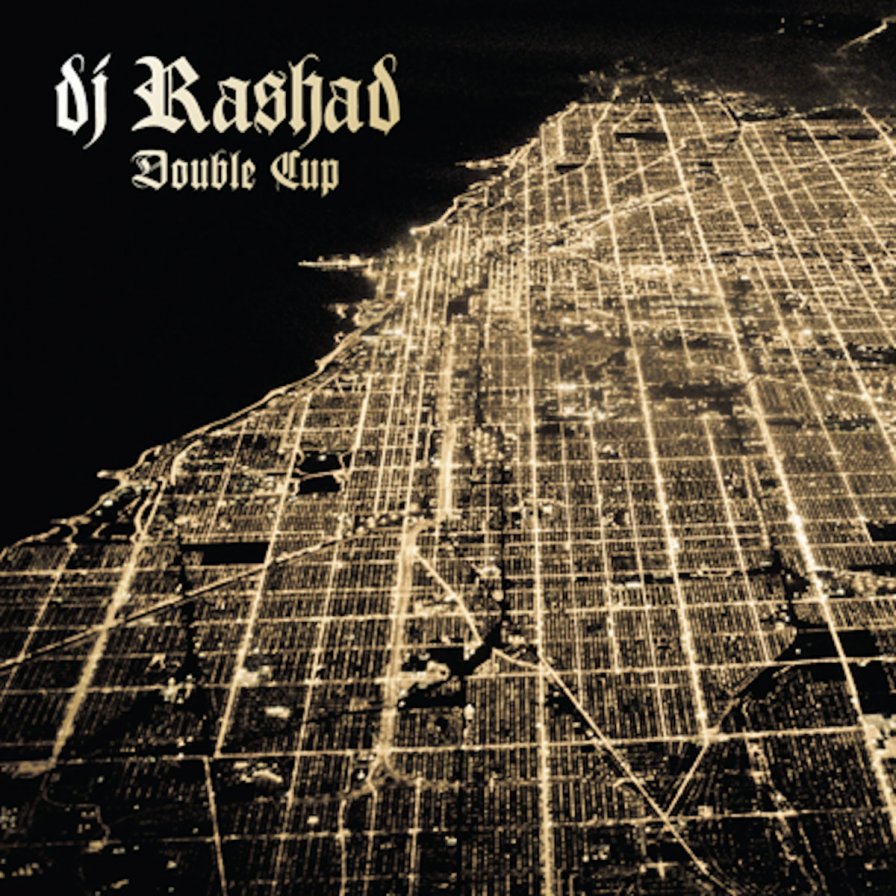
Five years since his death, DJ Rashad’s vision maintains a spiritual grip on the music world. His art and life were marked by an eternal exuberance, with his legacy defined on Double Cup, a coiled spring of hedonistic and architecturally pristine syncopation. DJ Spinn sumarized the Double Cup state of mind on its title track: “Break it down, roll it up, pass that shit, what the fuck spinning Rashad? That double cup/ Teklife we run this shit, pour up a double cup.” Rashad’s innovation was adding a luxurious sheen to his production. Whereas early footwork was militaristic, filleting samples beyond recognition and sauteeing them in a muddy slurry of sub bass, the international-facing Double Cup was undeniably VIP music. Songs like “Drank, Kush, Barz” and “She a Go” could be jammed in a limo or hotel lounge, whereas “Acid Bit” and “I’m Too Hi” drew parallels between house, rave, and the DIY spots where Rashad and Spinn used to mix for footwork crews all night. In just under 10 years since Planet Mu brought the thriving Chicago footwork scene to an international audience, the power and influence of Double Cup has only grown.
39
Death Grips
The Money Store
[Epic; 2012]

Death Grips’ affiliation with Epic Records was as quick as it was conspicuous, but in retrospect, doesn’t the major label deserve some credit for helping to develop the DG sound? “Naw, fuck that,” MC Ride indirectly responded on the eponymous track. It’s clear looking at the backstory and the releases that happened afterward just how unshakably careening the trio of Ride, Zach Hill, and Andy Morin were from their inception. The Money Store happened despite the institutional support implied by labels clamoring for a signature, and the relatively sample-free (compared to the preceding Exmilitary) brutality therein felt like a natural continuance and an initial show of artistic solipsism. Death Grips highlighted the importance of their “vision” around the time of the album’s release. The album itself left us with a sense that cohesiveness was totally compatible with ambiguously violent lyrics that were certainly more heaved than they were sung or rapped. And, ultimately, the insanely catchy hooks that announced “SYSTEM OVAH” or “double… d-double” had no suited producer to thank. Music world, meet the unstoppable force with no immovable object.
38
Tirzah
Devotion
[Domino; 2018]

Devotion is a gift. The London-based designer and musician Tirzah Mastin took over six years between releasing her debut pair of experimental, bassy EPs on Greco Roman (No Romance, I’m Not Dancing) and her debut album, Devotion. The radical departure from club sounds to bedroom R&B was executed with unbridled vulnerability. The tracks on the two EPs were eclectic, fun, bubbly. Tirzah’s voice lilted like a supermarket announcer, the beats seemingly constructed from shopping mall refuse and household implements. However, slow numbers like “Malfunction” indicated where she would go next: conversational, candid, poetic yet maintaining a claustrophobic intimacy, as if we were witnessing a couple have a domestic on the tube. Few were prepared for the humility that Tirzah demonstrated with Devotion, an album that maintains a strong acuity and deft touch. Despite the sparse production and essentially naked tone of Tirzah’s voice, the album didn’t feel at all unfinished or underdeveloped. She crooned and stumbled on “Do You Know;” was disarmed and uncomfortably candid on “Affection.” The effect was like a twilight confrontation, a lover inches from your face, hot breath against your cheek, daring you to look them in the eyes.
37
SOPHIE
PRODUCT
[Numbers; 2015]

On Black Friday 2015, SOPHIE’s debut compilation of previously-released and then-new singles, PRODUCT, arrived alongside a flurry of limited-edition conceptual art-cum-cult objects that included a silicone sex toy, a transparent plastic puffer jacket, some branded future-goth sunglasses, and a pair of towering platform party heels. Each, unsurprisingly (and supposedly), sold out in a blink, snatched out of the market by the most on-it fans and collectors, but luckily enough for the rest of us, the songs kept circulating. Of the eight singles, highlights include opener “BIPP” (originally released by Numbers in 2013), which behaved a bit like a sonic cv with imperative lyrics like “I can make you feel better, if you let me.” It was soon followed by the addictively effervescent “LEMONADE” (2014), which infamously achieved the commercial crossover appeal SOPHIE and her PC Music affiliates had been sounding out all along when it was used in a summer 2015 McDonald’s commercial. And lest we forget crowning jewel “HARD” (2014), which to my mind is still one of her strongest tracks. Earlier this year, Numbers reissued PRODUCT in its original format of four vinyl singles as a testament to the way that the songs have stood the test of the latter half of the decade amidst an ever-escalating and well-earned SOPHIE frenzy.
36
Jlin
Dark Energy
[Planet Mu; 2015]

This decade upped the clutch minimalism ante considerably. There was Ninos Du Brasil’s Novos Mistérios, Shygirl’s self-titled EP, and Container’s 2015 release, but the latter’s release year and this nearly-done decade belonged to Jlin’s jarring, neck-breaker of a debut. Four years after turning our heads with her track for Planet Mu’s Bangs & Works Vol. 2, Jlin gave us this compact but ferocious opening statement. We got our “Erotic Heat” fix (juiced and reduced here), but not before a punishing sequence cresting with the dizzyingly efficient speed-garroting comprising “Guantanamo.” As much as this album throttled one’s skull, it also caressed the ear with nimble, finely embossed patterns that would make muscles contract, shy of dancing. And her spare (for footwork-based music) use of sampling felt both classic and refreshing in its nakedness. That Black Origami raised the bar Jerrilynn Patton had set here was arguable, but Dark Energy’s tightly-coiled, tension-fueled charm still felt rough and ready-built to last, much like the still-cracking melodrama sampled on its closer.
35
Beyoncé
Beyoncé
[Parkwood/Columbia; 2013]

Beyoncé is a corporation at this point. Online, Beyoncé is legally www.beyonce.com. Any associated websites, features, content, materials, products, and/or services is owned and/or operated by Parkwood Entertainment, LLC, where Beyoncé Knowles-Carter holds the title CEO. Beyoncé is the climax of Queen Bey’s superpower: algorithmic perpetuation of business.
In 2016, Beyoncé brought on (obvious Illuminati profiteer) Steve Pamon, who was JPMorgan Chase’s head of sports and entertainment marketing. Hiring Pamon was after 4, around the time she announced “I started my own company when I decided to manage myself.” And with almost no promotion and zero announcement, Beyoncé gloriously reimagined Queen Bey, as if announcing herself for the first time, similar to how aspiring pop stars typically named their debut as self-titled (e.g., Mariah Carey, Whitney Houston). Ultimately, sealing the deal (in BLOOD) with Pamon, Beyoncé miraculously materialized her sentiment, “I wanted to follow the footsteps of Madonna and be a powerhouse and have my own empire” — i.e., the algorithmic perpetuation of business.
Larger than any sports star, streaming channel, actor, museum, musician, subscription service, performer, and live event: Beyoncé is an icon. She’s who all of our kids need to discover and become. You too can absolutely be Queen Bey. Feel herself move through your body throughout the entire listening experience of Beyoncé. Once again, the tips of your fingers and follicles of all hair flutter in femininity, flush with Beyoncé. You’ve become her so many times throughout your life that you’re still becoming her. The royal we can be come Beyoncé.
Afterthought: FUCK JAY Z!!!
34
Sufjan Stevens
Carrie & Lowell
[Asthmatic Kitty; 2015]
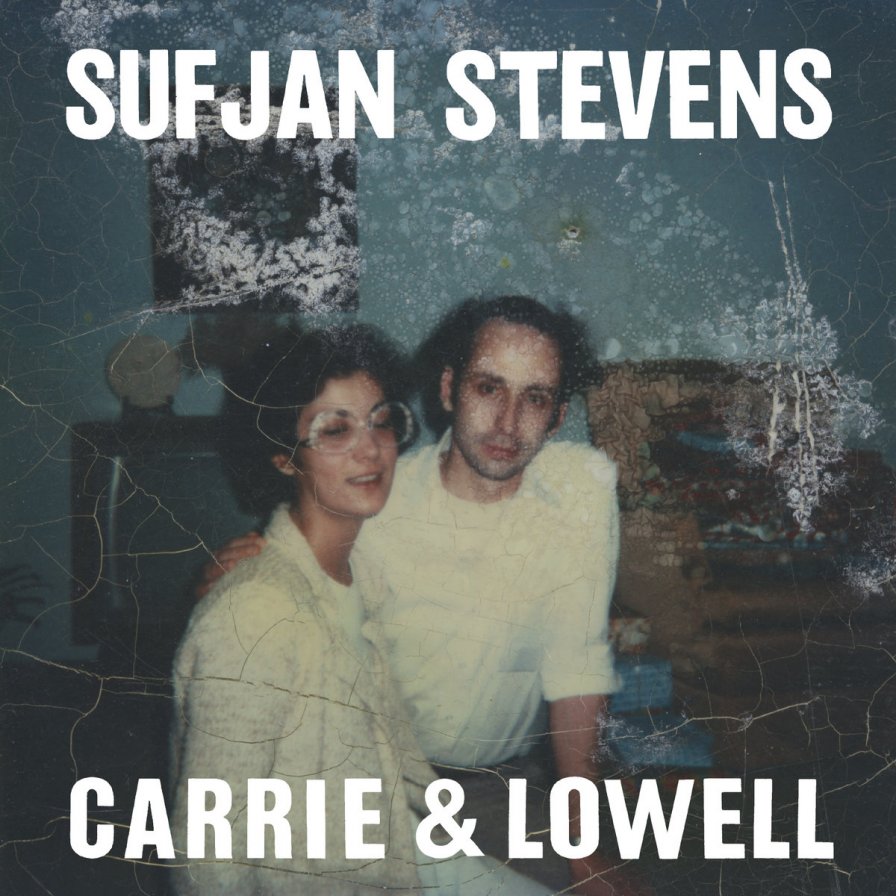
Like Sufjan, I don’t know how to begin. I don’t really listen to Carrie & Lowell all that much — it cuts too deep. In the hyperspecificity of its pain — being left at video stores, swimming lessons, hidden cigarettes — Carrie & Lowell got at some more general loss, one that found its form in the frost-bitten hollowness of its ambiences and in the rosy-warmth of its guitar-work. It was an emptiness communicated in the precarity of its melodies, just as likely to reach for the heavens as to fall the fuck apart. How to begin? Or perhaps, how to end? Because really, what was there to be done with an album whose central figure was the spirit (both divine and crushingly banal)? Whose every utterance felt haunted? This was not a hopeful record. Its questions left echoes, but no answers. How, Sufjan asked, could you mourn the losses that made you, whose only presence was their absence? What were you left with, when people depart, apart from yourself? But — and this was crucial — the spectrality of these questions was also the site of the album’s alchemy, because if Sufjan was left with ghosts, we were left with music and lyrics, with the sounds of someone trying to live with their ghosts, to ride with them. And blessedly, sometimes that was enough. Sometimes it was enough to know that Carrie & Lowell, in its despair, in its signs and wonders, in its exquisite embrace of those who leave and those who stay, was there. Whether we could hear it or not.
33
James Blake
James Blake
[ATLAS; 2011]
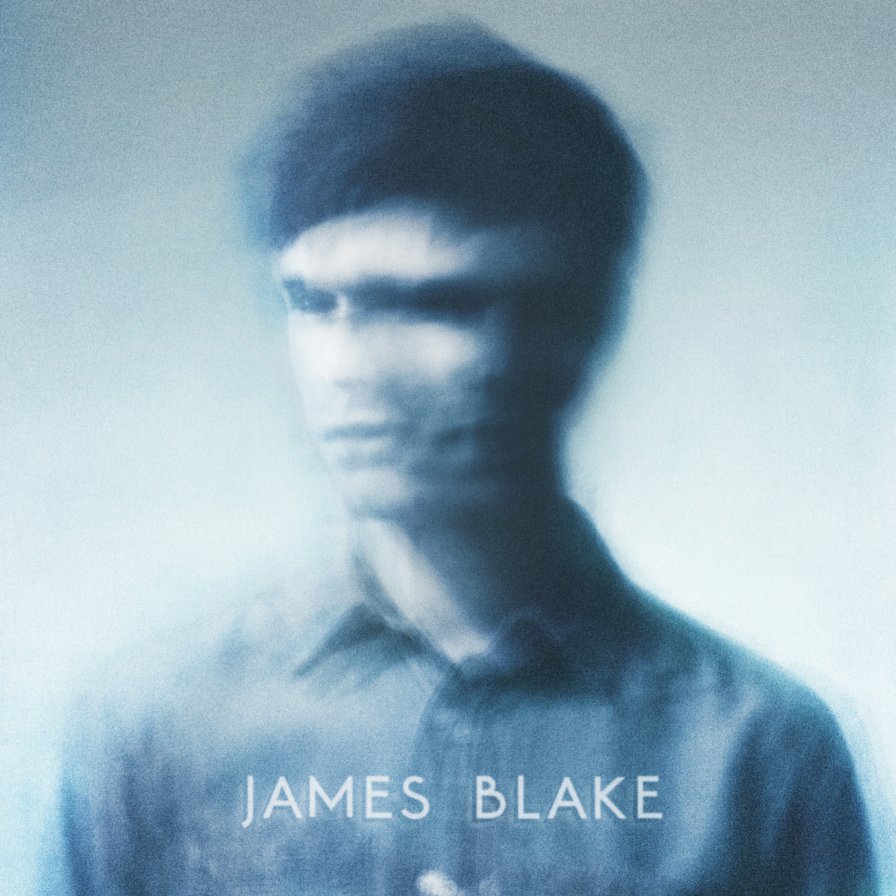
In 2011, James Blake broke from a devotion to the beat by positing new spaces between the biological and the technological, seeing the digital in all its expressive potential. From the hum of a CPU, Blake sourced tenderness. He derived a vulnerable, capable instrument for communicating depression and trauma from the textured cracking of a quantized, pitch-corrected voice, always barely breaking surface. He brought sweetness with rhythms that escaped the average body, and he brought the warmth of an embrace with harmony, melody, and lyric. James Blake sparked a decade of output doused in melancholy and spoken in a new syntax, where experiments in song and sound could take place, where the tinkerer could produce. This was music that established its own listening context and did so with total clarity of vision and voice. Production experiments became tangible because of the cathartic and affective responses they exposed: the jolting polyrhythms of “Unluck,” the displaced and booming bass in the midst of “Limit to Your Love,” the unsteady pulse of “Lindsfarne II,” the fissuring sidechained synth at the peak of “The Wilhelm Scream,” and the repose found within “Give Me My Mouth,” all of these emotionally mapped, inscribed through sound. His music of the past decade presented us with new soundscapes for brokenness, a troubled machine with a sleek veneer, a soundtrack to the iridescent violet malaise that characterizes plugged-in life even a decade later.
32
Danny Brown
XXX
[Fools’ Gold; 2011]

In a review of Old, Danny Brown’s 2013 follow-up to 2011 breakthrough XXX, we called the earlier release “a record that alternated between manic, mind-numbingly hyped-up, incredibly graphic tales of sexual debauchery and drug use, and reflections on the effects of crime, poverty, and drug abuse on the individual, the family, and society at large.” If that juxtaposition shocked some during the first half of the decade, it might be regarded as old hat today, thanks surely in part to the enduring influence of XXX and Brown himself. In hindsight, we might see XXX as Danny Brown’s Rubber Soul: the dividing line between the Midwest-rooted alternative hip-hop stylings of an equally seminal record like The Hybrid and the stylistically unbound indulgence of a more critically acclaimed record like Atrocity Exhibition. XXX was where the influence of peers like Quelle Chris met the influence of outsiders like Paul White, the contrast informing an entire generation of genre crossover since. On that note, XXX also likely holds a special place in the hearts of many who turned 30 this decade, as the album’s intro and outro both provided anthems to celebrate the occasion. And while not every track has aged as well, the overall impact remains ever present.
31
Rihanna
ANTI
[Roc Nation; 2016]

The wordplay is just too enticing: ANTI-capitalist, ANTI-authority, ANTI-thetical. Somehow, Rihanna’s eighth record played us all when it came to each of those things. It was a pop album that poptimist critics couldn’t rationalize. Despite their titular accomplishment, they still seemed out of touch with the realities of streaming-era pop. ANTI was both savvy business move and complete commercial dodge, a too-long and not-long-enough author statement that tasted like the last drag of your last-ever cigarette while sounding like the lighter click before the first time you ever started. Before the everywhere cultural moment of the Black cowboy, Rihanna was a lone desperado, a Marlboro Man staring down the empty plain toward a town of undeserving sinners, uttering a single command: “Work.” Emerging from a world of information overflow and the Babel of internet-pop-politics, ANTI was solitary, inarguable, and unfuckwithable. In other words, yes, ANTI was thetical. You can go right on ahead and reach for that pistol if you want. By the time you’ve grabbed it, you’ll already have a hole where your heart should be.
30
Destroyer
Kaputt
[Merge; 2011]

Dan Bejar broke his longest drought between records and kicked off the decade with Kaputt, managing to prove that he was still capable of surprising us. Although initially confounding, the album eventually made perfect sense as unmistakably “Destroyer,” not unlike 2004’s Your Blues. Setting the tone for the rest of his 2010s output, Kaputt took the elements of a Destroyer record and shot them through a prism of neon, velour, and barbiturates. Since its release, Bejar’s voice has rarely exceeded a mumble; the previously garish colors have been stripped from his album covers; and his particular brand of rock arrangements began to lean less on guitars and more on woodwinds. Perhaps no album in his career has so thoroughly set a tone for so much of what was to come. Though his music largely exists out of any specific time or place, Kaputt, oozing as it is with a kind of hazy languor beneath a glossy sheen, does seem to make sense as an intro to this decade, a disorienting mix of maximal stimulation and minimal engagement — “ambient disco,” as Bejar put it, or: it’s got a good beat, and you can lie on a couch to it.
29
Elysia Crampton
Elysia Crampton
[Break World; 2018]
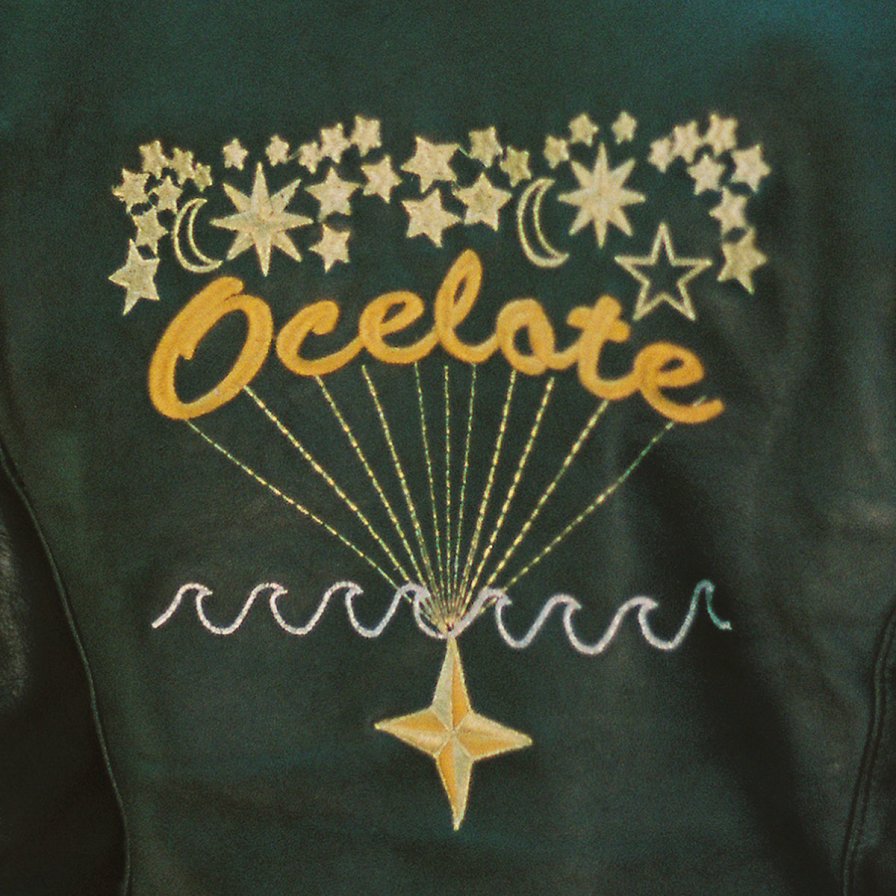
Over the course of the decade, the sound and influence of Latin American music grew to dominate the charts, even going so far as to influence how chart position is calculated to take into account YouTube, where the youth, and artists like Bad Bunny, dominate. Through this narrative of style and influence is a conversation about ownership — the term “latin” seems insufficient, given the diversity and breadth of talent competing for self-definition. Elysia Crampton’s music is insistent in its reference to the Aymaran people of Bolivia and to Crampton’s trans identity. The track “Moscow,” on her self-titled debut, produced after releasing celebrated albums and digital artifacts as E+E, was dedicated to the trans femme mariposa Ofelia, f.k.a. Carlos Espinoza. In addition to the contemporary message, the insistent throb of the songs on EP seemed unconcerned with geometry or the contemporary minimalist ecosystem of flat planes and muted tones. “Orion Song” began with what sounded like a furious alarm clock, and the gradual assemblage of objects and propulsive noise makers gave the song a maximal, euphoric sense of terror. The anarchic clarity of these tones felt both of-the-moment and ahead of it. Terror and euphoria were defining aesthetic modes of the 2010s, observable in the lush panic of popular film studio A24 and the obsessively granular doomer mentality of experimental music. Elysia Crampton’s music in turn weaved a compelling narrative of this decade, one of bodies and identity, revolution and reflection. She thrusted a lance through this war rug of digital noise to reveal sunlight.
28
Kendrick Lamar
To Pimp a Butterfly
[Top Dawg; 2015]

The gall Kendrick Lamar had to doctor a Tupac soundbite by inserting himself in it, to place himself in conversation with the West Coast hip-hop avatar and discuss the importance of autonomy and perseverance as two men embroiled in a system rigged against them. Lamar chose to end To Pimp a Butterfly with this interaction as a meditation on longevity and the dangers of artistic corruption. The entire “interview” would come off as a gauche stunt if Butterfly hadn’t spent its previous 15 tracks solidifying Lamar’s status as the preeminent mouthpiece of hip-hop today.
Twenty-seven years old when the album was released, Lamar’s greatest fear at the time seemed to be his 30s. This is the decade of resignation, of financial and creative ruin, according to Butterfly. So here we have K-Dot’s masterpiece, a record so clearly created with the intention of establishing the Compton rapper’s genius before he hit that age of no return. Its politics were prominent and thoughtful, yet never overbearing or preachy. Its grooves were impeccable, beaming soul, jazz, and funk through a prism of nostalgia that Lamar was too young to have ever experienced firsthand. The second half of the 2010s saw hip-hop becoming less verbal, stylized as ever but more iterative. In light of To Pimp’s bravura, its self-aware lunge toward greatness, it’s easy to see why the genre retreated backwards in reaction.
27
Kanye West
My Beautiful Dark Twisted Fantasy
[Def Jam; 2010]

Embracing your inner asshole shouldn’t lend itself so well to pathos. But on My Beautiful Dark Twisted Fantasy, Kanye’s first opus of the 2010s, all the falsely penitent confessions about dick pics, all the fantasies of porn star matrimony, all the embittered infidelity made Yeezy seem human again. The coldness of Kanye’s synthpop dirge 808s & Heartbreak dissipated upon Ye’s inaugural line in “Dark Fantasy”: “I fantasized ‘bout this back in Chicago.” West was back, emboldened as ever and characteristically prodigal.
Fantasy should have bloated over with star power, as it commissioned both heavyweights and up-and-comers alike from the hip-hop, indie, and R&B universes. It should have choked on its own ambition, vacillating between self-important baroque orchestration and irreverent auto-tune austerity. And yet it succeeds, a monument of gluttony and poise. As Barack Obama attested, Kanye’s a jackass, which we all knew to be true already. Why not let the jackasses have their moment of glory, though? If anyone’s earned it, it’s Kanye.
26
Dean Blunt
The Redeemer
[Hippos in Tanks; 2013]

The teachings of the Catholic church oppose a set of cardinal sins and virtues. Lust and Chastity, Wrath and Patience, Envy and Gratitude. These tuples represent archetypal conducts and dispositions, behaviors to avoid and pursue. Atonement is the bridge between redemption and sin. One can identify many such sins in Dean Blunt’s The Narcissist II: “XXX,” “And I’ll show u heaven if u let me,” “I just need a bitch to lay…” Were there traces of reparation and penance in The Redeemer? Were those two albums a diptych more than entries in a tetralogy? Did a transparent attempt at psychomachia get mistaken for the heartbroken balladry of a rascal whose latest punt was to wear his heart on his sleeve?
Starting with the praying hands that adorned the cover, the signs were all there. “The Walls of Jericho,” “Seven Seals of Affirmation,” the Meridian Demon, “God forsake us now”… The clarity in the forms, a rupture with the lo-fi fuzziness of Hype Williams, also signified the opposition. Yet, not even the centrality of the longing for a lost love was new. Behold Dante traversing the circles of Hell to meet with Beatrice. Songs like “Need to let u go” or “Papi” seemed to frame a lover who understood he fucked up, as he praised what was inevitably lost. So much is clear. Tellingly, acoustic guitars and warm synths wrap the appearance of the female voice in the album. Blunt invited two female collaborators: one from the past to sing about the need to wake up and let go, as if calling from the netherworld; the other, present in Blunt’s successive work, who appeared rooted in immediacy, to talk about minutes and a very material home. Indeed, from the get-go, The Redeemer was billed as a “relationship study.” Was that the perverse rug-pulling? An allegory so blunt and evident by design? Maybe. Such is the paradox of an album that invites tropological interpretation while grinning from behind a fogged crystal.
25
Laurel Halo
Quarantine
[Hyperdub; 2012]

It’s difficult to choose which Laurel Halo release from the decade is her strongest work, from 2013’s deconstructed house EP Behind The Green Door to 2018’s dancefloor-ready DJ-Kicks installment to 2015’s ambient masterpiece In Situ. But it was 2012’s Quarantine, her debut album on Hyperdub, that was etched into music history for its provocative reinterpretation of what it meant to make a vocal album and, dare we say it, pop (gasp!) album this decade. Laurel Halo used her simultaneously processed and raw vocals to create a new kind of intimacy for the listener, sung as if you were the only receiver of these messages. The melodies were both infectious like a pop song and entirely unexpected, as though Halo were simply meandering through various thoughts, feeling her way through the music. Combined with ambience, obsessive repetitions, synths diffused through cheesecloths, 70s sci-fi atmospheres, and even more layers of voice, Halo created a subterranean cave filled with nothing short of an infinite sonic universe. We come back to its title, Quarantine, and it makes total sense.
24
Lolina
The Smoke
[Self-Released; 2018]

When I reviewed The Smoke, I tried to understand it in geographic terms. I heard in it the way that Inga Copeland’s Lolina gets in and around the city, tossing evidence into the river as she escapes from one place to another, running and exercising her “right to be forgotten.” My critical conceit was in assuming that, for all of her attempts to get lost, Lolina is a character who can be found. I understand now that the reason Lolina tosses her Oyster card into the Thames is because her escape is not a spatial one, but a spectral one. Lolina is a projection of Copeland; a “fake;” a ghost; an empty, vaporous presence. In retrospect, I should never have reviewed The Smoke. It is, as Lolina points out, an error typical of the critic, in their hubris, to “try to judge a girl by how she fakes.”
23
Future
DS2
[Epic; 2015]

Who else could sound as at home crooning alongside Taylor Swift and Ed Sheeran as they do weaving ballistic balladry on “Stick Talk”? Who else could conflate their lavish spending habits with ruminations on their deceased grandfather in such earnest?
Future Hendrix’s near-ubiquity in the 2010s is a testament to his effortlessly consistent output and his insular yet expansive universe. Establishing a hazy and highly melodic framework for nearly every trap-rapper to postdate his rise, he’s made a career out of straddling each end of his own dichotomy. Future is a crooner and a lyricist; an impassioned lover and a world-weary fighter; pop star and a monster — an artist whose confessional, often contradictory songcraft unfurls like a frantically-composed tweet thread.
Although any of Future’s mixtapes could have earned a spot on this list, DS2 stood out as our most lucid look into Future’s world to date. Produced almost exclusively by Metro Boomin and Southside, the tape was built on a brutalist foundation of bass, its thundering 808s and sirens boring deep into horror flick-inspired soundscapes. It was between elegant pads and industrial percussion that Future truly shined, his bars an uninterrupted torrent of moans, snarls, and introspective whispers.
In a decade defined by social media charades and songs designed to be TikTok dances or punchlines, DS2 best demonstrated Future’s painstaking attention to the details of his albums. A lesser artist could’ve built an image on his quotable (and strangely lovable) toxicity and strained “slob on me knobs.” In the case of Future’s oeuvre, though, the internet’s a mere distraction — nothing more than a vehicle for new tapes to drop. Bump “Where Ya At,” “Slave Master,” or “Kno the Meaning” and you’ll bear witness to the real spectacle: a filterless artist bent on exorcising all his demons in excruciating detail. Like its alchemical cover art, DS2 was amorphous, but always alluring — a lava lamp filled with cathartic spillage.
22
Mount Eerie
A Crow Looked At Me
[P.W. Elverum & Sun; 2017]

Death
When my father died, my mother was essentially destroyed by it, in many ways consumed by it. There wasn’t a day for months she wasn’t crying. Even when the tears dried, there was something shattered about her. It’s been almost 15 years since, and the fighter I knew growing up is gone, my father’s death replacing her with someone overwhelmed, remorseful, and anguished. I barely recognize her now. She maintains airs of independence, but deep down something was irreplaceably lost that September morning.
Is
What am I to know about death? My father passed away when we were only beginning to mend fences. Family members who have died seemed all too distant. My friends and family, what few I have, they’re still alive, only one facing the specter of death (though I’m not sure it’s real). All I know is that, like love, people change with death. Maybe I too have changed. But I don’t know. I can’t know. Nobody is willing to say so. In place of answers… a sad disquiet.
Real
I’m sorry for what you’re dealing with. I know, I know, it’s not final. But…it’s inevitable, isn’t it? Fuck, I can’t imagine even the slightest what pain and anguish you’re facing now. Knowing that chasm awaits you. But then, I’m not sure I’ll ever know. All I can say is I’m sorry, even if it’s so damn meaningless. Because I feel your hurt, even if I cannot so much as utter a coherent word of it. And I will feel it when that day comes. I can’t help it, you know.
21
Lil B
White Flame
[Self-Released; 2012]

A hundred feet of conduit banded up with deeply colored red tape, tossed in the back of a short-bed truck to be delivered at 8 AM. Gotta get electricity. I mean, Lil B helped create ALL of this. Shit: bruh. He’s reeeeal itchy. Ad libs got tossed off like grass clippings. Always promoting new projects, all of it rare too LOL. So much was covered on White Flame! It’s such a trip! Complicated, beautiful, contradictory, dull, transcendental, hilarious, DOPE, forgettable, soulful, sad, etc. Also, quick shoutout to all of the crazy shit he says, just in general. Oh, and another quick shoutout to the multiple musical styles/genres White Flame covered. He was all over the place on this one. The beats were so far off in the background that it at times felt like BASEDGOD was rapping over-top of his phone. I love him. #TYBG
20
Scott Walker
Bish Bosch
[4AD; 2012]

Although Scott Walker was reclusive and disinclined to give interviews, those that are available to us showed a genial, good-humored human. Nonetheless, Bish Bosch, 2006’s The Drift, and 1995’s Tilt have cast a remarkable pal over their respective decades. They stood apart from other significant works of their time both by design and by their innate refusal to wed their eloquence to mere elucidation. These albums reported on alienation so profound, so far flung they felt like urgent, immaculate, yet hopelessly tangled transmissions from purgatory. One can repeatedly look up the words “macaronic,” “mahout,” and “mascon” and still find no illumination. Every line a shining, austere forgone conclusion, all the more dazzling for its elusiveness. He may’ve been light and jocular with Jarvis Cocker, but the work showed a stridency and obsessiveness that screamed to the listener. Not for help, but just to have someone to scream to. Like the bizarrely hilarious, churning “Epizootics!,” abject isolation has a terrible momentum to it. It’s perhaps safe to say that if Walker didn’t find a place for this momentum, he’d have been lost to us like Syd Barrett after that first dandied blush.
But we didn’t know the man 2019 took from us. One can recognize the liability of seeing and interpreting without interacting. The acute sensory realm of this trilogy notwithstanding, the music could take on this draggy sort of weight. And yet you gotta hate it when people say “it’s called depression” in a dismissive way. Besides it being simply reductive, it slams shut the doors of lateral moves (a.k.a. creativity), which save us from fully succumbing to despair. These albums represent the pinnacle of this creativity at its most relentless. And the remnants of the crooner’s former teen idol self became hardest to grasp on Bish Bosch. The soul, or pained lamenting, of that previous life gradually gave way to glib, sneering pronouncements over a cluttered dissection table. In both phases, there seemed a tactical emotional detachment, but this was only a means for Walker to better get to something more genuine.
Just as the 1960s and 70s showed Scott Walker to be a willing, ambitious pop interlocutor, these albums showed us a sizable void of endless relief on the other side of fame’s dogged obligations. While not strictly fear-exploiting, these albums were only pop in the sense that a horror film is. And Scott coolly escorted us through these nauseating, dispiriting, and alarming scenes, nowhere more Crypt Keeper-esque than on this album (unless one counts the 2014 Sunn O))) collaboration Soused, which can’t help but feel a bit like an addendum). There was a dry giddiness that both buoyed and ballasted the audience’s sinking feelings. It may’ve elicited some uncomfortable laughter, but a choking vast crush of space soon followed. And it wasn’t hard to see those pitted glaring eyes of his in those moments. You knew that he was a vessel in those moments, that “elegant” is transitory while “explicit” is definitive. The rubberneck field notes were laid out, and authorial distance didn’t soften them (even on the gorgeous, desiccated closing ballad, “Conducator”). The crude, evergreen armchair dismissal of what gets called “provocative” as “rubbing one’s nose in shit” seemed a relative phenomenon to Bish Bosch. Having provoked this sort of defensive counter-provocation among disillusioned fans of his early work, Walker only seemed to restrict his Id less, wringing purple spits of off-puttingly tactile verbiage into his drone and clatter.
Scott Walker prized the text first and foremost, and the urgency of having words matter puts him (plus the seriousness of much of the subjects he writes about) much in line with equally vital neo-conceptual artist Jenny Holzer. In times of shrinking attention spans, abstracted, pithy language became less an obfuscation than a lunge away from glazed, transactional impatience (since we all have glowing rectangles behind our eyelids, Holzer often infuses her text pieces with LED lights). Walker obviously adored language, and his exuberant fetishization of it was contagious. Reclusive though he might have been, he managed to be quite the boon to other brave souls who endeavored to meet him half way and listen. These last four albums may serve as poetic testaments to the elaborate wretchedness of humankind, but it was delivered in a way that felt more hale and hearty than usual for this sort of thing. A more comprehensive consciousness of the physical and temporal world around one may have a mighty sag to it, but Walker heaved a glad shoulder and found a mesmerizing gait. Bish Bosch fleshed out our latent existential woes, but once through, he flushed them out as well. Both a purgative and arresting (his voice remained elocution personified) experience, this album was nonetheless probably the least replayed favorite of many (this writer included). But as in previous decades, Walker had a way of cutting through the drowsy haze of moodiness or casual preference and right to a never-convenient, always-essential absolute.
19
Oneohtrix Point Never
Replica
[Mexican Summer/Software; 2011]

Change is the inevitable failure to repeat the past. We are so bad at repeating the past, at replicating the same thing again and again, so as to create a reassuringly familiar simulation of our past lives and selves. We always fail, we always make mistakes, but in the process we create the future.
This is the temporal drama Oneohtrix Point Never played out in 2011 on Replica. The producer’s fifth album, its most distinctive feature was an almost anal repetition of the same set of micro-samples, drawn largely from television commercials of the 1980s and 90s. Most of its 10 tracks stuttered, skipped, or stammered with the sounds of fragmented keys, incidental noise, beats, and vocals. Virtually all of its samples were rendered unrecognizable and uncanny by their truncated lengths. But more importantly, while each replicated mini-phrase was usually identical with its predecessor in purely sonic terms, each repetition created a new context, thereby altering each sample’s resonance and meaning, separating it incrementally from itself.
This process of separation was enhanced by Daniel Lopatin’s increasingly mature and sophisticated production. Washed-out, floating synthesizers were superimposed and wafted over the juddering samples, inflecting them with a profound sense of mourning and loss, highlighting their failure to retain the same significance, illuminating their passage from the same to the different. Lopatin talked in interviews about the idea of the replica as a way of coping with the decline of human knowledge, but the music on Replica spoke to much more. It was the sound of culture changing in the failure to reproduce itself, of society changing, of individual identities changing, of DNA changing.
Replica, then, was an album about the impossibility of replicas. Yet this impossibility was a necessary precondition for the evolution of life and for history, which is why the album was and still is as beautiful as it is fatalistic. Tracks like “Andro” and “Submersible” drifted nebulously, pregnant with creation and an irrepressible suspicion of possibility, each additional sample or chord always invoking something much bigger than itself. Other tracks, such as “Power of Persuasion” and “Nassau,” accumulated poignancy and weight with each stubborn loop, unfolding new sensations despite the ostensible duplication of source material. And, at all times, the mortal failure to reproduce an identical copy of what came before could just as easily be heard as a victory, as a liberation from codes, conventions, and precedents.
Yet despite its conceptual depth, Replica was as much a stylistic and aesthetic triumph for Daniel Lopatin as anything else. Pushing him away from the synth-heavy coldness of Returnal and previous albums, it took the chopped & screwed blueprint laid down by his 2010 Chuck Person’s Eccojams Vol. 1 mixtape and transformed it into a deeply coherent and unified artistic statement. It may have been arguably non-musical in its obsessive repetition of sub-second samples, but it created in the process an incredibly unique way of finding significance in sound, as well as significance in our all-too human inability to preserve the past inviolate.
18
Young Thug
Barter 6
[300; 2015]
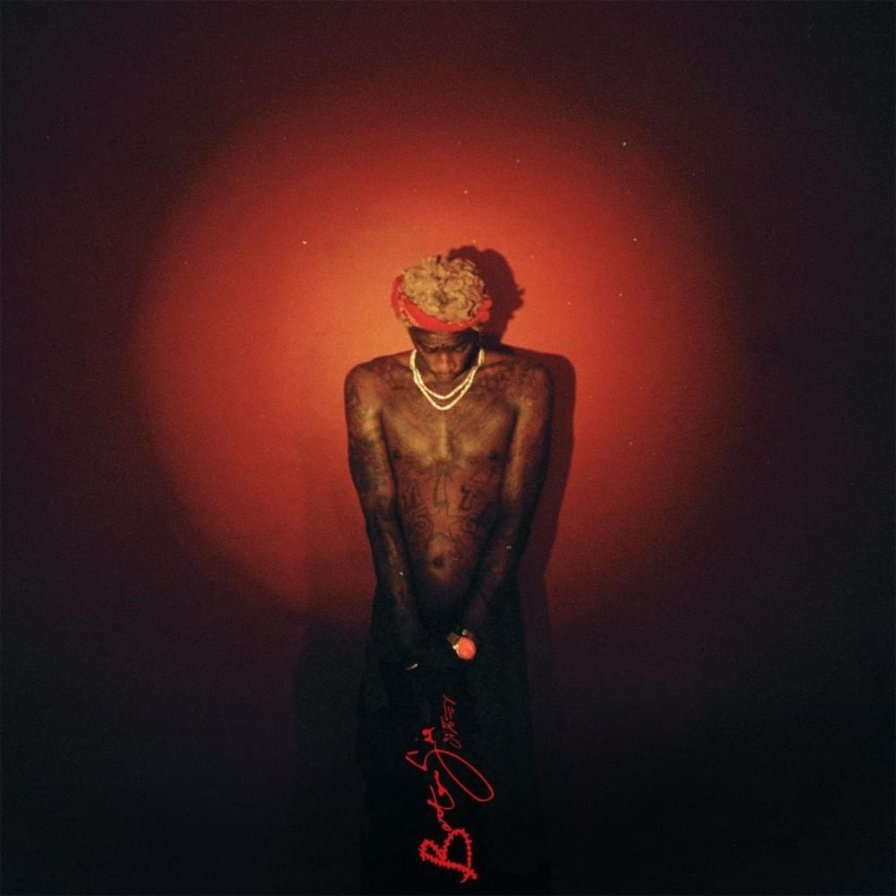
What remains to be said about Young Thug? Sonically, his style has become something like a joke that loses its magic through over-explanation (I imagine Lyor Cohen can type the phrase “voice as an instrument” through predictive text alone); in terms of cultural impact, capturing the Young Thug phenomenon through the lens of a single release may well be futile (akin to flattening a decade in music into a list of albums). This much is clear, though: with each Elton John collaboration or appearance on the set of Uncut Gems, we now celebrate not the actual result thereof, but the absurd, inexorable march of the man behind “Extacy Pill” toward the cultural stature he has long deserved.
The cost, of course, has been paid by the art itself. Hundreds of leaks and a farmers’ almanac worth of Slime Seasons later, the Barter-era Young Thug exists primarily as an echo. His Billboard ubiquity, overdue even if over-corrective, rides on the Burberry coattails of his signees and direct stylistic descendants. His albums, now unambiguously official and uncharacteristically true to their release dates, serve primarily to underline the finer points of their predecessors in the catalog rather than attempting to build upon them.
And yet, there exists one perfectly-preserved document of the era. At first glance, it could be easily misread as a capitulation; features from Boosie and Young Dolph and the endlessly-handwringable dust-up with Lil Wayne were, if not wholly out of place, certainly intentional steps outside of Thug’s Atlanta creative haven. The mere presence of someone in his ear fretting about the distinction between an album and the newly-invented “commercial mixtape” concept did not bode well.
It didn’t matter. Thug’s most vital output has rarely featured (or required) clear, intentional sequencing, yet “Constantly Hating” and “Just Might Be” simply could not exist except at this album’s opening and close. They enclose some 50 minutes of direct exposure to the mind of Jeffery Lamar Williams, a considered exhibition of the entire spectrum of rap performance that can just as easily scan as a stream of consciousness. Four years on, if not from the very moment of release, Barter 6 is a clear coronation: an inflection point between deifying and defining a genre, a record so true to Young Thug’s trademark mercuriality that it’s a wonder it was ever released.
17
Carly Rae Jepsen
E•MO•TION
[Interscope; 2015]

Joy in a bottle: bubbly, sweet, even-keeled, refreshing, perpetually new. I’ve always associated Carly Rae Jepsen with Bruce Springsteen. It’s a tenuous and perhaps confounding association, but the two are nonetheless bound in my mind. It’s in the endless anthems, the blind faith in the hook, the bubblegum uplift, the hardworking hero, the balladeer draped in honest fabric, completely sincere. Most importantly, they both provide an idol to pour oneself into. Carly Rae Jepsen: an adorkable hopeless romantic forever empowered, lost, and doing the most. She’s marked by a public-facing air of humility and stays in her lane with grace. With E•MO•TION, she gave us something to lean on.
E•MO•TION and its consequent reception signify the triumph of poptimism over the past two decades, but, further, it contributed to the divorce of pop aesthetics from strictly mainstream spheres. E•MO•TION was the moment that CRJ stepped down from the super-stardom of “Call Me Maybe” and into a minor-major mid-tier cult-pop status that characterizes the diversified and democratized idol landscape we have today. She helped carve a space for a new format of pop idol, the influencer-artist, a space where musicians can find greater creative freedom via fervent fan support and a creative license to call more shots. Much of the most exciting pop music today is being made in this newly carved space, where artists can take creative risks while performing something like an authentic self just an arm’s reach away from the stans.
Beyond this, E•MO•TION’s acceptance demonstrated a shift in pop criticism, one that moved beyond the condescending, protective defense that poptimism had accumulated. Because its production was lush and organic, because its songwriting was sincere and full of intent, and because its hooks were irresistible, E•MO•TION made it clear that it required no protection. Anthemic without naiveté and strong even when its singer was at her most vulnerable.
This was not pop re-purposed as a tool for critique of Western modes of consumption and production. Nor were arms twisted into taking it seriously tautologically, because it had already proven popular and hence influential. This was pop as a viable music in and of itself. It’s the simple euphoria. It’s in the feeling that arises with the perfect scansion that causes the line “I think I broke up with my boyfriend today/ But I don’t really care” to burst forth in climax. It’s the harmony between her proclivity to constantly ask if she’s “too much” (“Because I want what I want, do you think that I want too much?,” “Oh, did I say too much? I’m so in my head, think I’m out of touch,” or simply, recently, “Is this too much?”) and the fact that she dressed the question in an epicurean, sugary, and burning sonic architecture. Most importantly, Jepsen wasn’t grinning for a moment. She smiled with depth, warmth, vulnerability, and tenderness, but it was never a grin.
“Call Me Maybe” was infectious and viral. It shouted its way through grocery stores aisles jolting shelved goods and brattishly dodging consumers, running amok with love. E•MO•TION’s songs were reeled in, containing the passion but diffusing it, sweetly. They held a listener, talked with them, and left them waiting, wanting more. God bless this timeless crush.
16
The Caretaker
An empty bliss beyond this World
[History Always Favours the Winners; 2011]
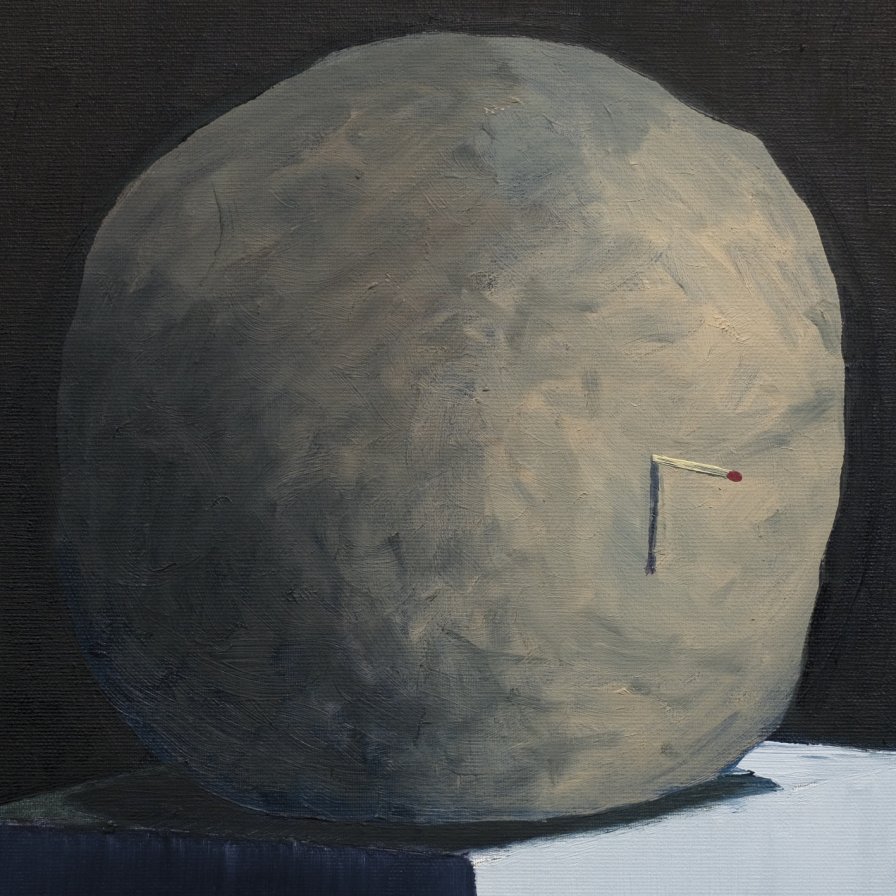
Experience, the Tantrics tell us, is fundamentally empty of a coherent self and, at the same time, inherently blissful. It’s in the union that the trick lies — a trick that is an untrick, a seeing of a truth that was always right in front of us but to which we weren’t paying careful attention.
The partially illusory self is a vital concern of The Caretaker’s — zeitgeisty, time-ghosty (or is it the spirit of time itself?) in an age of self-care commodified and endlessly reproduced. The nominal impetus for An empty bliss beyond this World was the experience of Alzheimer’s disease — the mind slowly losing its hold on memory, on those contents that are often seen to constitute selfhood, a tragedy in which all “things” must literally pass.
But among this empty landscape of loss, specificity is not entirely destroyed. Tantrics understand this too, seeing the play of experience as the dance of the God/dess, which both manifests in the particular and is constituted of an underlying non-duality. In an exquisite tension, both perspectives are simultaneously and entirely true. Consciousness-objects persist, karmic or neuropsychological, traces of former actions and reactivities that remain to be set in motion when the appropriate trigger brings them to fruition.
Exquisite and loopy, then — like experience itself. In our dotage, we circle, our emotions are released by reproductions of the art of our prime.
And in the age of mechanical reproduction, there is a nostalgia that can be evoked by the recording as recording, a patina’d sense of “the past” as an idea, not an era. To wit, the crackling, wavering pre-war 78 loops that formed the foundations of Leyland Kirby’s decaying edifice, a hotel full of ghosts. Not so decaying, though, because where pieces like The Disintegration Loops or Kirby’s Everywhere at the end of time series were literally in deconstruction, here the music hovered like gossamer, like ectoplasm produced from the womb of the medium, before being abruptly snuffed out of existence. Each loop was infinitely cherishable, specific in (numerous) time(s) but infinitely extendable, both empty of meaning (if meaning is comprehension, if it is generalizable) and pregnant with innumerable significances.
And then, and then — a decade after its release, An empty bliss is now a historical artefact itself, subject to the fate on which it is also commentary. It’s a punishment that fits the crime (can’t cheat karma), evoking an infinite regress of nostalgias.
The angel of history sees catastrophe — the angel of memory, bliss. The function of the angel is to act as the Singing Detective, but when the time between the stimulus and the consciousness of the stimulus extends to encompass all of infinity — as any moment of time does — how can we ever ascertain whodunnit?
15
Grouper
Ruins
[Kranky; 2014]

After years of wading through the mire of dystopian visions, uncertain futures, and supposedly imminent ends, Ruins was what it felt like to look back. It was a loose morsel of time captured through memory’s haze, eroded through absence and polished through rumination. It had a tangible presence, an organic universe built into its corporeal sounds, but in its soul, it was still a soft mystery. It was isolated and hermetic, honest about our era’s spirit of solitude and solemnity without being broken down, a passage between 21st-century dreams and the waking world beyond. It was, in a sense, just Liz Harris, her piano, and their frail partnership, but in every crack of silence and every sustained chord were sylvan echoes of a neverending tempest roiling outside. She envisioned herself, quiet and remote, cloistered against an apocalyptic storm, reflecting on lived histories and traditions through tender piano serenades. Before we were lifted into the architecture of a new age, Grouper transported us down to the ruins below. Someday we might return.
But what did we find percolating out of the rain-sodden soil? Faded lullabies about remembering what it is to laugh and love and fall apart as we turned numb in the gale. Spectral sense memories of lovelorn anguish (“Call Across Rooms”) and loneliness (“Clearing”), as well as — through some magic — remnants of a corroded hope (“Lighthouse”). Ruins had an arc of transformation, from material (“Made of Metal”) to ethereal (“Made of Air”), present to past, which was expressed in a sonic chart of ephemeral details — a croak, a creak, a rumble of thunder, a beep — that evaporated into glistening, imperfect reverberations of liberated sensations. Breaths became emotions, as in the lilting, whispered harmonies of “Holding” and the repetitive angst of “Labyrinth,” and then returned to vapor. We’re still turning circles.
Ruins survived beyond those tremors, though. Preempting the skeletal static of Grid of Points and the celestial miasma of After its own death / Walking in a spiral towards the house (as Nivhek), and unfurling from the full resonant body of The Man Who Died in His Boat, Ruins was Harris distilled but complete, balanced in meditation under solitary candlelight. It’s that minuscule aura of warmth and that light of guidance that will comfort us in the moors ahead. When nowhere felt quite like home, Ruins was a familiar enough wilderness.
14
Arca
&&&&&
[Hippos in Tanks; 2013]
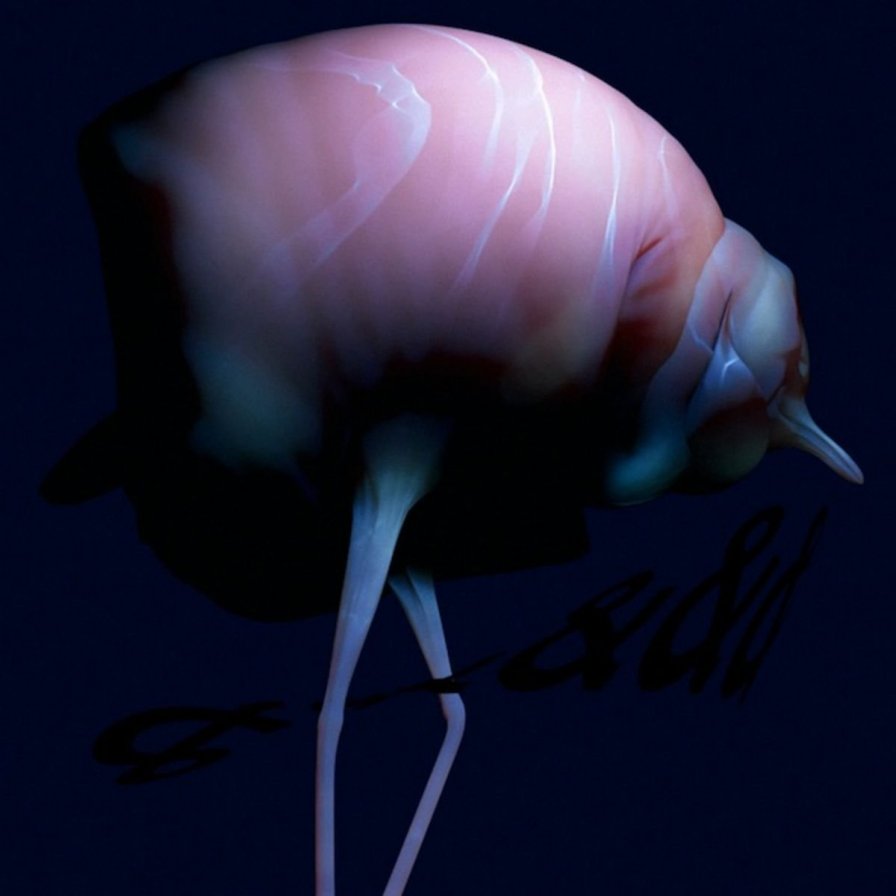
We craved a way to say we’d changed. We sought an art to measure ourselves. We traced each others’ whole silhouettes against butcher’s paper and held the outlines up to light. Where the limbs jutted so, where the brow distended out, the neck, the nape, the ass, these whole sacs of we filled with nothing; how had we shifted? And had it been natural or somehow induced by a foreign agent? And had we meant to change? And how even were we when we’d started this stretch of 10 years, this arbitrary meaning marker? And how were these renditions — these places where pens had swerved, blobbing edges and adding nodules — how were these ruins of self-portrait different from how we actually were? And what if what we made was actually us, what if it were up to us? And and and and and!
She whispered, she shushed. It sounded like clicks and peals, but we recognized its meaning; any apprehension gave way as we distended, unknotted, reclined into an embrace. The first time you feel at peace for want of a lover’s limbs. The inching desire to be covered up by another, to uncover in the heat and glow and melt into, through, under? To recombine in grime, to find the holy and profane in clicks and peals — this was the gnashing brightness of &&&&&. This was where we first started to unrecognize.
We were cognizant of Arca before &&&&&. Her production stretched into monstrous dwellings, sutured the devout and hateful corridors of Yeezus, milked raw a well of want on FKA twigs’s EP2, would later marry into Björk’s elegy out of bondage. But &&&&& was sheer incandescence bellowing out and between the teeth of the future’s nerviest composer, a place where dub and hip-hop and piano concerto lost shape against each other. It was the shape of a new being shaking; we were shaped into newness by it, and it demanded nothing less than total transmutation.
Transmutation, as differentiated from the sometimes imperceptibly horizontal gene moves of transformation, is a complete change in appearance, structure, and metabolism. In &&&&&, lost sounds (whipping, a moan, guttural animal) were not recognized but re-rendered against a flanged history of musics. It was the evolutionary entry into a decade-long transmutation, shocking a swallowing whirl of flange deep in the belly (Xen) through the enmeshing of digital bodies into new being (Mutant), past the absorption and purgation of hate-bred traumas (Entrañas) into a pure peeling evolution of voice beyond the human (Arca). More than any other experimental maker this decade, Arca’s sounds were designed to be experienced as they were sounded (alongside each other unbroken — an arts of mixtapes!) and as paeans to an evermutatation. Change catalyzed in the moment of encounter. Reflection taken after occurrence was already watered down. As tempting as it was to trace and track and wonder through our history, we were prompted — those clicks and peals! — to be in and then move through. Her voice, unrecognizing, a fluent fluid full of swerve and love. And and and and and!
13
E+E
THE LIGHT THAT YOU GAVE ME TO SEE YOU
[Self-Released; 2013]
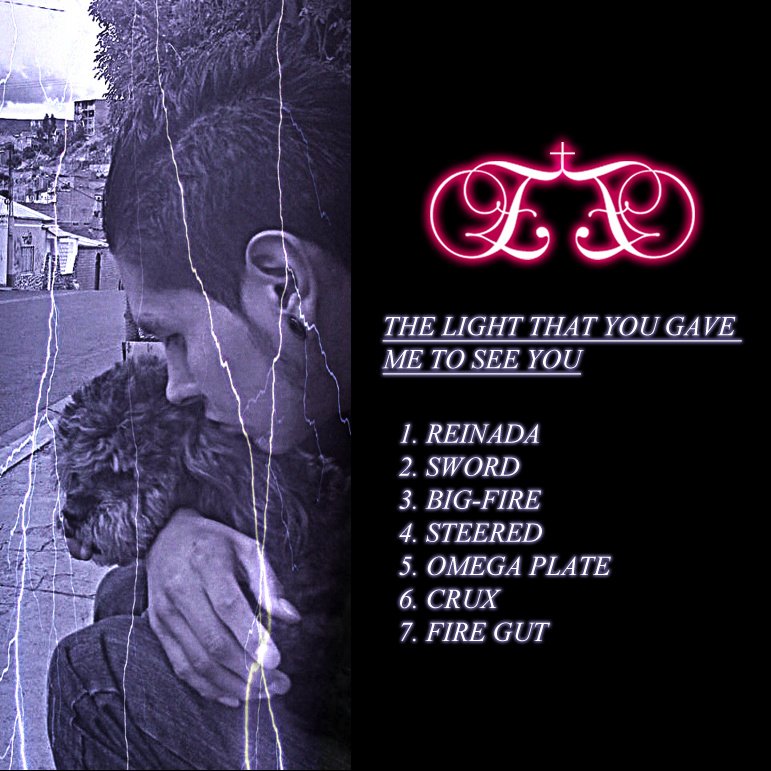
Interpretation is an attempt to bring one’s preconceptions into play so that the meaning of a work can be made to speak for us. Our historically-effected consciousness defines a horizon, a culture, and a tradition that inform how we understand a text, art. I can’t separate my experience as a migrant and my Bolivian origin, two features I share with E+E, from my interpretation of THE LIGHT THAT YOU GAVE ME TO SEE YOU. Instead of chaos, worldbuilding cut-ups, or a sound collage for the digital era, in her music I hear the buses and pedestrians running around the streets of La Paz, I hear the markets in the border between big cities and indigenous areas, I hear Quechua youths dancing in abandoned warehouses. The way E+E picks and connects ideas, references and temporalities, sometimes with violence other times with great tenderness, is a method of knowing common to many migrants. We make sense of daily life by appropriating, preserving, remembering and discarding from the streams that lead our journeys. Thus, Lil Jon and huayño are no more contradictory than any other of the strands that compose our identities, at once ancient and futuristic, autochthonous and cosmopolite, deterministic and polysemic.
The heterotopia emerged from such process would sound, one imagines, similar to “Fire Gut,” “Steered,” “Crux,” or “Reinada,” tracks off THE LIGHT THAT YOU GAVE ME TO SEE YOU. That is, juxtapositions of spaces, times, forms, and styles, where Bonnie Raitt, saya, crunk, and plunderphonics not only coexist but make sense together. The thought experiment of the Martian Museum of Terrestrial Art could be enlightening to consider here. How would an alien archeologist interpret the history of (human) art, to then organize it as an exhibition? Most of the links they would propose are unthinkable to us, for they occur outside a recognizable sense of history. Free from normative frameworks, the alien would come up with essentially original groupings, emanated from a compressed and pure present.
In her work as E+E, Elysia Crampton heightens that strangeness, perhaps because she has been made aware of such character through her experiences. A topological examination of her work could describe her compositions as abstract spaces where information and objects appear, then undergo multiple and instantaneous transformations. If looked properly, that is also a description that applies to lots of other instances of the human experience. Being new to a collective or language, an alien, may bring that facet to the front; hence, putting migrants in an ideal position to examine those tensions. Not that this could be sufficient to explain the work of artists like Chino Amobi, ANGEL-HO, or Lotic, but perhaps it may catalyze the consistencies and similarities between their art and E+E’s. Thus, allow for a positivist reading, as I claim that blood-splattering effects, robot sounds, Afrobolivian drums, and the rejigging of R&B hits might be an emanation powerful enough to conjure the allure of an imperial-capitalist world in its degenerative splendor.
With all this, I tried to argue for the importance and value of THE LIGHT THAT YOU GAVE ME TO SEE YOU as a meaningful artifact of the last decade’s culture. Is it disingenuous to impose a retrospective narrative on music that defines itself in opposition to grand narratives? What can one make of the contradiction between the permanence of recorded music and the ephemeral connections to which E+E aspires? She seems preoccupied by that herself, seeing how hard she has worked to scrub her own tracks. Very little of her art is available online. Even less information on her and her activities. It is just natural for one who has made contingent reconfigurations a way of living. That which is very meaningful to her is simply random for others; a switch in that valence is feasible but not that both could stand on identical grounds. Interpretation can only be a rich melding of artifice and performance on that condition. That will likely make of this list and comment mementos of a ghostly expedition. Perhaps lost to oblivion. Certainly, open to alien reconfigurations and appropriation.
12
James Ferraro
Far Side Virtual
[Hippos in Tanks; 2011]
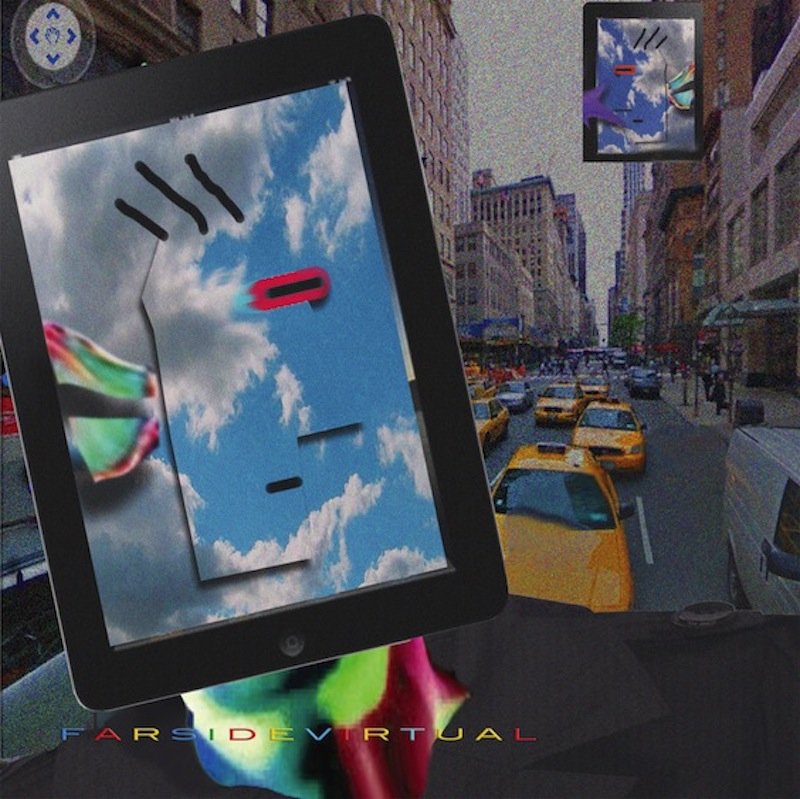
EVERY SINGLE THING this decade was augmented and pushed to the extreme — and we bought it up. From absurd viral pop music to vanilla latte-flavored Pop Tarts, so much of the last 10 years felt captivatingly ridiculous, fake, over-the-top — so plastic. And we were saturated in it, embodying it, vomiting it. Sometimes literally: While the petrochemical industry nourished our landfills and choked our rivers, we were inhaling microplastics and eating plastic debris.
James Ferraro, our Last American Hero, explored this nightmare of excess and its ecological consequences early in the decade with Far Side Virtual. Rather than spewing diatribes about our current condition or signifying discontent through his then typical maelstrom of noisy experimentation and lo-fi hijinks, Ferraro captured the irrationality of consumption by becoming the nightmare itself. Far Side Virtual wasn’t about plastic; it was plastic. So why listen to it?
This disconnect between listening to stylized music “about” what we despise vs. listening to music that became what we despise found expression in various (and vaporous) ways this decade, but it was Far Side Virtual that united accelerationism, hyperreality, and a cheeky approach to High Art Aesthetics™ in such an unusual, confounding way that you could simultaneously embrace its kitschy simulacra and feel repulsed by its visceral fakeness. On the surface — which is where, despite our best efforts, we all tend to reside — its elevator beats, infomercial horns, and corporate chirping played like a “rubbery, plastic symphony” for avatars interacting and transacting in the virtual worlds of Second Life, like a “PIXAR meme” for digital natives raised on the global ambitions of Google and Bitcoin. But these URL-based evocations were met equally with IRL-based implications, sounding in this latter context like a soundtrack to the plastic trash swimming in the Great Pacific Garbage Patch, to the dead bodies emitting “incongrously cheerful” ringtones from their technological appendages.
Far Side Virtual felt like a comedy, but it wasn’t funny. Instead, the album offered a sound so lively it felt lifeless, so synthetic it felt alarmingly real, so nauseatingly jubilant and terrifyingly pristine that its vulgar caricature of societal structures largely overshadowed its complex musical ones. Far Side Virtual was described by Ferraro as “still life” — that is, a frozen depiction of 21st-century society — but perhaps the most depressing part is that this “still life” is also still the life we live. It was horrifying, overwhelming, oppressive. But we consumed it, because that’s what we do best. We consume. And then we consume more. And then we consume more. And then we consume more. And then we consume more. And then we consume more. And then we consume more. And then we consume more. And then we consume more.
But don’t worry. I hear it’s rebellious these days.
11
Babyfather
BBF Hosted by DJ Escrow
[Hyperdub; 2016]

Regardless of how you might feel about the current state of intercultural dialogue and mutual respect in the world, there is no question that we urgently require more unity. We need unity, not just in our neighborhoods, our broader communities, and our districts, not just across our nations or even our continents; we need unity as a species. This is arguably more imperative now than it ever has been in the past; we are connected before we are even born, plugged into a network before we even learn how to walk; we need to be able to navigate it in the same way and with the same level of dexterity of our day-to-day life in the physical world. But at a time when unity has never felt so necessary, it has also never been so fractured and distant.
BBF was the soundtrack to a transition, to a moment in the history of humankind that witnessed a shift in the way that we relate to people around us and away from us, people we have never met and people who we know intimately, people who we care about and people who will never know us by anything other than an internet pseudonym. But these tracks did more than document that transition. They channeled the before and the after, the corrupted relations that exist between postcodes and the potential unity that exists across continents, all on a radio station broadcast in London — a melting pot of vibrant multicultures, community engagement, hate-riddled phobia, and indiscriminate violence. Where is that unity, and what does it look like? Where is the pride that we should all feel, not about being from a place, but about instinctively respecting each other, regardless of who we might be or where we might be from?
BBF was assembled so fervently and so accurately that it captured a fracture across both the entire planet and the entire mind of an individual reflecting on how they fit into it all. The album was painstakingly curated by an artist so desperately in touch with the multidimensional realities around him that it also served as a prediction, at once filled with both a giddying sense of optimism and a desperately bleak amplification of despair.
10
PC Music
PC Music x DISown Radio ft. A. G. Cook, GFOTY, Danny L Harle, Lil Data, Nu New Edition and Kane West
[PC Music/DIS Magazine; 2014]

In 2014, on a front porch in the Blue Ridge Mountains, I read DIS Magazine almost everyday through a pair of Oakley sport sunglasses. Cloud chasing and trick vaping in a faux motor-cross-style shirt with an emblazoned “No Tears” logo (a blatant appropriation of the lifestyle clothing and energy drink brand “No Fear”), I favored a particularly “apocalyptic” electronic music. This music gained ground through DIS’s prime cultural coverage and creative output during the early and mid-2010s. The sinister tremor I feel looking back on the fashion feels like my generation’s “80’s hair moment,” a mixture of nostalgia and wincing self-consciousness that hits like the syrupy tang of butterscotch vape liquid (dripped onto a modded-out lightsaber premium rig). But through the gross, sweet-smelling clouds, genius music emerged.
The cultural convergence of DIS Magazine and PC Music was an inspired cross-Atlantic synthesis. In a crass way, the collaboration felt like the coming together of allied powers, a hilarious exaggeration with all the hubris of the “special relationship” between American and British relations. Suffusing NYC’s downtown scene and fashion week demonology with the futuristic, polyglot globalism of London, the houses of Solomon Chase and A. G. Cook merged at Red Bull Studios’s gallery space in Chelsea, New York in March, 2014. The cultural influence erupted like the 1981 NYC debut of New Order playing to a No Wave-loving East Village audience at the Ukrainian National Home: an inspired urban alliance formed that changed the course of musical history.
PC Music x DISown Radio stands as the definitive statement of the PC Music oeuvre and a masterclass in the collective MIDI sound that was prosthelytized widely across the decade. This was a technological crusade that used the genetic code of pop music in a way that allowed bedroom artists everywhere to proclaim their own reciprocity with the decade’s most high-definition forms of capital. It also helped popularize the mix as a new kind of album, one that audaciously premiered and distributed completely original new music and “exclusive content” with an effortless surplus value that has become increasingly hard to locate at the close of the 2010s.
The mix had savant-level composition, it had brilliant ingenuity, it had swing. Most importantly, it had legendary ambition. Then it’s gonna be PC Music signing a deal with Columbia, then it’s gonna be GFOTY touring with Animal Collective, then it’s gonna be Danny L Harle producing for Carly Rae Jepsen, then it’s gonna be Number 1 Angel, Pop 2, and Charli. A. G. Cook was 23 years old.
09
Frank Ocean
Blonde/Endless
[Boys Don’t Cry; Def Jam; 2016]

I was blonde when I was a boy, but I am not blonde anymore.
Brunette, they say now. Dirty blonde, others begrudge. Which is to say, I know what it’s like to stand on the anonymous tile floor of another man’s bathroom, knowing I am not the man I once thought I was. And I too know what it’s like to find solace in a bottle of cheap dye, to massage a myth back into my scalp. But myths have minds of their own. The bottle calls bullshit. The dye job fucks up, turns your fragile locks rust green. And you know you can’t hide that color. The color of a bluff finally called.
So you cry in the shower. You cry in the shower because boys don’t cry, and at least in here you can admit to yourself that is not what you are. You cry because you’re alone and no one is looking. You shield your eyes because you’re alone and everybody is looking.
Our mothers tell us, “Be yourself and know that that’s good enough.” The artist f.k.a. Prince Rogers Nelson warned, “If you don’t own your masters, your master owns you.” By the end of 2016, Prince was dead. “Indie music” had been reduced to a tag in a Spotify algorithm. Our president was blonde, and so was Kanye. Forty-nine people had sublimated into doves on a dance floor in Orlando, and our blood could not save them.
But Christopher Breaux had juked his way out of a broken record deal, and he had bought back all of his masters. He had dipped free hands into a pool of mother's wisdom and pulled out two versions. He had dipped his hands and pulled out twooo versions, when one would have more than sufficed.
“It’s hell on earth and the city’s on fire / In hell / In hell / There’s heaven.” They told Stevie that heaven was ten zillion light years away, but for 100 minutes, Frank wound those light years so tight that we could see the other side. And when we finally saw it, who could have imagined heaven to overflow with so much tenderness, so much velocity, and such boundless waves of ecstasy? At its best, this was love.
And how far is a light year, anyway?
Physics teaches us that a light year is 300 million meters per second times 31 and a half million seconds. It’s the distance that a particle of light dances across the pages of a wall calendar. But I’ve plotted a route on the broken GPS in my parents’ old Volkswagen, and I’ve confirmed that it’s also the distance between fingers on a keyboard in December 2019 and the cold glow of a computer monitor in February 2010. A light year between us now, I think about myself at 17. I think about a boy who is still blonde and doesn’t yet know which of these two things he’ll lose first. And I remember myself, huddled around that monitor, religiously counting down 100 versions of a decade I had survived but barely even knew yet.
We need lists like we need drumbeats and albums and staircases, because they break endless things into pieces small and finite enough to wrap a body around. A light year ago, I was still blonde and endless. But even then, I sensed that someday, when the breaking finally came and I was at last made finite, maybe this music shit might give me something to wrap my body around.
It has.
In 2016, in a golden decade, in a golden country, in the midst of a golden election, Frank Ocean emerged from a shower with hair the color of failed copper and built a spiral staircase up out of this motherfucker. Some of us have been climbing that staircase ever since.
08
Charli XCX
Pop 2
[Aslylum; 2017]

I spent the decade writing about music and bodies. I came to decide that bodies and music were pretty much the same, sensuous objects that held poses and draped themselves luxuriantly in images and signs and asked to be fucked and to move alongside other objects. I tried as best I could to map beat movement onto my body, to let rhythm and repetition and yearning become a tool for change.
Kanye did his part to rip apart the seams of popular music with Yeezus, a busted-seams shriek of auto-destructing rage and futility that tore into the body of sound, but it was perhaps Charli who best brought that template to aching fullness. She, too, sliced holes into the fabric of pop histories and stitched them up with surgical precision. But where Kanye found helplessness and isolation, Charli found a future beyond words in the love-sick swirls of popular music. Collecting a dizzying cadre of collaborators — A. G. Cook, SOPHIE, CupcakKe, Pablo Vittar, Carly Rae Jepsen, and seemingly everyone else on her wavelength — Pop 2 gleefully built a sonic world where all were welcome, where identity and gender and sexuality and, yes, luxury and consumerism seemed open to all and endlessly mutable. And so each of Kim Petras’s sweet nothings urging us to “Unlock It” wrote themselves on our bodies, became ours, were a door unlocked, flung open, while we re-wrote ourselves through these pop ditties.
It’s not that Charli engaged with the tired tropes of any specific “utopia” or anything like that; no, she simply worked on the assumption that every listener is one who fucks or is longing to be fucked, and that every listener becomes the specific vocalist fucking or longing. And so she gave us countless specificities, where the identity categories lose their rigidity but maintain their milieu, culture, and possibilities. The governing principle was the feminine. The feminine was sneaky, evasive, calculating, but relentlessly pretty. It was a principle that let Mykki Blanco weaponize his feminine body and cadence as a means of conquest and overcoming, where Carly’s lovesickness was both loneliness and a tender embrace with Charli.
Affect, posture, vocal quirks, vocal fry, and vocal mutability — Charli dug into all of them and pulled out the future, in the very literal and simple sense that she used what sounded like the future and made it sound even more like the future through joyful stacking and recombination. The “future” as sonic signifier is simply an affect, but for Pop 2, that was a means to building a future, not an obstacle. Charli emptied the present-ness and the past-ness of the present and made a sound that let us make new selves and affects. She killed retromania without losing the pop lessons of the past. She took all the tools of pop, all the forward urges in it, sliced them delicately open into their constituent sonic parts, and seamlessly soldered them into a glittering series of peaks. It was a crest that carried us into new bodies, new ways of fucking, and new loves, which were instantly recognizable because they were always with us, in our emotional maps and in our musical histories — except Charli made them new. If this sounds complicated, all I mean to say is that her music sounded very, very cool and very, very shiny, and that was a perfectly good way to get us to sing along and to think about what might come next.
Pop 2 was a high. We cue up a song and let it rush into us, let it move us, let it rip us through to the future. We hit it again. Finally, the future was feminine, not female, open, pure, not without sadness, ruptured with joy and friendship; the simple pleasures of moving a body next to another body made a whole new world. We blamed it on our love because she told us we could; we loved so much that we disintegrated and became new.
Pop 2 gave us “pop 2,” a sequel, an escape that played by all the algorithmic rules of contemporary pop with such fervor that it broke through. We played in the algorithm, in the playlists, in the choruses of digits and money, said fuck it and let ourselves shift. How many times did I dance naked in the bedroom in my mutating body with a lover or a friend while Charli crooned and it felt like pop was mine again? Fuck it, love wins. Cue A. G.’s sparkling coin drop. It’s pretty; we can be pretty in whatever way we please. We’re all here, we’re all there, we’re in it.
07
Oneohtrix Point Never
R Plus Seven
[Warp; 2013]
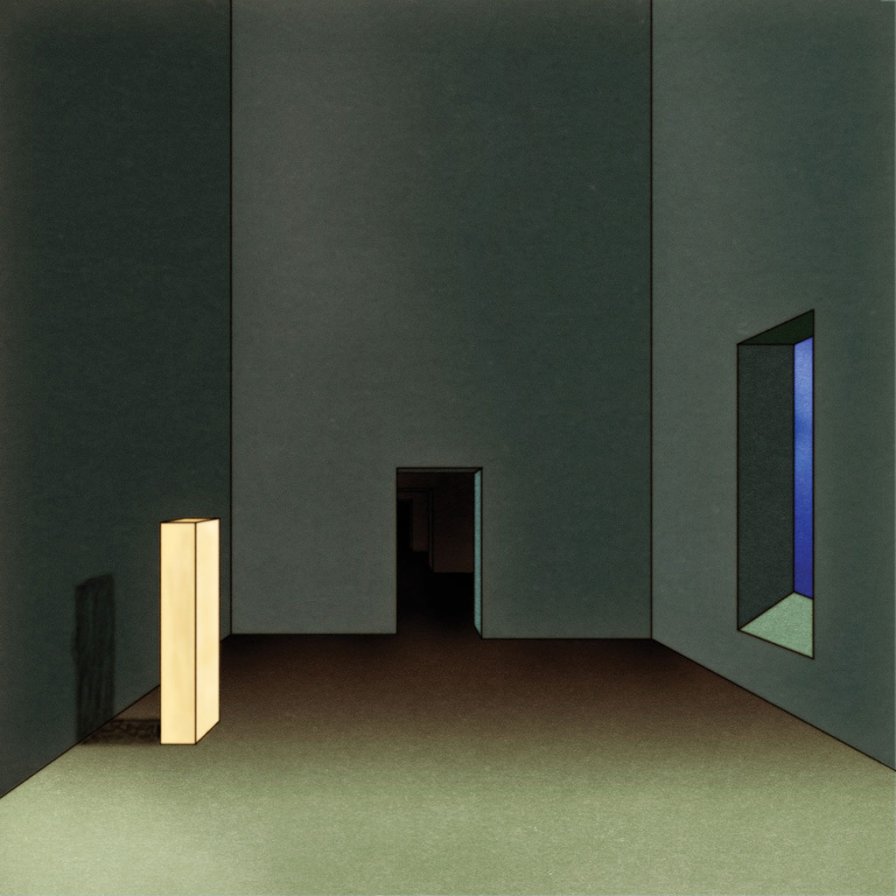
There are 10 pieces here which open up quite unexpected vistas of the richness of realistic effect that may be obtained with sound. Never, for example, has the northern daylight in our apartments been rendered with the realistic power contained in “Boring Angel.” Never has the seething life of the street, the teeming of the crowd on the asphalt and of vehicles on the roadway, the waving of the trees on the boulevard in dust and light, the elusiveness, the transience, the immediacy of movement been captured and fixed in all its prodigious fluidity as it is in the extraordinary and marvelous “Americans.” From a distance, this stream of life (“Inside World”), this great shimmering of light and shade (“Problem Areas”), spangled with brighter light and stronger shade (“Zebra”), must be saluted as a masterpiece. As you approach, everything vanishes; all that remains is an indecipherable chaos (“Chrome Country”). Clearly, this is not the ultimate statement of art in general, nor of this art in particular. But what a clarion call for those who have a subtle ear to hear, and how far it carries into the future!
These words, I admit, are not my own, but modified excerpts from a translation of “Le plein air, Exposition du boulevard des Capucines” by Ernest Chesneau, an 1874 review of the First Impressionist Exhibition. But this doesn’t make them any less true of R Plus Seven, Daniel Lopatin’s 21st-century “impressionist” masterpiece. It would be a fair interrogation that using words written over 100 years ago in a blurb about an album less than 10 years old is ahistorical, that it sours any profession that Lopatin is terribly revolutionary. But if Oneohtrix Point Never is as “intransigent” as Manet, as “dazzling” as Degas, as intimate as Renoir, it is not out of mere imitation; rather, without directly referencing anything (but recalling everything), OPN’s output this past decade incidentally shared with these early dissidents of form not a distinct goal, but a proclivity for capturing “Still Life” from unusual angles, shedding light, as it were, along forgotten windowsills, exposing that “sinister” beauty that lurks in every nook and cranny of our crappy lives like floating dust that only refraction can reveal.
Later on in Chesneau’s review, he worries that Manet has opened a door for “inept painters” and “laggards;” he warns that embracing this trend invites “the kiss of death.” People would later say similar things about vaporwave, about what Lopatin was doing with arpeggiators and sequencers and samples of infomercials, but it was R Plus Seven that exhibited what really made early critics of “Impressionism” wary of backing a new school: that is, what had emerged from realism’s ashes was threateningly beautiful, a phoenix that ignited our guilt-wracked hearts before rekindling itself inside us as awe. Its magnanimity enveloped us entirely, inspired bloated words and eccojams, and ultimately freed us all from criticism’s clammy, historicizing, pen-fondling hands. No wonder critics were scared of it. “And how far it carries into the future!” Even grander how it rendered time right off its bones. We would never be the same again.
06
Macintosh Plus
Floral Shoppe
[Beer on the Rug; 2011]

Very few records come to define a genre in the way that Floral Shoppe has. For many of us here at Tiny Mix Tapes, the first part of the decade was spent listening to and thinking about vaporwave. And in the years since its original release in December 2011, Floral Shoppe has steadily become the genre’s best-known document, vastly exceeding what any of us expected of it — of any vaporwave, in fact — even as we were championing it.
Floral Shoppe was nothing short of a phenomenon. By 2018, its most famous track “リサフランク420 / 現代のコンピュー” (“Lisa Frank 420 / Modern Computing”) had amassed more than 40 million views on YouTube before being removed, apparently at the request of Sony, owners of that famous Diana Ross sample. The track was quickly re-upped, of course, and is currently sitting on a cool 8 million. These are simply not the kinds of numbers normally achieved by experimental or underground artists. Nothing by James Ferraro, Oneohtrix Point Never, Holly Herndon, SOPHIE, Laurel Halo, or Mount Eerie — not even Burial — gets remotely close. Not on YouTube anyway.
What’s striking with hindsight is that when vaporwave “landed” in 2012, part of the attraction was the presumed impossibility of it ever going mainstream. Vaporwave, we said, was democratic at the level of production not reception. Because its appeal was always conceptual at least as much as it was sonic, because it relied so heavily on appropriation, because in the most radical cases it was in fact nothing but an act of appropriation (such that the comparisons with plunderphonics and other sample-based musics missed the mark), it just never seemed like the kind of genre that would attract much of an audience outside the communities making and writing about it.
How wrong we were. Floral Shoppe confounded expectations because it married vaporwave’s characteristic critical distance with a more direct sensual pleasure in a way that few others managed or attempted. Compared with Ramona Xavier’s other releases under the New Dreams Ltd. faux-corporate umbrella — as 情報デスクVIRTUAL, Laserdisc Visions, PrismCorp Virtual Enterprises, and Sacred Tapestry — Floral Shoppe was much easier on the ears. But there was a paradox here. Tracks like “ODYSSEUSこう岩寺「OUTDOOR MALL」” by 情報デスクVIRTUAL or “By Design” by INTERNET CLUB were so “easy on the ears” they were grotesque. In fact, the deeper vaporwave dredged muzak and easy listening’s frictionless depths — i.e., the less the artist-corporation revealed themselves at the level of production — the harder it seemed to listen, such that the critical work required to keep tuning in was always also a kind of masochism. Vaporwave’s pleasure was often perverse.
Not so with Floral Shoppe. The grooves it sampled — especially from Diana Ross, Sade and Pages’ “You Need a Hero” — were all undeniable. And when the record turned to the German smooth-jazz/synth duo Dancing Fantasy in its second half… well, it turns out that Dancing Fantasy were in fact pretty good! Whatever else she may be, Macintosh Plus was an impeccable (digital) crate-digger. And the production, light as it may be, is artful throughout. The artist is present. Unlike other artifacts from this era of vaporwave, this record always felt composed.
Floral Shoppe is not vaporwave’s most radical release. Even Xavier has sometimes questioned its disproportionate success. Like pop art or rave before it, one of vaporwave’s more important interventions was precisely to put into question both the cult of artistry that demands and is sustained by lists like this one and its complicity with the affective economies of capital. But these structures are desperately hard to dislodge, doomed to return like some pitched-down Diana Ross: “It’s all in your head / It’s all in your head,” looping back again and again, each time a little less stable, before finally breaking down altogether.
With the second iteration of 100%ElectroniCON already behind us and as the scene moves increasingly from URL to IRL, I can’t help but wonder whether vaporwave’s apparent success has depended on it becoming a “sound” or “style” in a way that betrays the more radical possibilities that seemed available on its arrival. Nevertheless, Floral Shoppe served as a metonym for and gateway into a genre that — from its design a e s t h e t i c to its queer/trans roots to its unexpected and much-contested forking into genres like fashwave and trumpwave — proved surprisingly resilient across the decade and continues to defy expectations.
05
DJ Rashad
Just A Taste Vol. 1
[Ghettophiles; 2011]

Bear with me [one last time]: Mr P once told me that Mortal Kombat II helped him discover the internet, because of

SMASH CUT TO 1994,,,,
,,,,And it’s Keith’s ninth birthday at Putt Putt Golf. Unlimited arcade tokens in an infinite screen-to-game ratio. Mortal Kombat II popping off in the back corner. Enter: a new eternal battle of life.



The precedent DJ Rashad set in Just A Taste Vol. 1 started a whole new battle.
Everything Mr P wrote about DJ Rashad became literature. And in my Fusion, I chose to boil it all down to Just A Taste Vol. 1. This was a new war zone for listening.
Most times, footwork after Just A Taste Vol. 1 felt like imitations. Few times, footwork after Just A Taste Vol. 1 matched various bits of it, but never in total. At best, Rashad’s footwork post-Just A Taste Vol. 1 was doing his best LucasArts impression: reworking the masterpieces for international audiences.
But Just A Taste Vol. 1 was the genesis to this decade’s evolution of recorded footwork, and listeners couldn’t help but Pledge all floors, buffing ‘em with a pair of fresh socks
You’ve no idea what Mr P has to go through to edit my content for this website [editor’s note: here’s just a taste]. I only try to be THE most extra in my TMT posts, because I compete with Mr P. Whether I was trying to out-weird, out-extra, or out-genre him in content, Just A Taste Vol. 1 was the initial adrenaline rush that he provided (in writing and recommendation of flavor) that made me go all out. All this content
website [editor’s note: here’s just a taste]. I only try to be THE most extra in my TMT posts, because I compete with Mr P. Whether I was trying to out-weird, out-extra, or out-genre him in content, Just A Taste Vol. 1 was the initial adrenaline rush that he provided (in writing and recommendation of flavor) that made me go all out. All this content  has always just been a silly afterthought of who can waste more time in their life. Or secret letters of admiration. Or testing Mr P with literal nonsense I deem intentional. I am eternally in battle with Mr P because of Just A Taste Vol. 1.
has always just been a silly afterthought of who can waste more time in their life. Or secret letters of admiration. Or testing Mr P with literal nonsense I deem intentional. I am eternally in battle with Mr P because of Just A Taste Vol. 1.
DJ Rashad set an expectation for nearly all electronic music in the past 10 years when Just A Taste Vol. 1 was released. Footwork found life outside Chicago. Club music expanded, vibrantly. Sound collage became rhythmically glitched. The line between DJ and producer continued to blur. DJ Rashad planted seeds this decade that haven’t even begun to sprout. The hybrid continues to mix genomes with Just A Taste Vol. 1.
04
SOPHIE
OIL OF EVERY PEARL’S UN-INSIDES
[Future Classic; 2018]

We exist under a regime that forgets — because it’s afraid of — the flesh. Under this regime, human bodies are assemblages of symbols that fit together & interrelate not unlike the component parts of a machine. Indeed, they’re subjects in a system of normative biopolitical imperatives — quite often enshrined in the Law — which would conduct conduct to maximize the productivity of our bodies. It’s not just self-help books & motivational speakers; these are just symptoms of a discourse that alienates us from our bodies, constructing the human as above & beyond nature.

Within this discourse, each appendage fulfills a particular role, often determined by one’s gender assigned at birth. HEAD represents reason, which sets us apart from “nature” (i.e., the non-human) & is seen as the epicenter of the human being; it’s no coincidence that reason is constructed as the domain of men. HANDS are the conduit through which we effect action out in the world, reflecting a narrow understanding of “action” in terms of work, which is masculinized by the representation of physical power in the fist. HEART, of course, hosts the human capacity for Love, yet is often seen as encumbrance rather than asset, despite our extreme altruism underwriting assertions of human exceptionalism — a conception surely buttressed by misogynistic tropes of women overly moved by emotions.
Strangely, it’s the genitals — repositories of sexuality & desire — that determine how hegemonic discourse imagines & constructs the rest of the body. In a discursive sense, the genitals are the appendages nearest to the flesh; sexual desire, indifferent to the attributes that make us human, “grounds” us through its reverence to the flesh, namely via the “private parts,” which, in fact, cast quite a wide shadow over the public sphere. Hence, the regime’s fear of the flesh ultimately zeroes in & flares around the genitals, through which the flesh draws attention to itself, abating the distinct attributes of our “humanity” & undoing the estrangement from the flesh that enables the regime to optimize the body & maximize productivity. Sexual repression is therefore the regime’s way to escape that to which we are inevitably drawn back.
Here we arrive at the threat of the queer body, which doesn’t choose the object of its desire or identify according to the dichotomies of the regime’s imposition. Of course, it’s no coincidence that queerphobic voices constantly assert that sexual expression is a choice; that is, that reason can trump it. Because, as far as the regime is concerned, the queer body is a terrifying example of the failure of reason, of the “human” succumbing to the flesh, to animality, to nature.
Among many, many other things, OIL OF EVERY PEARL’S UN-INSIDES was a celebration of the flesh, which the regime ensures remains for the queer person a significant source of dysphoria. Even further, it was a reclamation of the body & its doings. SOPHIE was preoccupied not only with the desires of the flesh — although that was in there (“Ponyboy”) — but with the possibility of its deconstruction & reassembly (“Faceshopping,” “Immaterial”). Not to mention, by pairing her subversive discourse with production that shifted between industrial plasticity & bubblegum pop, SOPHIE disaggregated the correlations of strength-masculinity & frivolity-femininity. If the regime sought to conduct conduct, SOPHIE’s was an exercise in misconduct. Which is to say that, this decade, SOPHIE was the regime’s worst nightmare.
03
Kanye West
Yeezus
[Def Jam/Roc-A-Fella; 2013]
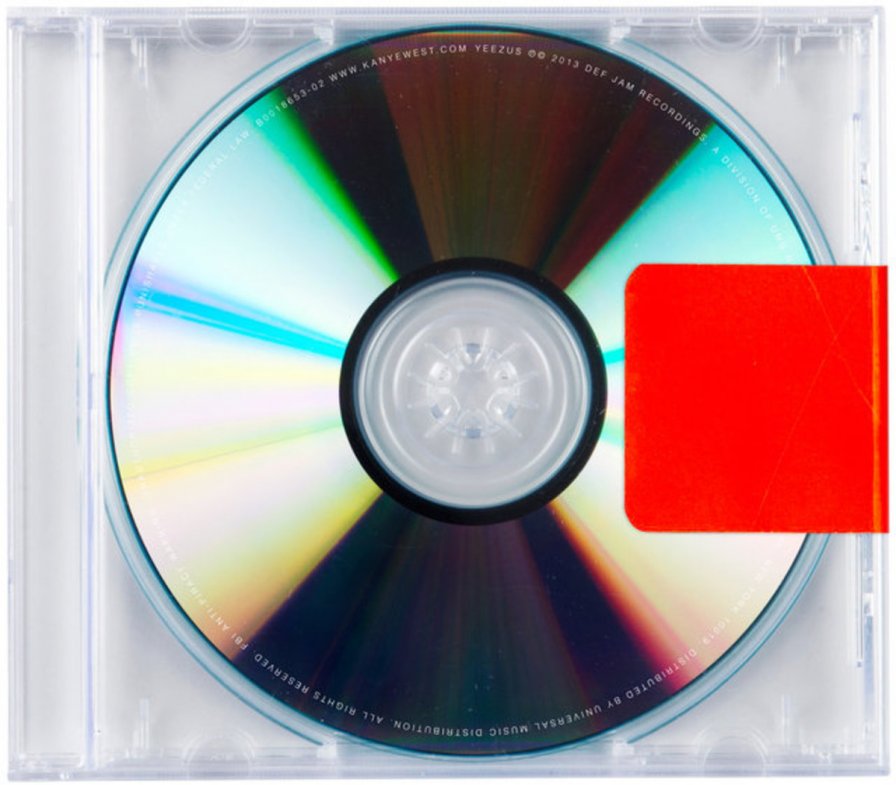
Uh-huh, honey. In its own particular way, Yeezus was where the decade in Kanye began and ended. It zeroed the opacity and goodwill generated by My Beautiful Dark Twisted Fantasy, clearing the site for every last provocation that would follow hereafter; it was built on the scaffolding of former glories (most notably the urges and inclinations of Cruel Summer), before being gradually torn down bit by bit, as Ye turned his iconoclastic tendencies upon himself and his image. To be sure, even as we spent good chunks of the decade in adoration, revulsion, or downright indifference toward Kanye West, Yeezus was evidently one of the shining beacons of the 2010s according to Tiny Mix Tapes. Both upon its release and in our present moment(s), it felt, still feels, like a particularly enigmatic entry in the catalog of one of popular music’s most prominent enigmas, Bound up as it was in second guesses and internal logics. And yet, it truly stood apart in Kanye’s oeuvre in its total commitment to transparency and in its clarity of vision; a forthcoming, completely airtight expression of intent that now stands as the prism through which his life and work is best examined.
Really, Yeezus has heretofore said all it has needed to say of itself. We can safely presume the relatively quick turnaround in its recording, including some 11th-hour tinkering by Rick Rubin, as well as its austere palette pace the luxurious MBDTF, because that’s what it sounded like: triumphantly, pointedly minimal in its construction, engineered for a fullness of affect in a heartless world; the sui generis anti-masterpiece, encased in a plastic outer that featured little more than a lone, dispassionate red square for identification. On the mic, Ye was alternately on acerbic form — not deigning to niceties (certainly not to basic decency), not cowing to the overbearing arm of corporate America — and in a more measured, lucid mode; a kenotic God pared down to his rawest base instincts. This was hardly the first time Kanye had given himself pause, but the tussle with himself and/or his demons was more pronounced than ever on Yeezus, a monster that would come alive again, again, and again throughout the slippage of the decade. Moreover, it exposed the dangers and pitfalls of projecting an entire philosophico-politico worldview onto the biggest rock star on the planet, a purported billionaire no less; this isn’t to disavow both the latent and overt politicking on the album, given Kanye’s continued commitment to social justice, but rather to highlight the Void at the heart of culture, of celebrity, and of capital, a Void that Yeezus bore full witness to. If Kanye sounded at the peak of his powers here, it was patently lonely at the top.
Oh, yeah, the music. One could write entire paragraphs, theses even, dissecting every last skree and skronk between the beats (or lack thereof) that make up the architecture of Yeezus. From that initial blast of distorted warehouse acid, right through to the stark, unvarnished sampling from No I.D. that closed proceedings, the album operated with a contrarian logic that nevertheless excited and reviled; it really did “pop a wheelie on the zeitgeist,” so much so that no other major label rapper dared to make a return to its indignant pith. It was a melting pot — of voices, statures, and sonics — that gave Ye the munitions to craft some extraordinarily memorable (read: memeable) set-pieces. Isolated flashes of brilliance include: the gospel flip that punctured “On Sight,” the Malefic-in-a-coffin screaming and gasping in the Justin Vernon-featuring coda of “I Am A God,” and “Guilt Trip’s” effervescent synth work, wafting atop hollowed-out kits and terse sub-bass, to reductively pick out but a few. Elsewhere, entire tracks stole the show, as Kanye cornered sports advertising forevermore with a genuine anthem (“Black Skinhead”), desecrated “Strange Fruit” by way of TNGHT histrionics (“Blood on the Leaves”), and best approximated what Tricia Rose or Robert Beckford term “Black noise” in utterly indomitable style and phrase (“New Slaves”).
The devil, whose apparition apparently defined and informed an entire life’s work until very recently (“I been workin’ for ya my whole life”), was well and truly in the stitching of Yeezus. It seemed, for example, more than coincidental that Yeezy’s auto-tuned voice was typically preserved for his most cogent interrogations of Self, as on “Blood on the Leaves” and “Guilt Trip,” as if he could only humanize himself by way of effect and affect. A number of years, cold(est) winters, countless listens down the line from the 256kbps leak that still resides on my iTunes, and Yeezus can only continue to delight, to intrigue. Kanye West rarely made overtures to anyone or anything in the 2010s, but this was one of them: a properly beautiful, dark, and twisted fantasy that convulsed between our fried synapses and rattled us to the core; the zenith of a stratospheric career, the twilight of Kanye’s fading star.
02
Dean Blunt and Inga Copeland
Black Is Beautiful
[Hyperdub; 2012]

Black Is Beautiful, one of a few crests in the imposing Hype Williams wave of the 2010s, was recorded and released in a year of uncertain but likely apocalypse, and when held together in the mind on a list like this, it still judders and quakes with the possibility. Somewhere between career culmination and business as usual, Dean and Inga and co.’s final major offering maintained their day 1 promise of a certain form of honesty-if-nothing-else (a bizarre claim from such skilled and relentless mythmakers, but for fans of the group the very essence of what could be delivered), this time possessing a strangely charged sense of purpose, a series of movements in crisis that squeezed into any number of musical molds of the day while only ever sounding like themselves — whatever that was — “in-betweenness” somehow honed to a fine point.
The obvious stunners were the result of a locked-in and keyed-up pop sensibility in full flower, production miracles made more so in their permanent “demo” form, but the rest of the album could almost be tasted with enough concentration — interludes that reintroduced themselves on repeat listens as main tracks, exploratory and unpredictable to the very next note even as they traced the edge of recognizability; melodies so curious that the instruments producing them quickly slid out of mental view, only sub-bass and sensation left in deep (red) focus. There was a constant profundity to it all, even sometimes a profound stupidity (try to make it through “14’s” chicken-dance dead end with a straight face). Fairly new genres developments were “played,” like they’d already been drained by time, now just rows of atmospheres to rent and remodel. “History [was] inhaled and exhaled,” more than an accretion of what came before, neither in thrall to the past nor ignorant of its lasting afterimage, only a generously employed soft focus keeping everything from turning upside down.
Much has been made of Dean and Inga’s endless trapdoors and obfuscation; not nearly enough has been written about the rarity of their work ethic, their real-time risk-taking, their determination not to close themselves off from the world. In doing so, they commanded an unmatched emotionalism and intuition, fostering a kind of dignity in chaos. That music like Black Is Beautiful exists at all is a serious blessing.
01 (∞)
Chuck Person
Chuck Person’s Eccojams Vol. 1
[The Curatorial Club; 2010]
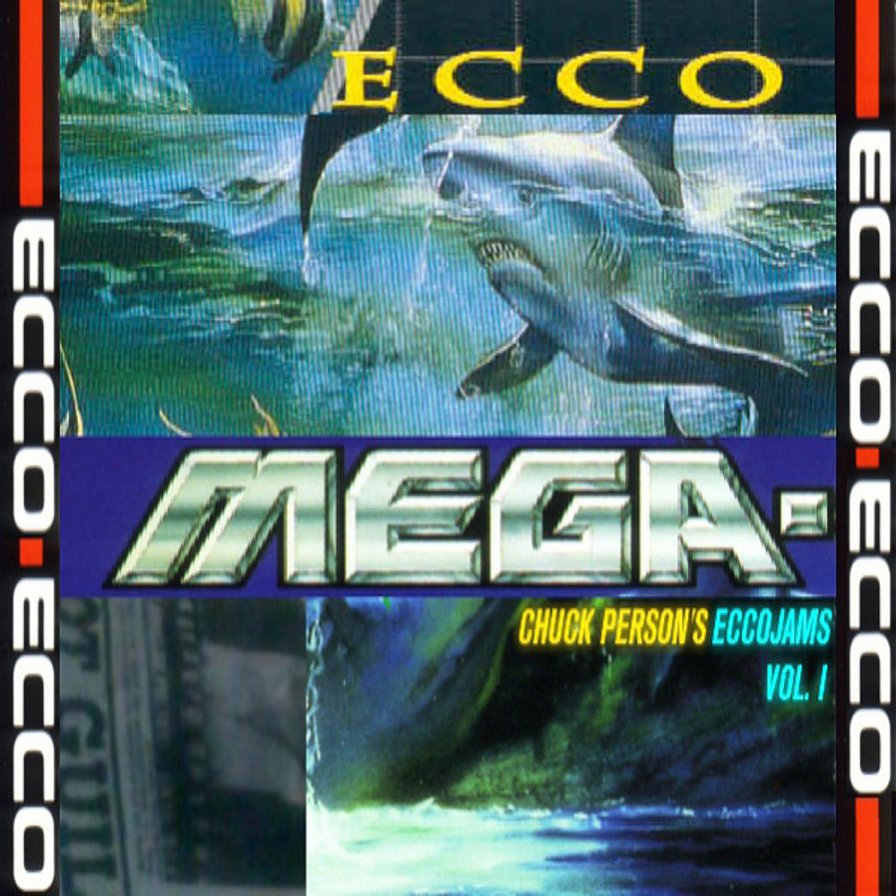
Last night, I dreamed I made the perfect eccojam. You were there, and you were there, and you were there, and you, and you, and you were there, and you were there, and you, and you, and you were there, and you were there too.
What were your favorite 50-(something) minutes of the decade?
It took a long time to get here, a lot of scrolling, at least. And after 10 years, we’re finally wise enough to make the wrong pick for our favorite release of the decade. A pick that could melt in the sun if you left it out on the passenger seat. Can you smile about it? Nod knowingly, maybe, happy. Or yawn. Did this wave crash predictably?
I believe The Caretaker or DJ Rashad or Grouper or Laurel Halo could very easily occupy this position, though I can hear in Eccojams variations of each of these artists’ adaptations to the physical constraints of time. I also believe our staff wishlist of personal favorites from the 2010s might’ve (and should’ve) effectively made this choice obsolete! But it’s a choice “we” made, and it’s one I believe in, like I believe in ghosts.
“Be real, it doesn’t matter anyway/ No, it’s just too little, too late/ Be real, it doesn’t matter anyway/ No, it’s just too little, too late”
In some respects, this list meant nothing. In others, it meant the world, to the community behind Tiny Mix Tapes, to me personally, and hopefully to you.
I believe Chuck Person’s Eccojams Vol. 1 is our #1 not because nostalgia won our decade, whether reflective or restorative. We did not spend our decade drowning in the deeps of our miserable desire for endless summer nights and the eternal loop (for nothing). We haven’t all of a sudden been gifted a deeper appreciation for the afterglowing lineage of the Eccojams limited cassette release, its belonging to the purer internet, or even the premature and constant death of vaporwave.
I believe Eccojams is our #1 because we at Tiny Mix Tapes couldn’t get enough of music. And Eccojams, of music, begat more music.
Made music in us, made us make music.
Made us listen better. With every Pang and its Mutant child of rage, every mixtape sequel, every deleted SoundCloud track, every Liz Harris moniker, Instagram story snippets, Dean Blunt — through music, we learned how to love this decade.
How much of that time was spent wandering the internet? It’s hard to imagine wanderlust about the frontier internet anymore; it has been so assumed into everyday life as to make that observation null, but in 2010, when Eccojams was released, there was a little more magnetism in the links, before torrents trickled into streams, maybe a searching that had been a little less, say, streamlined for easy listening.
And so a reworking of easy-listening pop music sounded a special kind of project, not quite They Live glasses, but at least a message in a bottle: “Hey, listen!”
The most popular “lo-fi beats” background-listening livestream’s artwork is a swipe from Whisper of the Heart, one of my favorite movies, its original title literally translated as, “If you listen closely.”
Maybe Eccojams was our favorite because we wanted to save it from interpretation that would reduce it to the one reading — the understanding that it was a performatively unflattering and grotesque reflection of broken culture. We’d heard more than that. We heard in it instructions, lesson plans, accidents, tools, and effects. We heard a hundred different ways to say the same thing, a thousand ways to listen. As much as Eccojams was about casting a revelatory light on the material circumstances of this decade, it was also about our audition: our fidelity to hearing. To listening, which is the beginning of community, of creation.
“Did you make this?”
If you weren’t paying attention, or toiling away on something else, you could mistake anyone’s eccojam for one of Chuck Person’s. The creative process was an algorithm, the Swedish directions for a remembering-machine. It wasn’t a genre of classical nuance; it was about tapping into a feeling, drawing from your own archive, laying bare the beautiful abundance of your “hidden resources.” Like folk music.
In a Reddit AMA, Lopatin referred to eccojams as folk music, and in doing so suggested a hybridization of the polar organizations of composition laid out in Brian Eno’s “Generating and Organizing Variety in the Arts.” Eno references the “hidden resource” of folk music, which are the valuable idiosyncrasies of the individual performer, as compared to some classical music’s more rigid commitment to algorithmic formality that bows to hierarchical value systems.
Eccojams were a charged program, then, in their strict/open process: run a looped sample of radio music through a simple filter. The contradiction was how this rigidity transformed our ability to appreciate the smallest moments of MOR songs, make them as unnerving or thrilling as laying in the middle of the road. There was more than you thought possible, and now nothing felt impossible.
Ultimately, we arrived at the not-always-forgone conclusion that “changing environments require adaptive organisms.” Another not-always-foregone conclusion: if you find yourself overly dependent on a coping mechanism, it must not be working well enough anymore.
This was a decade that pressured us to play it cool and/or self-manifest as Homo superior. Nowhere could this desperate adaptation be seen like it was in memes. By virtue of its archive and fried architecture, Eccojams became the premier musical representative for meme culture — stacking levels of awareness, repetition as the medium, the message unfolding forever, like the scroll of The Caretaker, an edited collage of Pablo, a language of infinite collaborative possibilities, of mutually unknowing interconnectivity via parasitic networks, self-modifying code, and lairs of referential knowledge — all drawing from the most popular well, the well of loneliness.
And so, vaporwave was a genre and an internet meme. Chuck Person wasn’t a sole author.
“Where’d you get that information from (from)?/ Where’d you get that information from (from)?”
Before Eccojams, there was sunsetcorp, Daniel Lopatin’s YouTube channel channeling YouTube surfing, which included the best-ever eccojam, “END OF LIFE ENTERTAINMENT SCENARIO #1,” to be found nowhere and everywhere on this release. These media meditations prefigured the more unsigned emotional rummaging of Replica, which was our favorite album of 2011. Yet there was even more to love here, in Eccojams, maybe because it seemed to be made with us in mind, the way a friend who’s only a couple steps ahead of you can recommend affordable therapy, or provide a listening ear. What a gift, to be able to let go of what doesn’t work, and to hear something that does.
What are some songs that you love, that you could share with your friends? What makes you want to make an eccojam? What are some things you don’t like about eccojams?
These were labors of love, tracing the footsteps of the Screwtapes. As in DJ Screw’s chopped-and-screwed mixes, there was the idea that these song choices might be invitationals, appeals to recognition that get you thinking of the potential in songs, your own potential. That Daniel Lopatin modeled Eccojams, and indeed took his moniker, after a soft-rock radio station, Magic 106.7, speaks to his sentimental attachment to this music. Realizing this project is about channeling a connection to the radio, that this is not only a restaging of cultural detritus to reflect the heartbroken smoothness of capital and mass culture, meant the world to me, and I think you could hear it all along.
Chuck Person was a sincere YouTube commenter from 2012, an avatar that revoked the “supremacy of the original over the derived,” to invoke Adorno’s precious contempt for the impossibility of genuineness, writing about bourgeois moral gold. This love opened the door to so many possibilities for the derivative, the incidental, the illegitimate, the usurpers. I believe these songs could wear their bent-edge color Xerox unoriginality on their sleeves without hating themselves, without being statement pieces, perhaps just posing in front of the mirror, wearing themselves out like makeup or magnetic tape. Feeling themselves.
It’s not mere critique, it’s a love letter. It’s so head over heels, it repeats itself.
Like history. Getting not funny: a man who has somehow managed to corrupt the grossest seat ever, utter ecological catastrophe, multibillionaire space races, police-state terrorism — it’s the same Billy Joel or New Radicals or whoever song — echoes and continuities of crises from decades past, no less important or crucial. In fact, with increasing, additive importance, we’re in crisis mode — indeed, a crisis ordinary. It would be easier and not unsurprising to seek refuge in exhaustion, nostalgia, denial.
We looked at the brokenness of the decade, itself a post in a feed, though riven by towering fixtures and ideological fixity, and we heard the relentless, un-unchanging repetition of Eccojams and couldn’t help but remember, in the words of Marvin Lin (our Mr P), writing on Eccojams for 33⅓, that “nothing is truly fixed and everything is ripe for transformation.”
We heard a tension for the decade: the radical possibilities of the ever-unfolding and rapturously enfolding loop, and the conservative impulse to hole up in exactly what we already knew we loved and preserve it forever at any cost.
“I (I) know (know) that (that) door (door)/ That shuts (shuts) just (just) before (before)”
When I was at my worst, I loved riding out the spins. The looping of Eccojams made sense, in the way ad nauseum and ad infinitum could feel part and parcel of going in and going out and going in and going out.
It was Eccojams that I stuck my head in, and it was eccojams that pulled me through. In the lamentable years (years of my life, years of this decade) that I spent alienating myself from those I loved most with my drinking, I could at least attach myself to the feeling of memory, of missed connections, of another chance — somewhere on the horizon was the sunrise, where my salvation lied, at the edge of tomorrow.
It was Zech who introduced me to OPN (then pronounced, “Own-ee-oh-trix”) and Eric Copeland and Brahms and all manner of other shit, and it was in his room where we would just sit and listen. And drink, yes, with abandon. His bedroom had a door in each of its four walls, one to the kitchen, one to the bathroom, one to his roommate’s, and one to the street. I spent many nights trying to convince him how if you stood at the center of the room and spun 90 degrees repeatedly, you would be faced with the exact same wall at each turn. Over and over. I was not listening to myself. I was obviously not paying close enough attention. But I hoped he would get the gist. It was Zech who told me to get a grip.
Advice for the young at heart, soon you will be older.
When not much else obviously presented itself as an option, eccojams were a coping mechanism with few moving parts, little mystery, yet somehow still full of little mysteries.
Like years later. Years after throwing up on Zech’s floor and falling asleep in doorways, waking up in a hospital hallway the morning after my patron saint’s holiday, only to be told I wasn’t the only one, hours after I’d been listening to “Only One.”
A salve for the repetition of addiction found in the repetition of loops, these loops I made not only out of self-destructive habit, but prayerfully, with half-empty optimism, for my own ears, for no good reason. Eventually, I started listening. Actively listening.
Daniel Lopatin was a good teacher, in this sense, thanks to humility. Before the worldbuilding and world premieres, when he was clothed in Chuck Person, there was an intentional practice, founded in the belief that rudimentary tools and a simple ritual could create cosmopoetic compossibilities for listening, which instilled in us at Tiny Mix Tapes the belief that these fucked-up little songs could become gateways.
Door to another, door to another, door to another, door to another, door to another.
As soon as you’re listening for the echoing words in between, listening to “B1,” when that parenthetical turns into a portal, you find the door in the back of the wardrobe, and there you find not yourself, but yourself-listening for the sweet relief of that bass swell, the cooing hum that reliably zooms into the mix before “never,” the softly winding pan-synth that uncoils around “proud” — artificially bound by your relation to the music, into presence.
In the presence of each other, we found no stickier drama than the planetary entanglement of our relationships, coincidentally or however bound we found each other in the tidal-locked orbit of Tiny Mix Tapes, where we had your readership, and more and more writers who weren’t writers, but historians and web designers and teachers and parents and students and friends.
Our listening brought us closer together, into the belief that through listening and the music itself, we wouldn’t achieve actualization or revolution, but that if we listened closely, we would become unafraid and nothing would be unthinkable. Maybe we’d be sensitized to the possibility of each release, remembering that just about anything could make us exclaim, EUREKA! And then we’d repeat ourselves, listening for the call and response of our love, the deep in me calling the deep in you, Side A, Side B.
We learned a lot from a few seconds of that song, Kate Bush and Peter Gabriel, now nothing more or less than Chuck Person, a mantra and a close read, a wave of sound crashing whatever meaning was transmitted, now transmuted into the choppiness of the sea itself, like the water covers the ocean.
So Eccojams is a stand-in, for everyone and everything, the memories that looped in your head, the memories you wish did, the songs you dreamed of making, the times and time you wish you had.
A part of me wanted to write this whole thing without mentioning Daniel Lopatin at all. This release belongs, after all, to YouTube uploaders, Audacity users, and Chuck Person: carelessly thrown together, a cut of meat used for stewing, an individual, one of the triune components of God.
No goodbyes, no goodbyes, just hellos, just hellos.
In the fade-out song on Eccojams Side B, a resplendently remade loop of “Woman In Chains” by Tears For Fears, the shimmer (a freaky chorus effect, I think) keeps approaching and receding over the sample, never not there in the mix, until it overtakes the words, transforming the song and the tape into the glow. The loop opens up into a slow fadeout that transitions into your life’s sounds (as long as you turn off autoplay).
In the last song, maybe you felt the rush of recognition, or maybe you felt held by the sureness of the synth returning again and again, and, if the song connected, if Chuck Person echoed your feelings, you heard your heart beating.
We couldn’t have made it this decade without you. I believe that’s why Eccojams is our favorite.
Our favorite music release of the decade is something you could’ve made.
We are celebrating the end of the decade through lists, essays, and mixes. Join us as we explore the music that helped define the decade for us. More from this series
